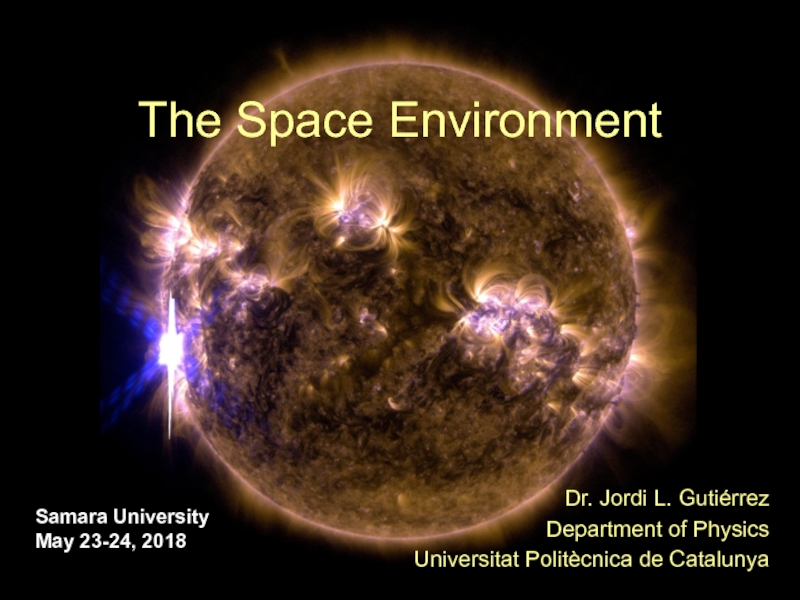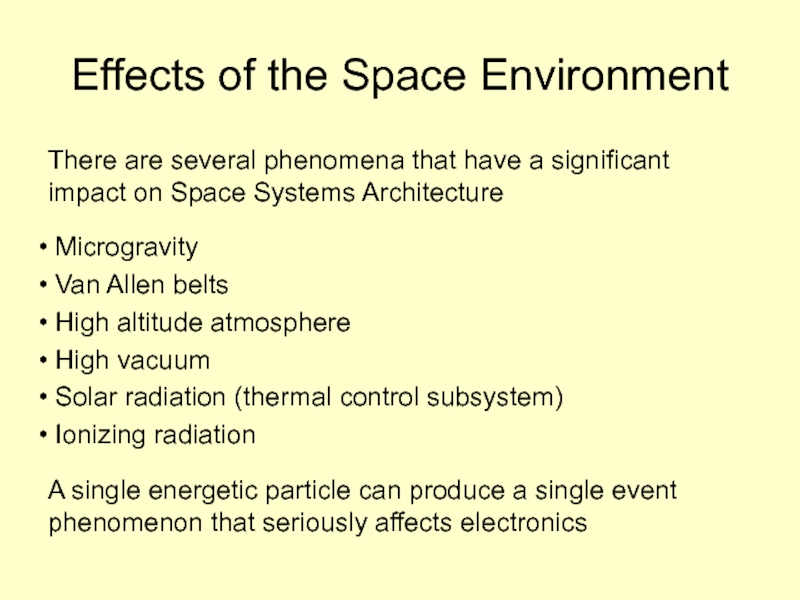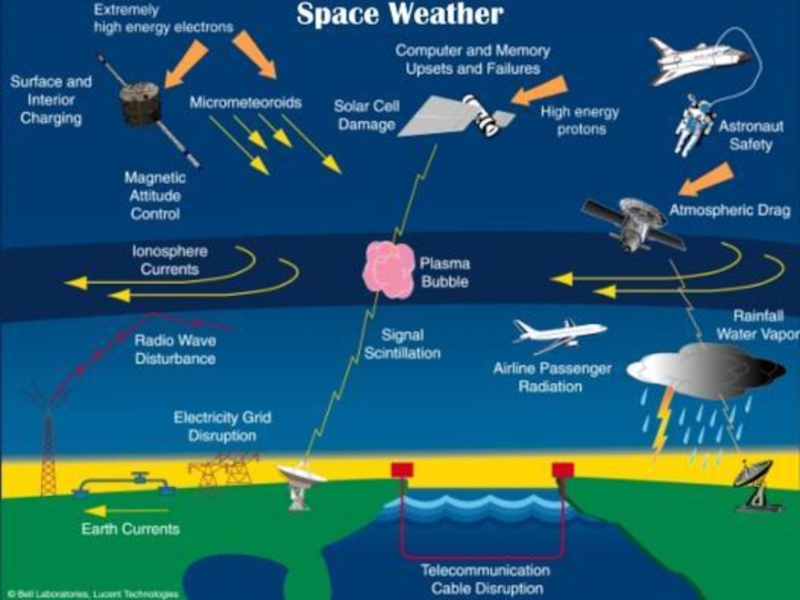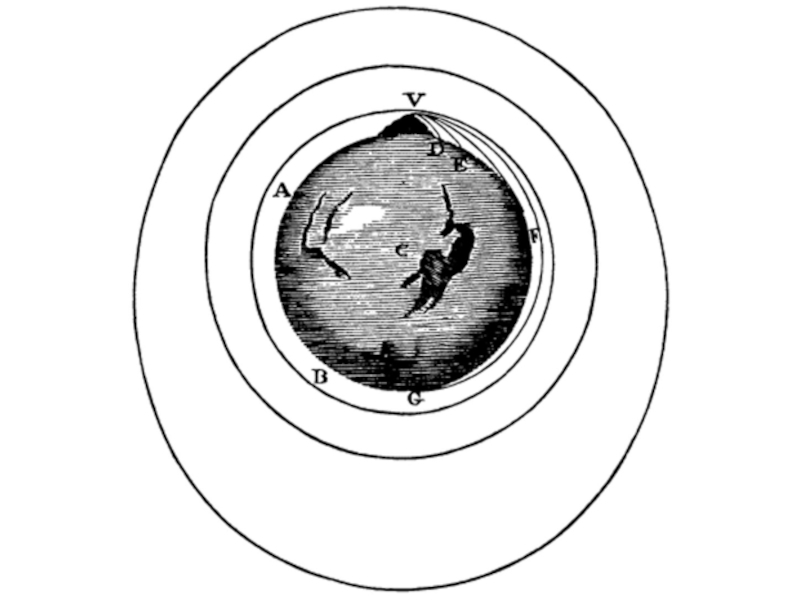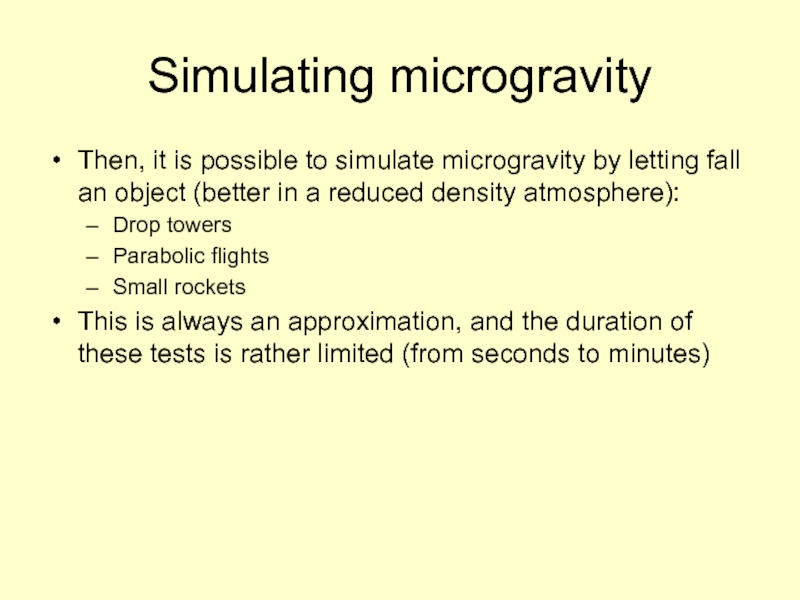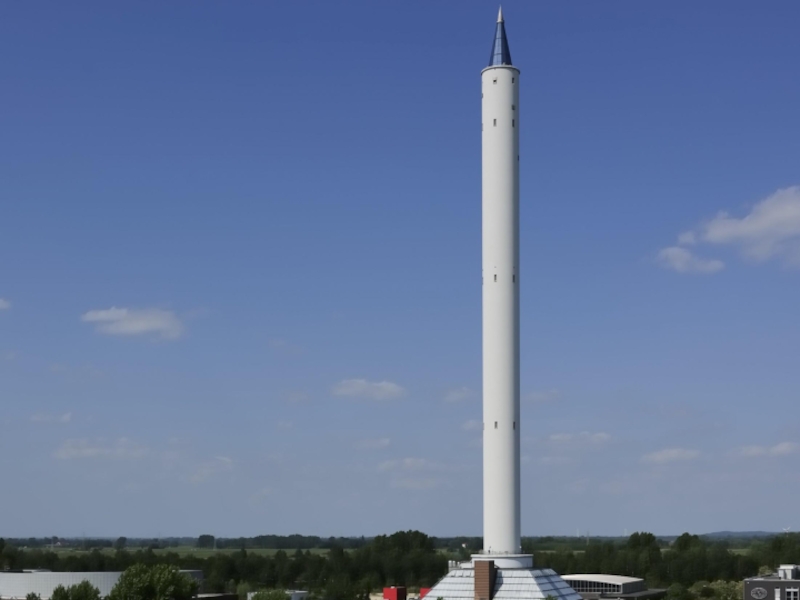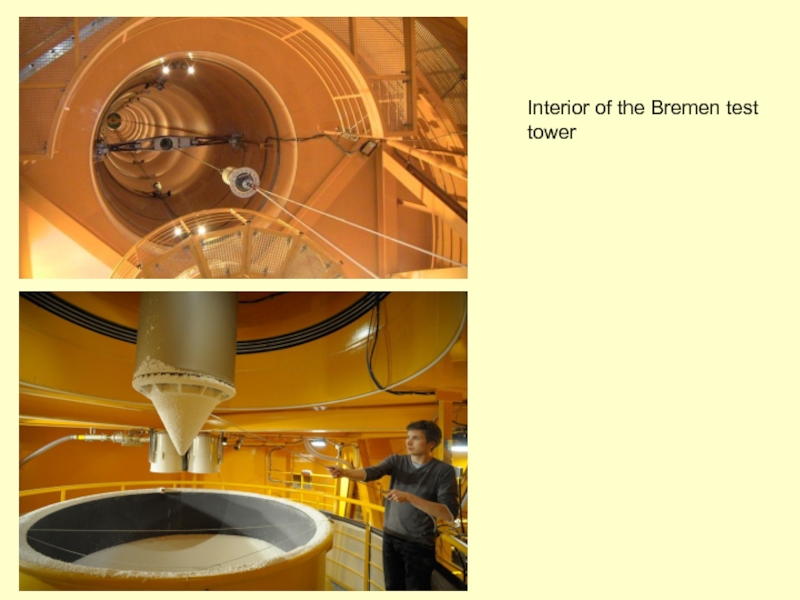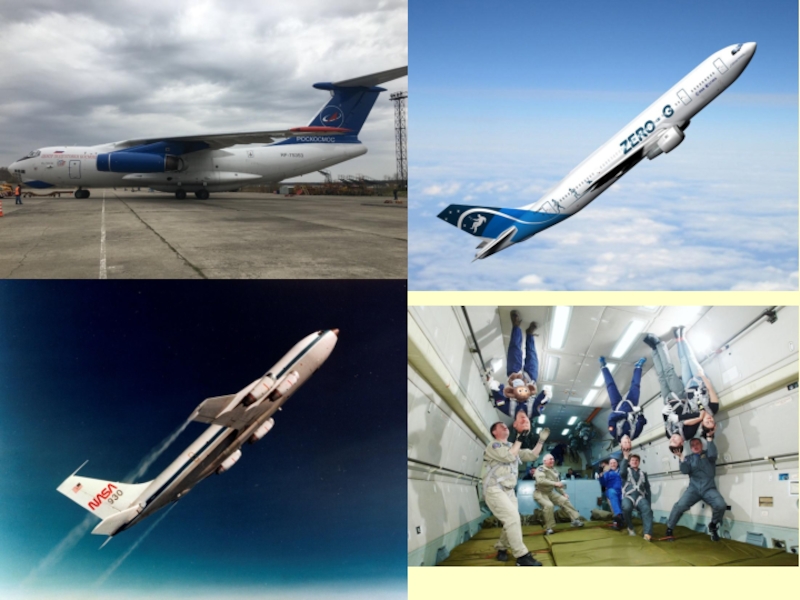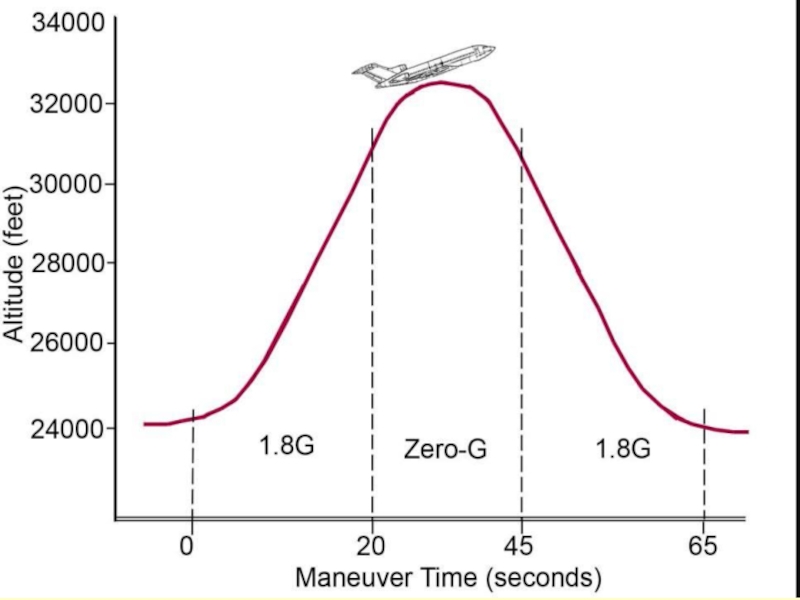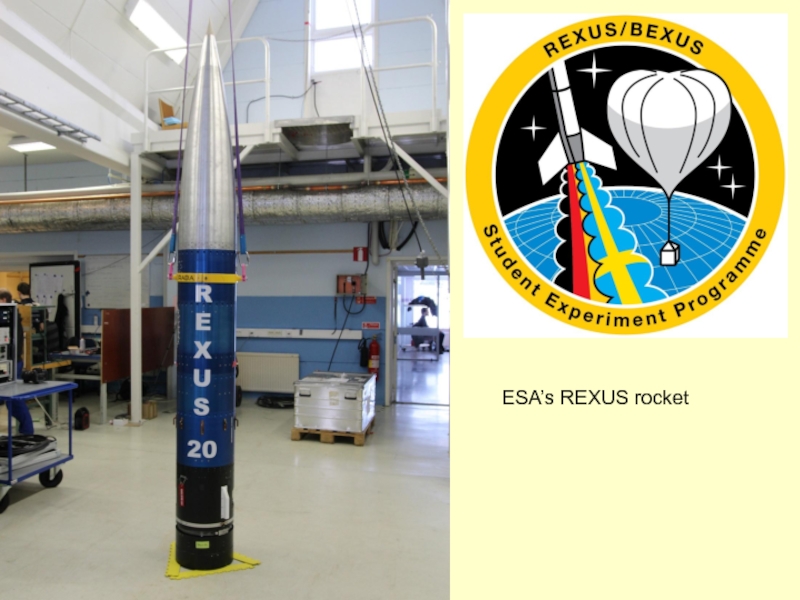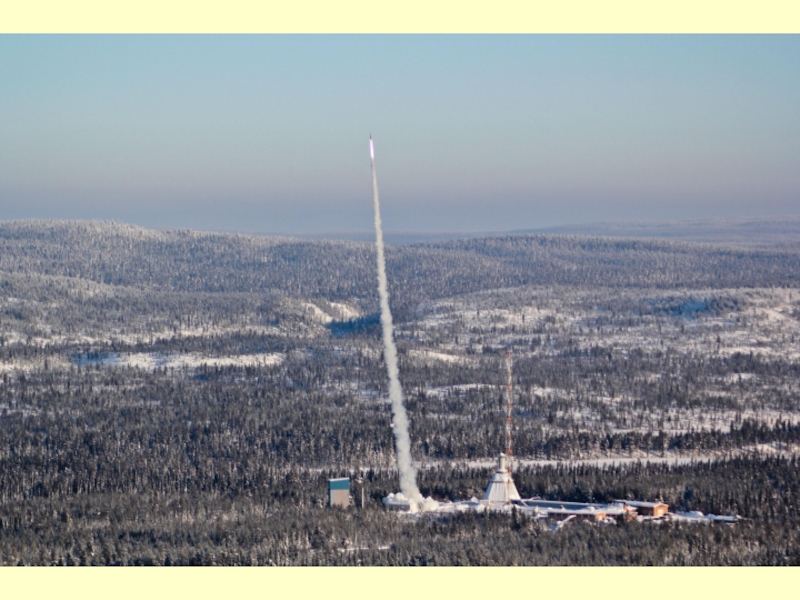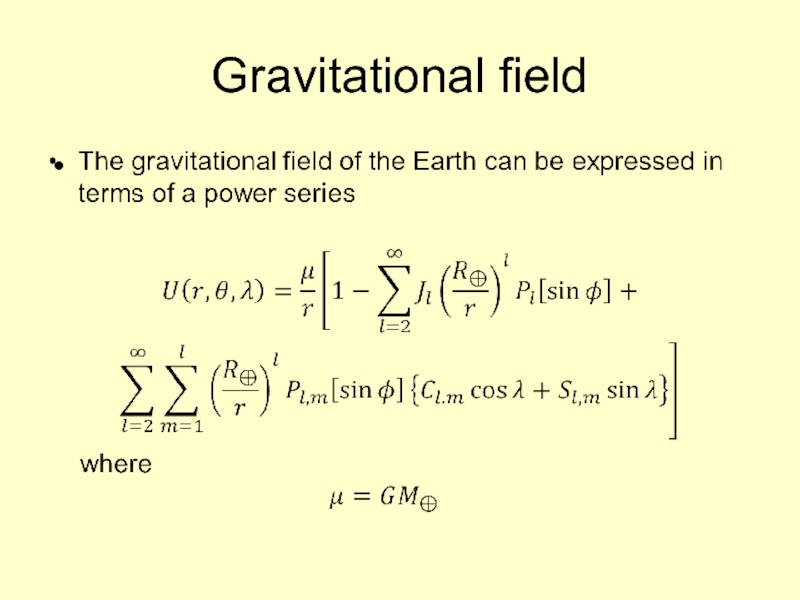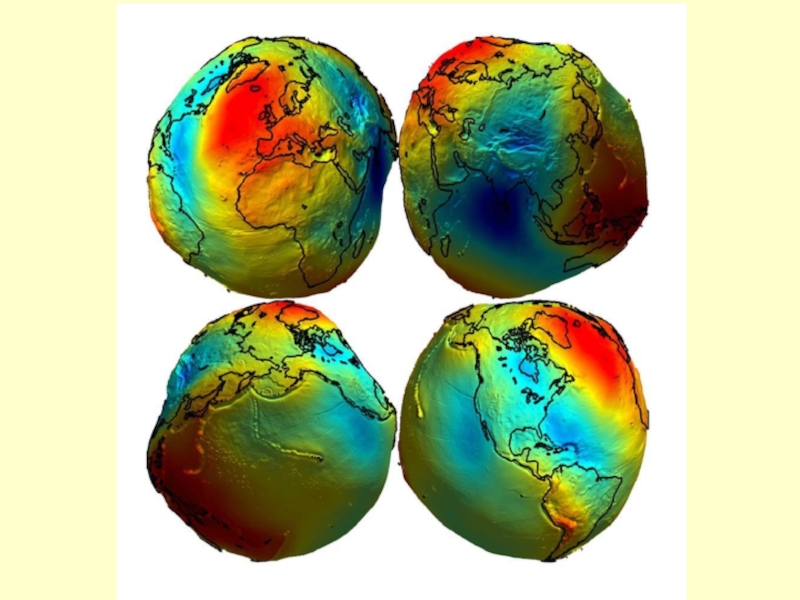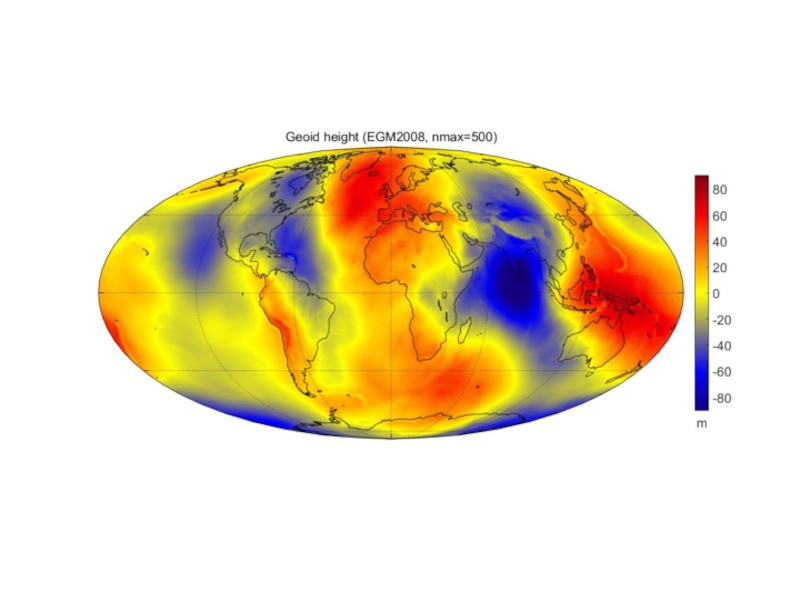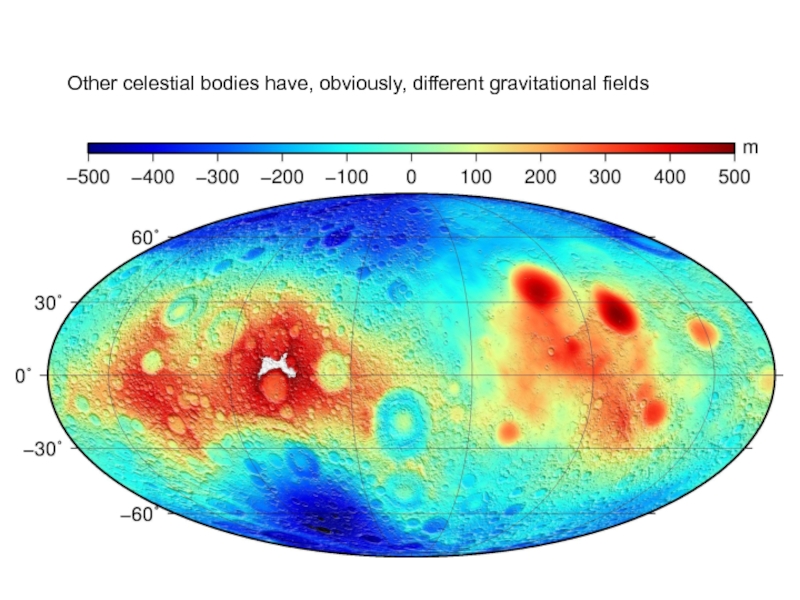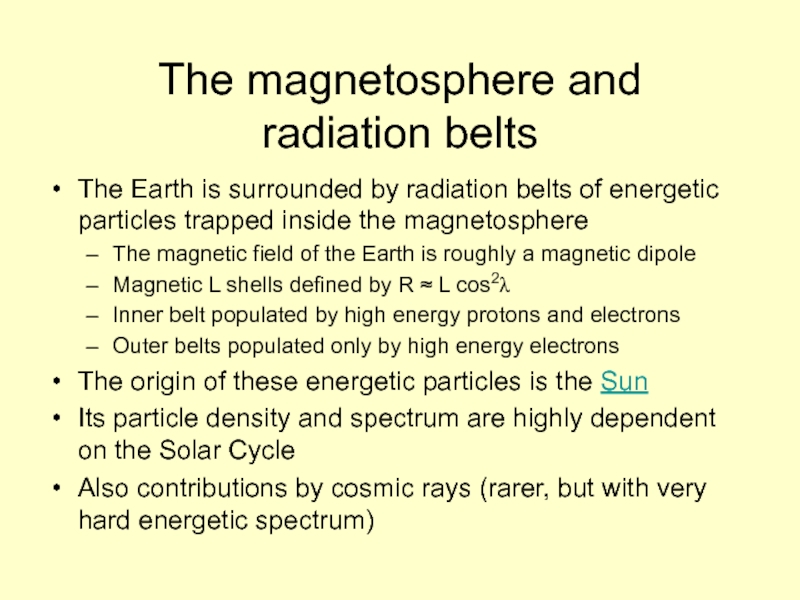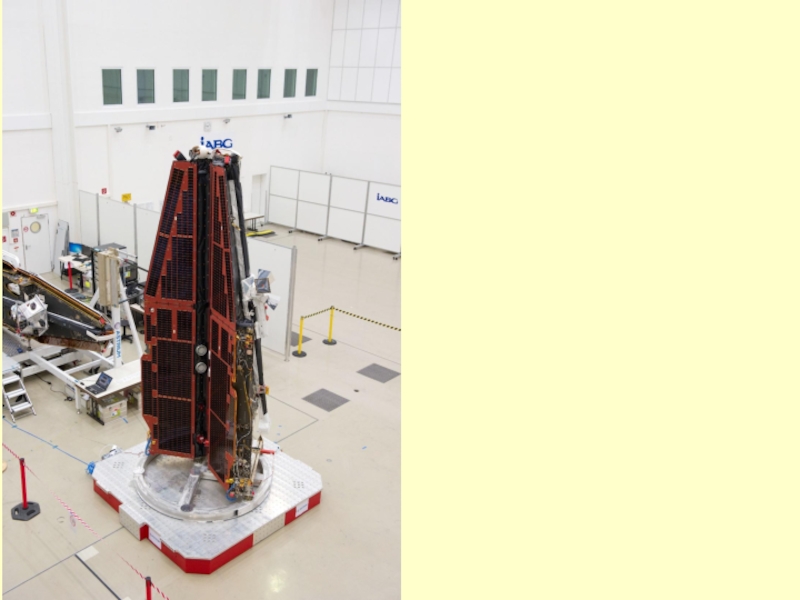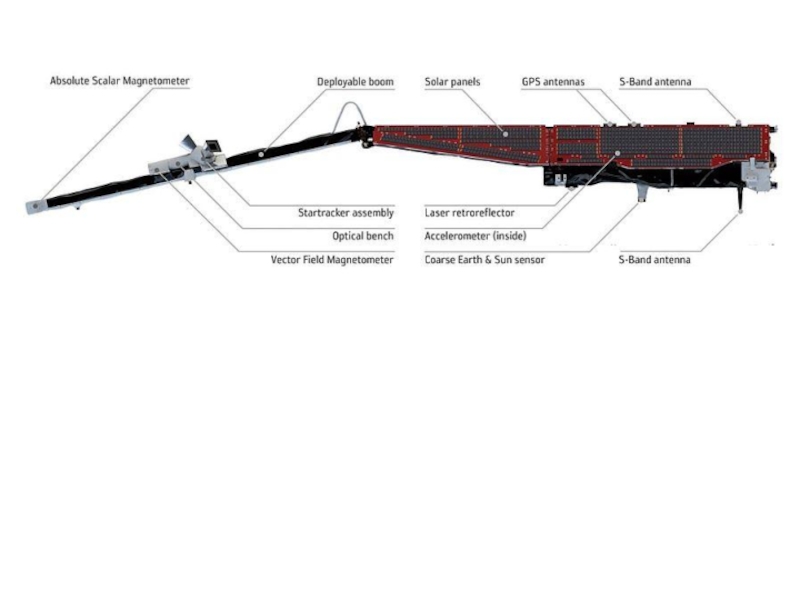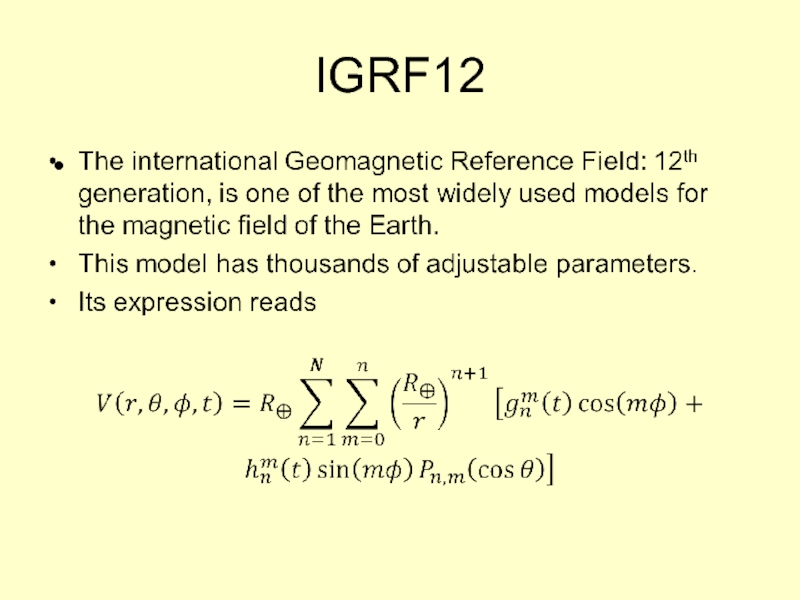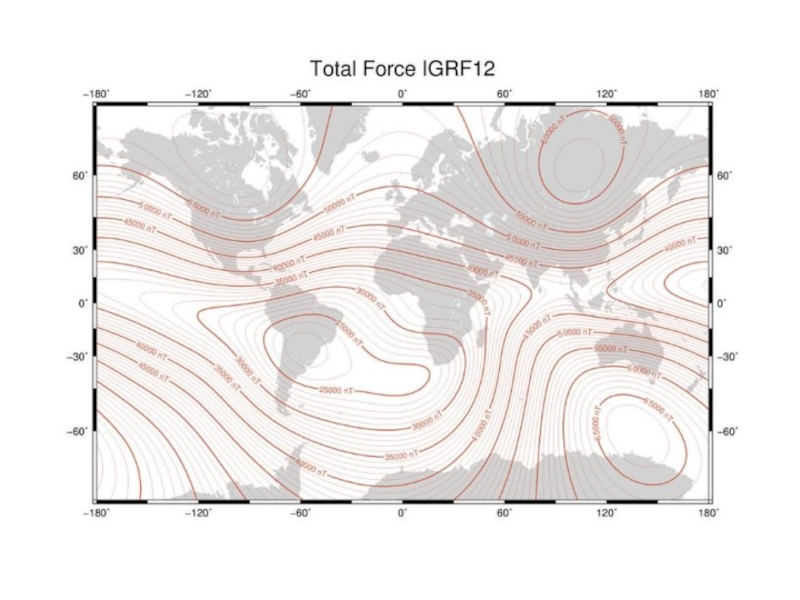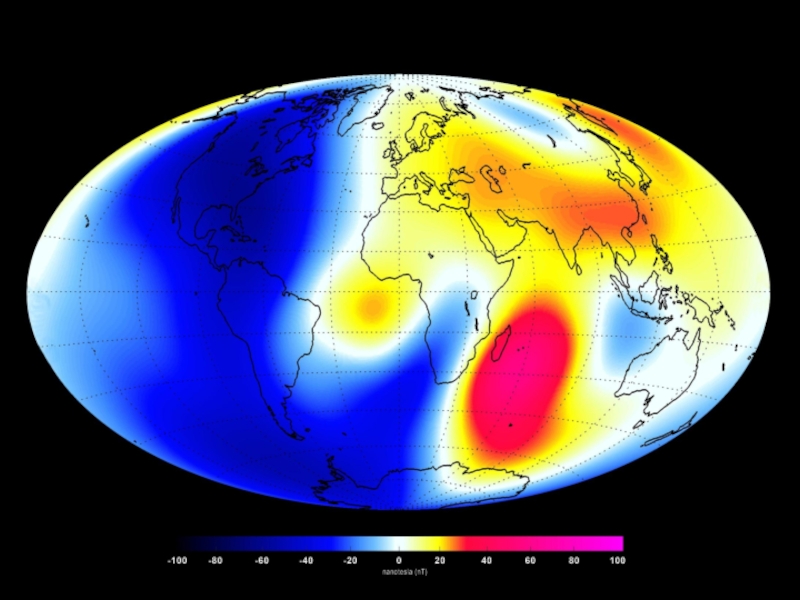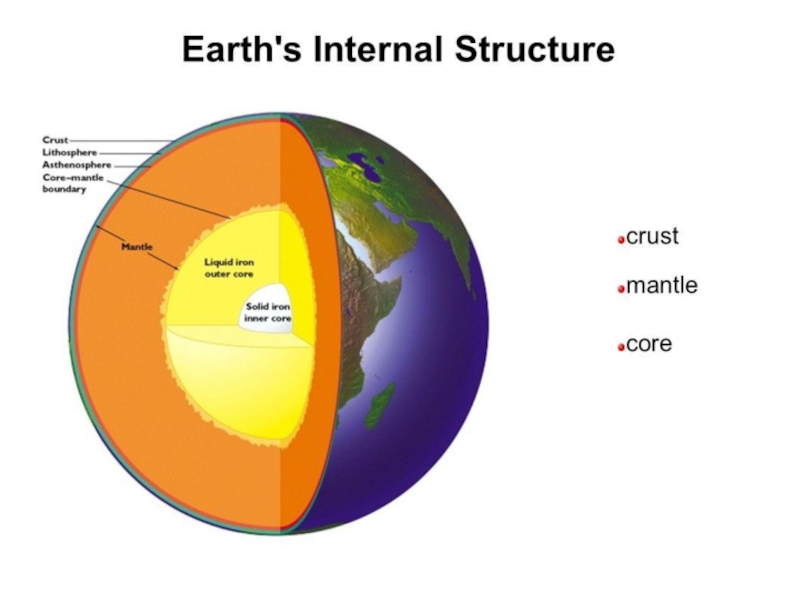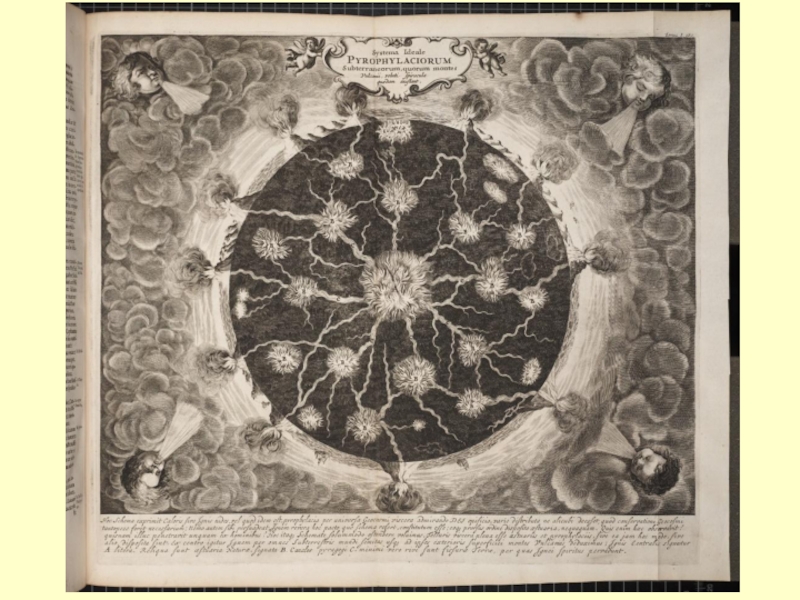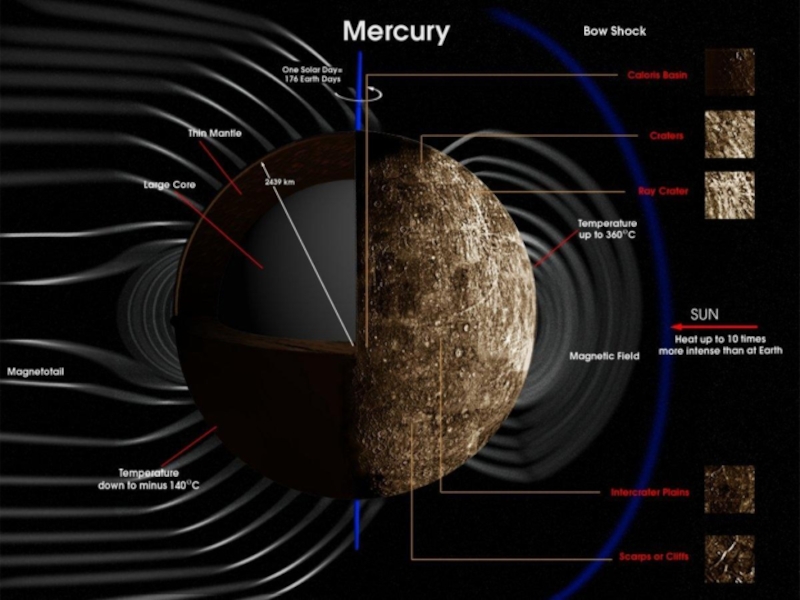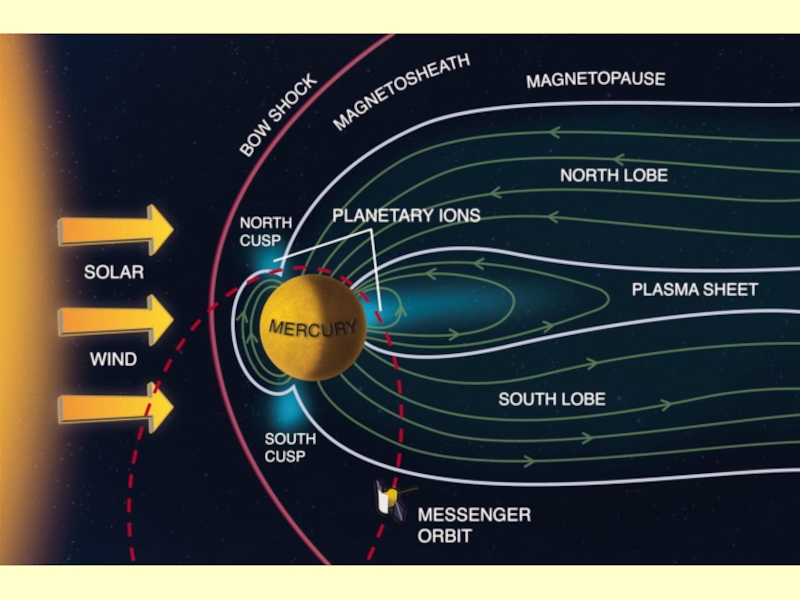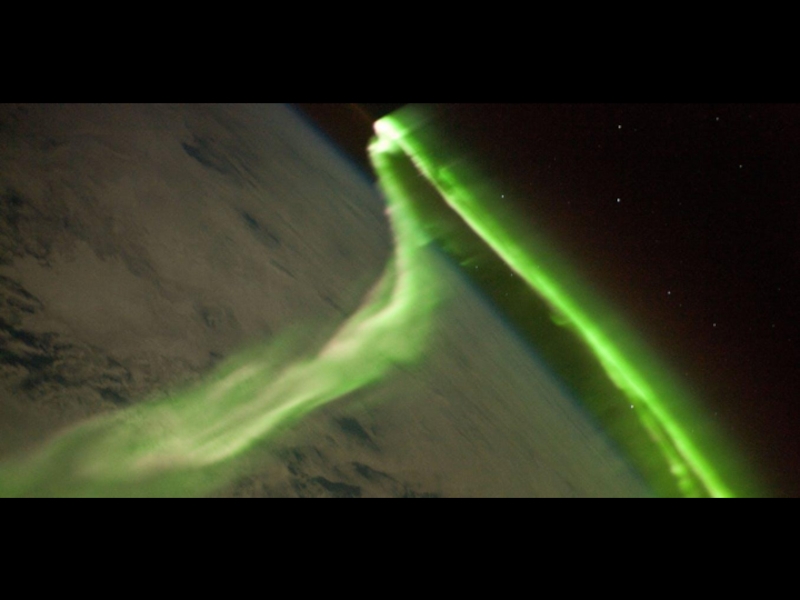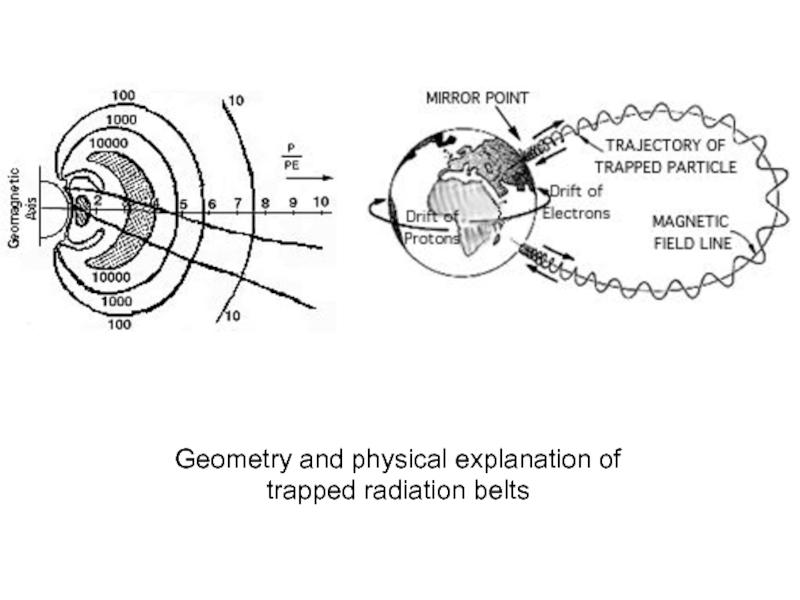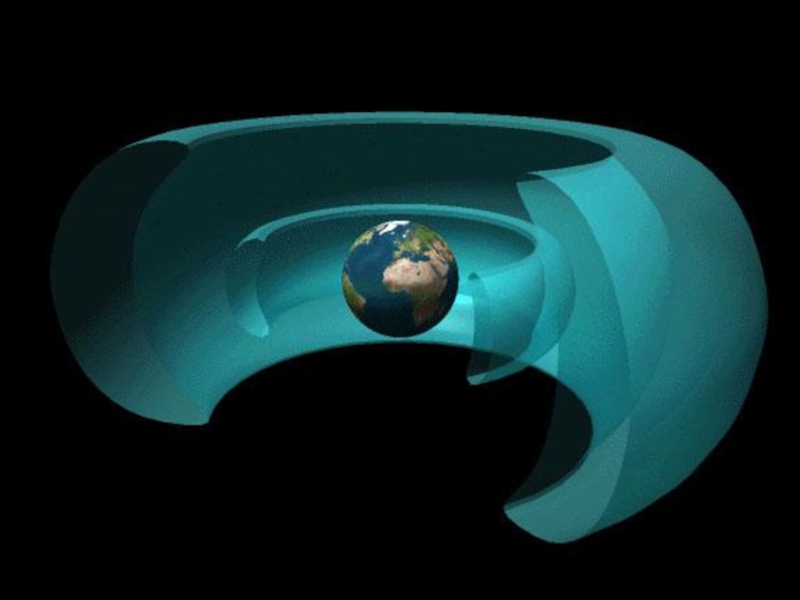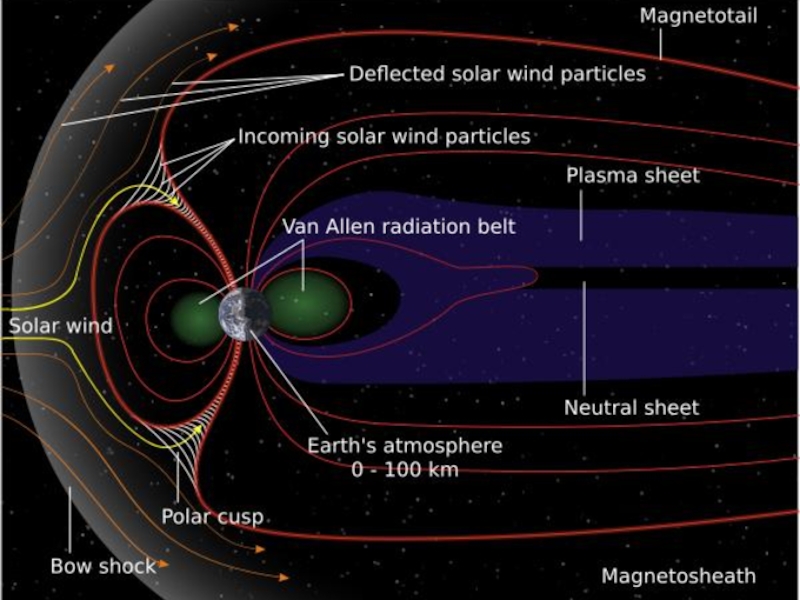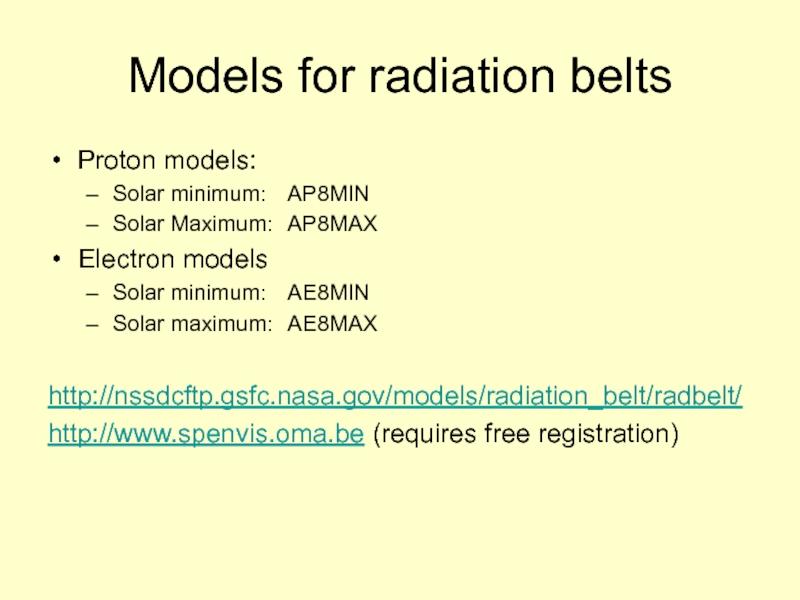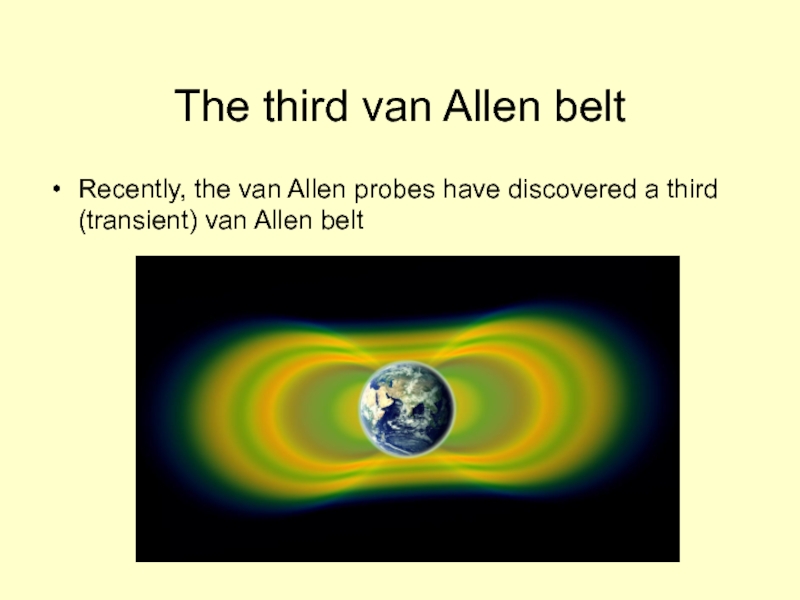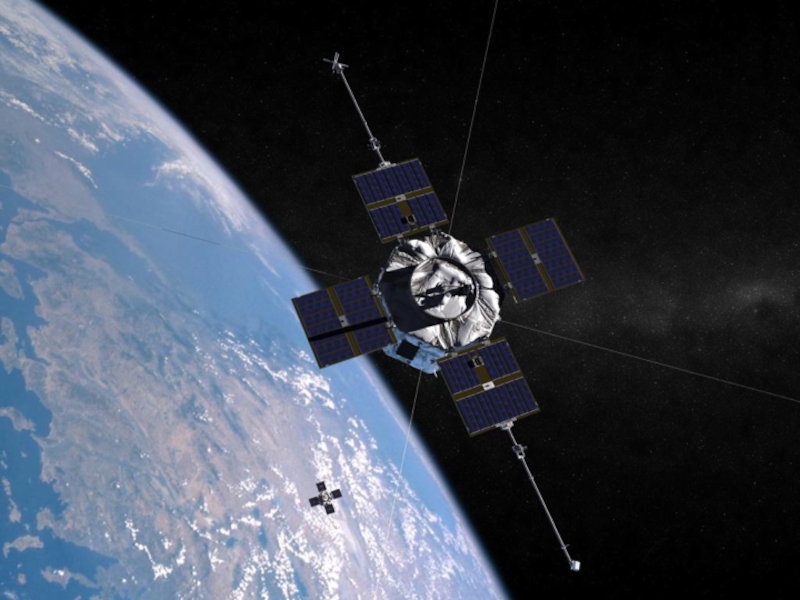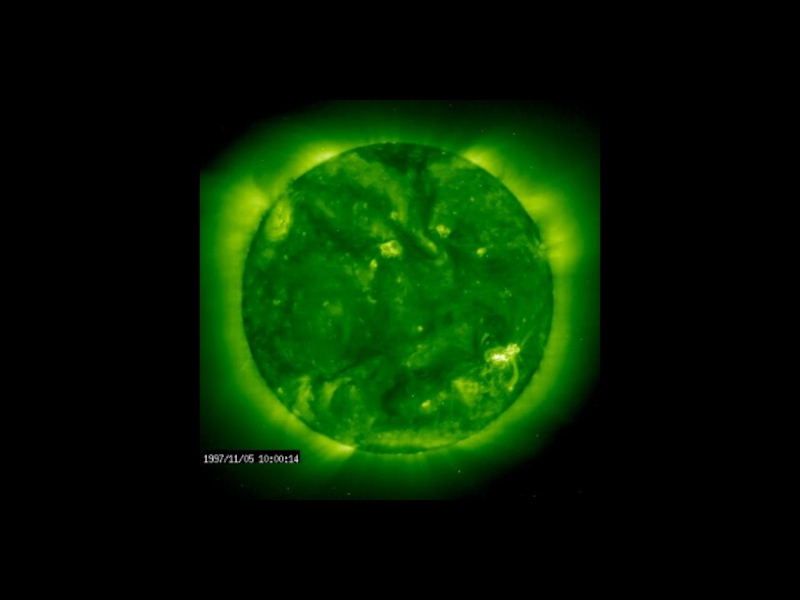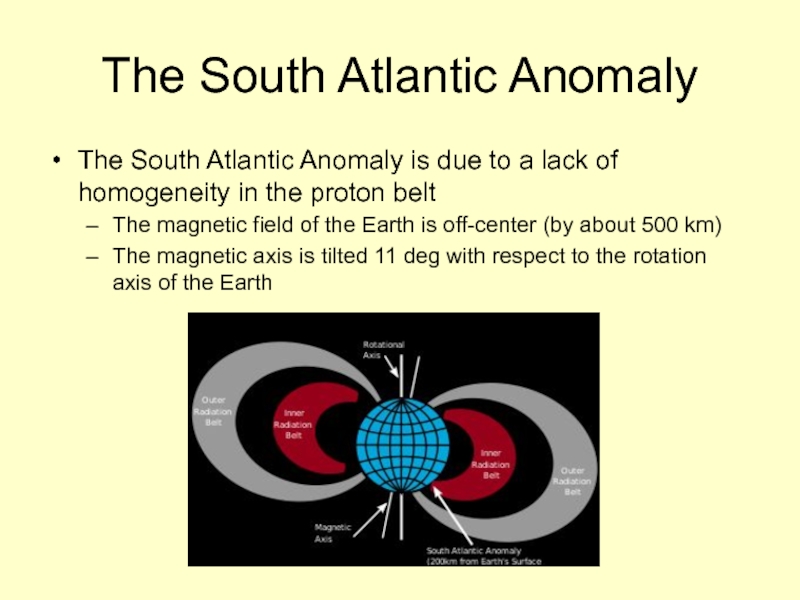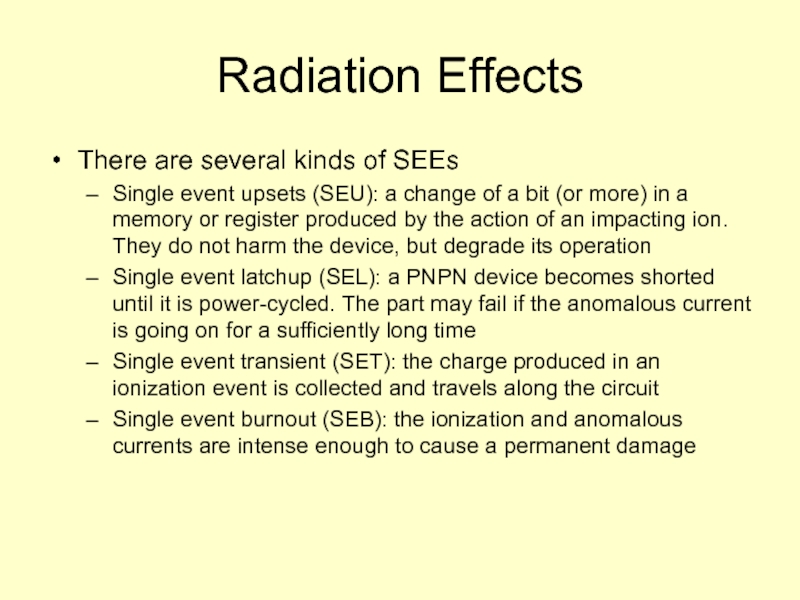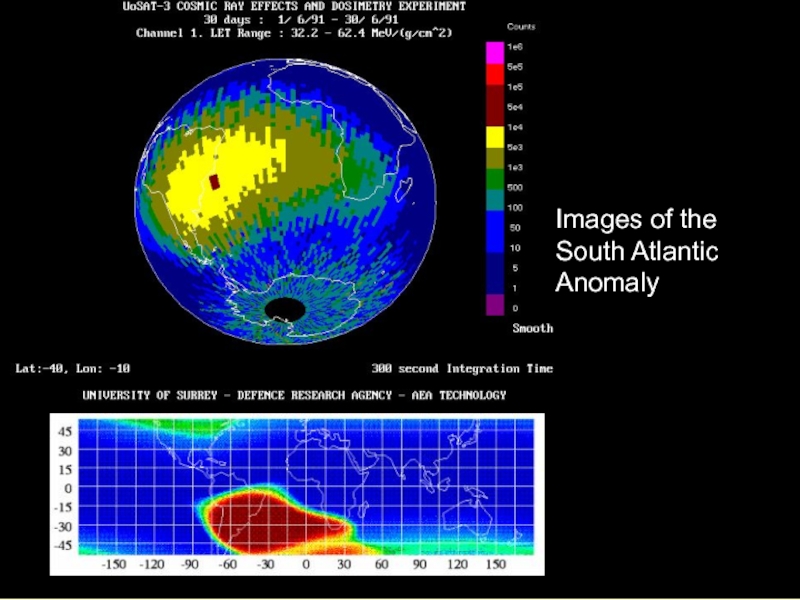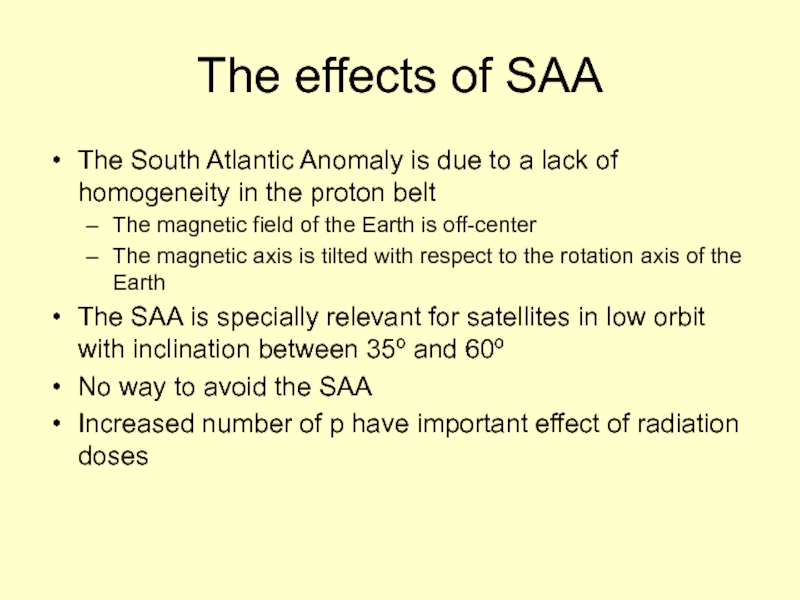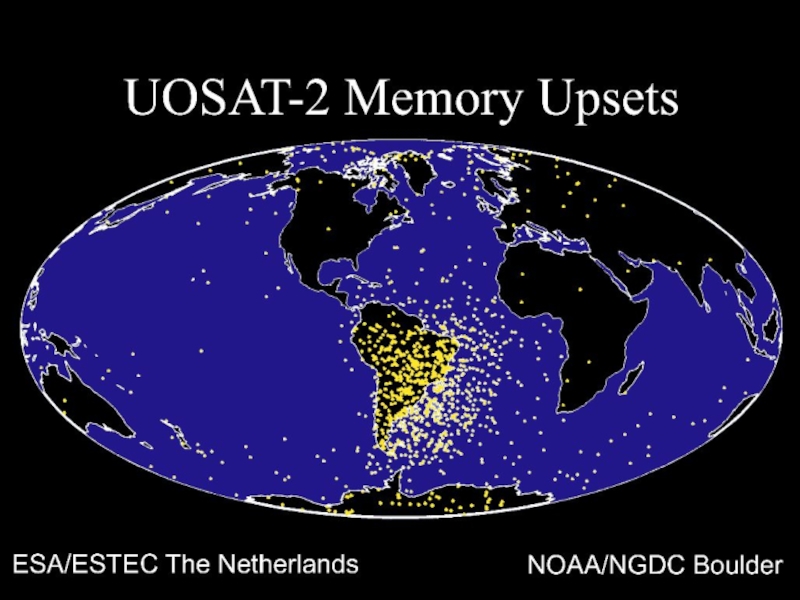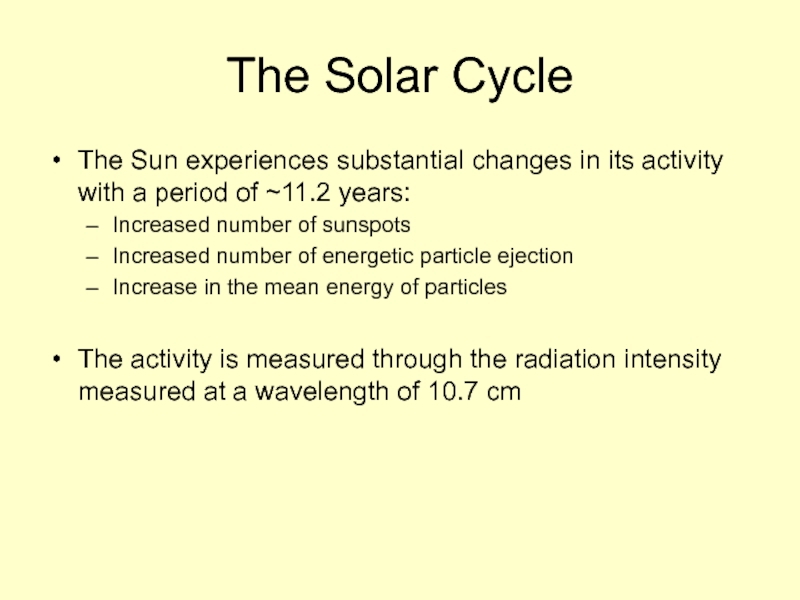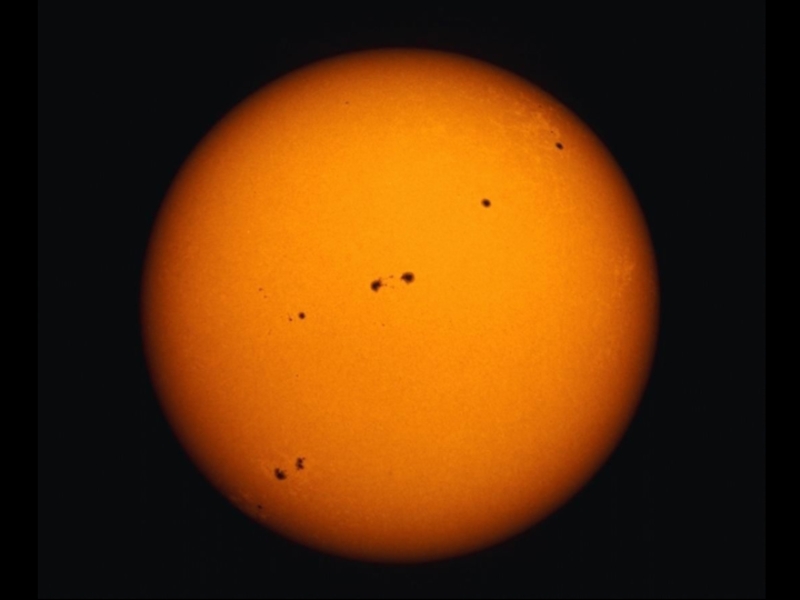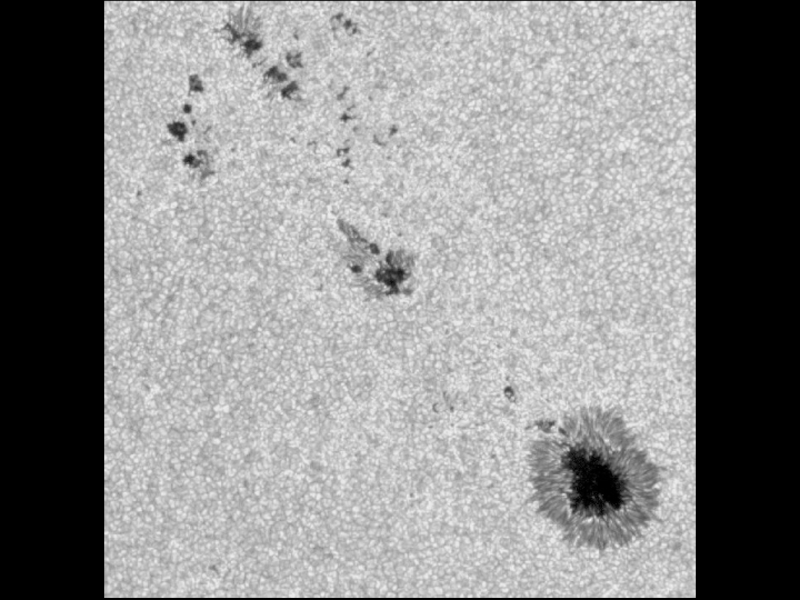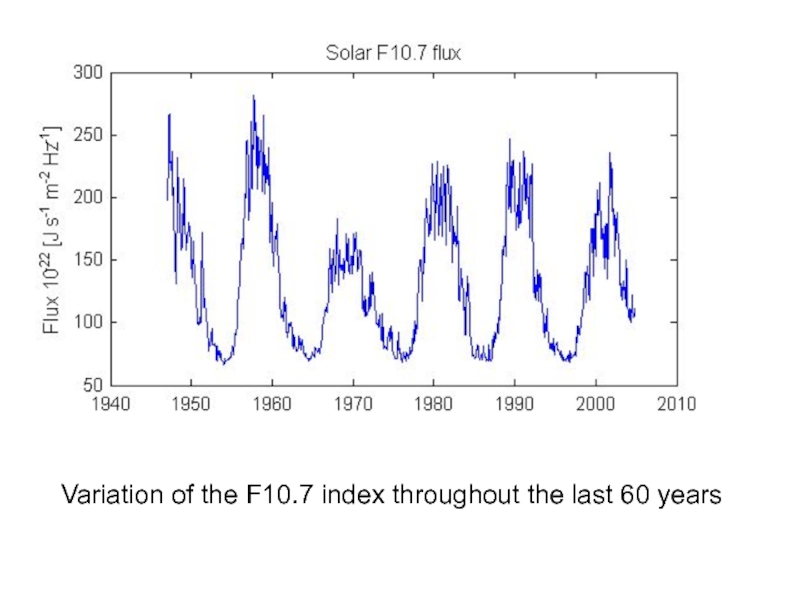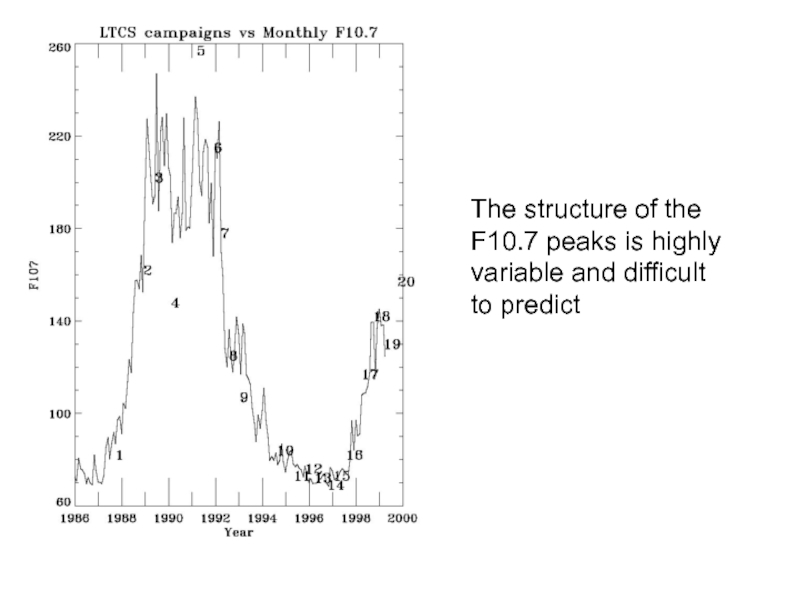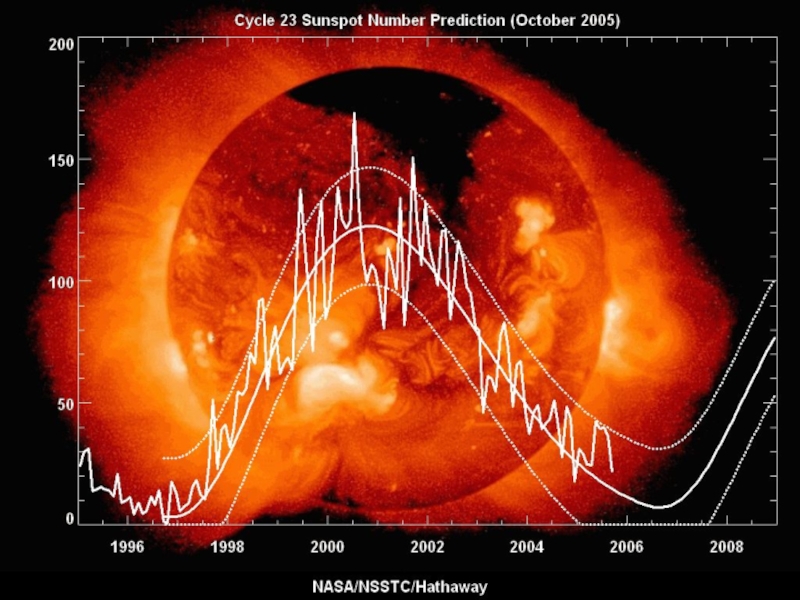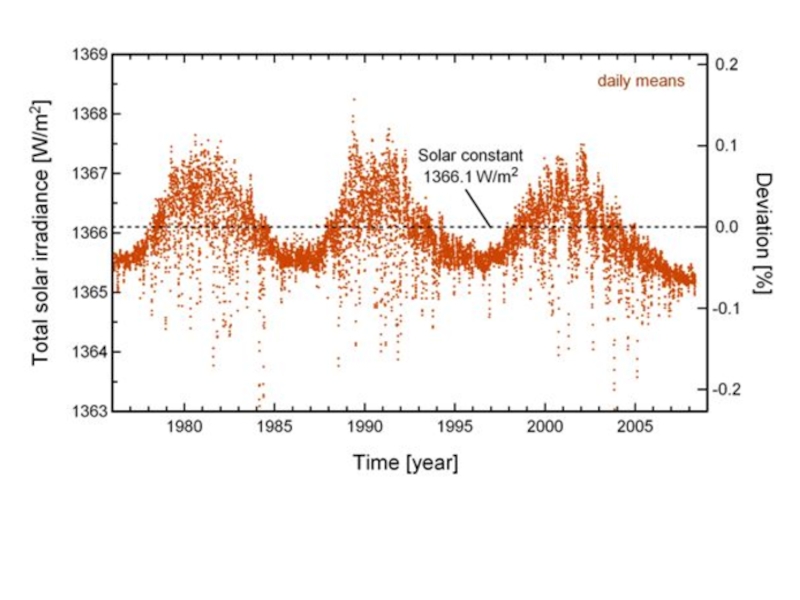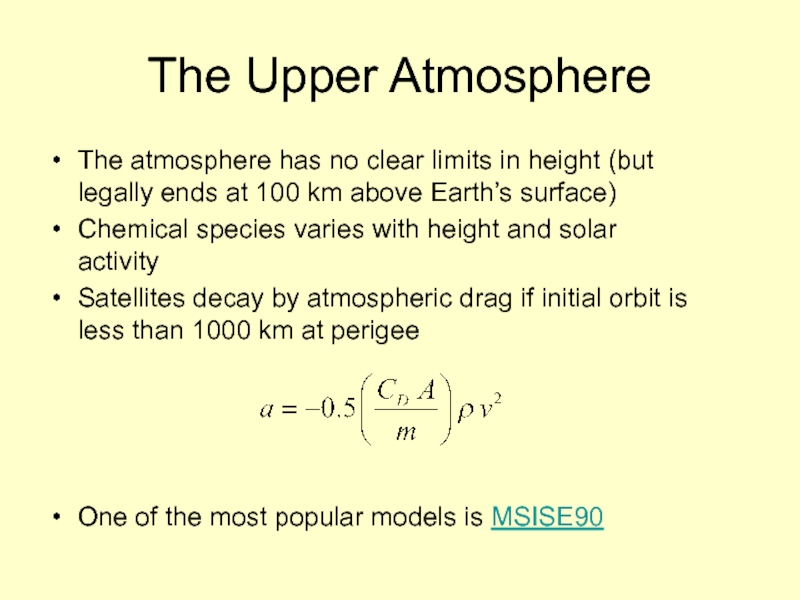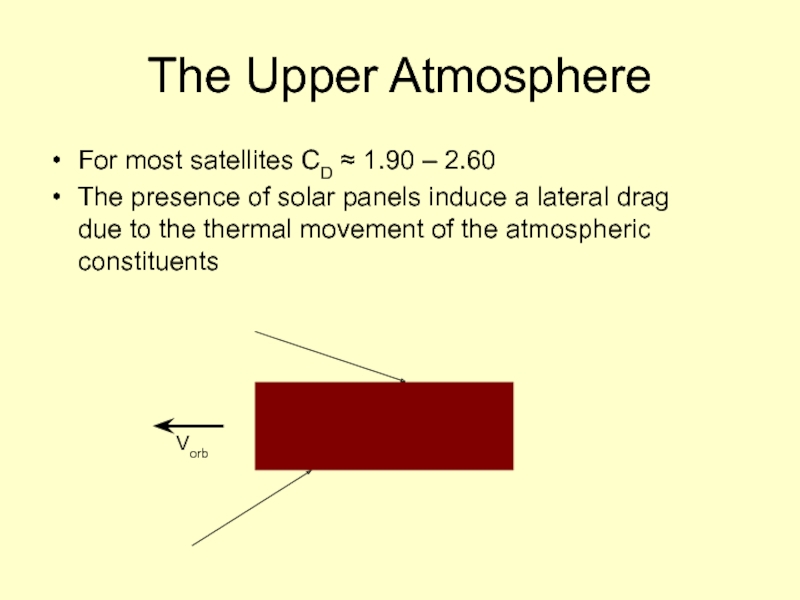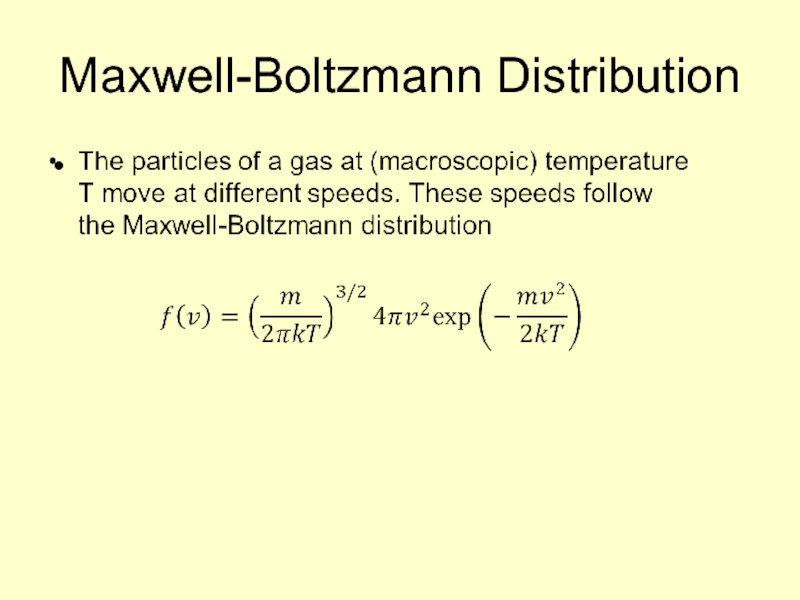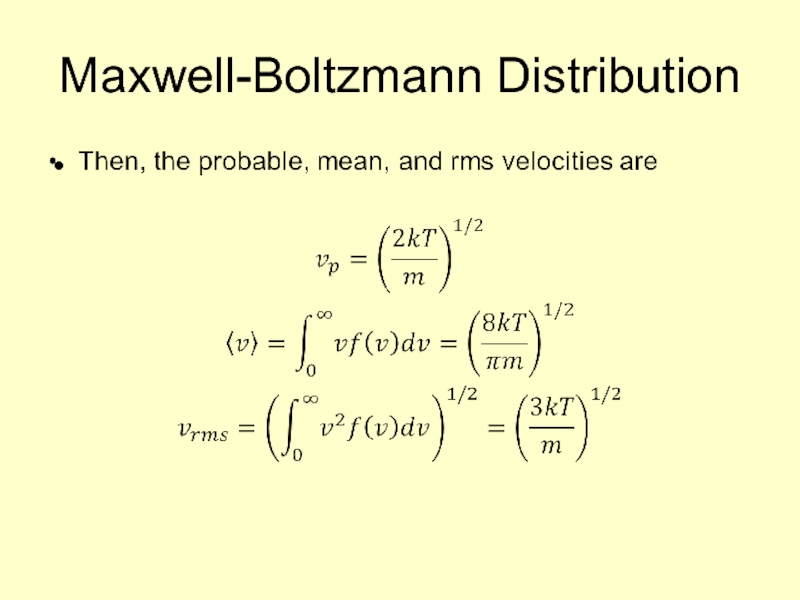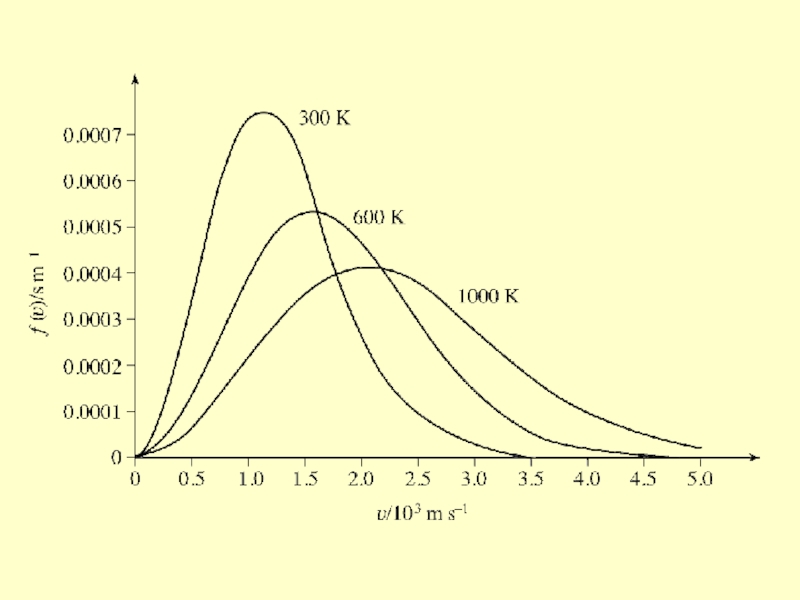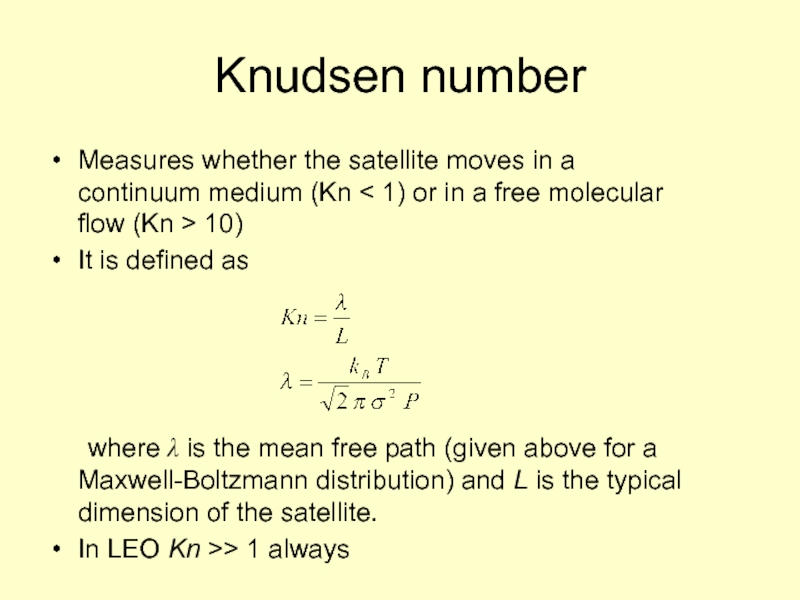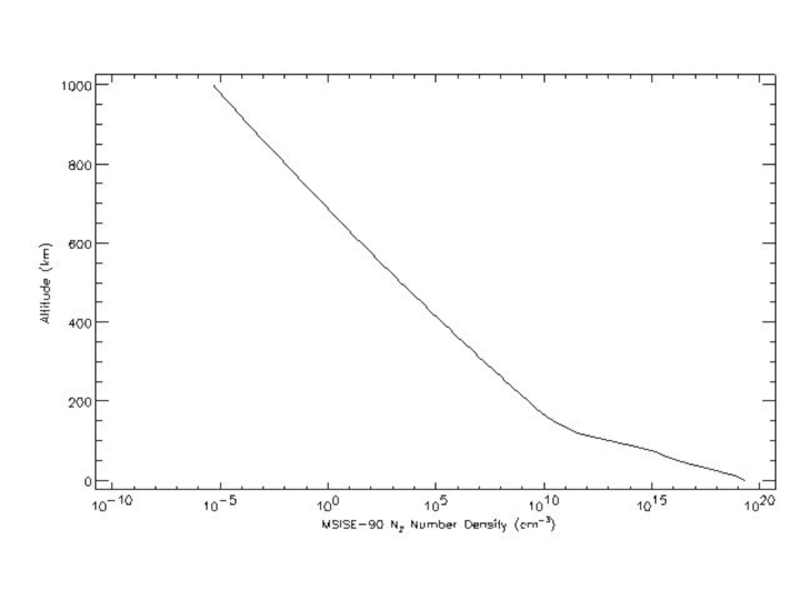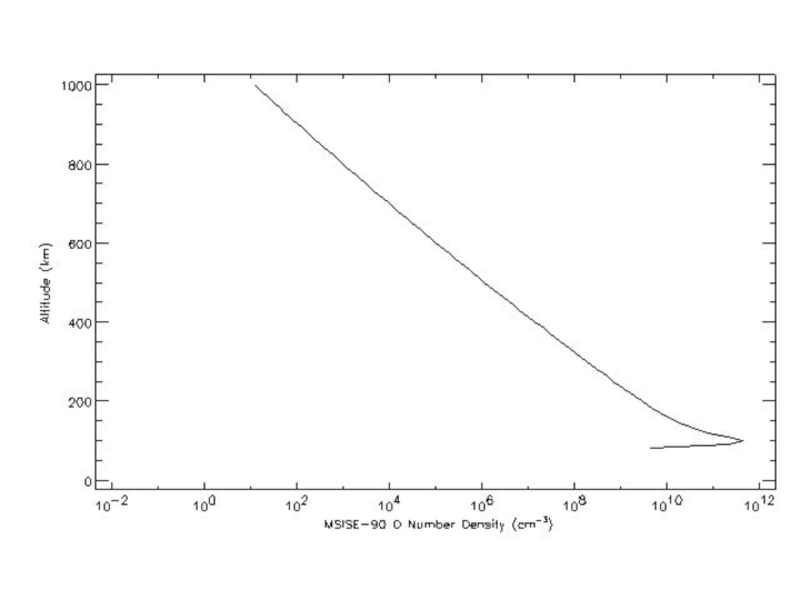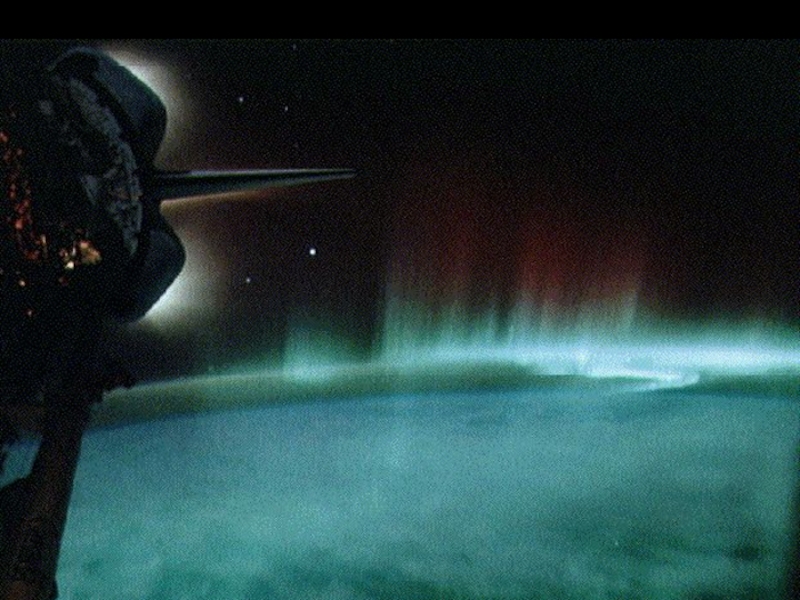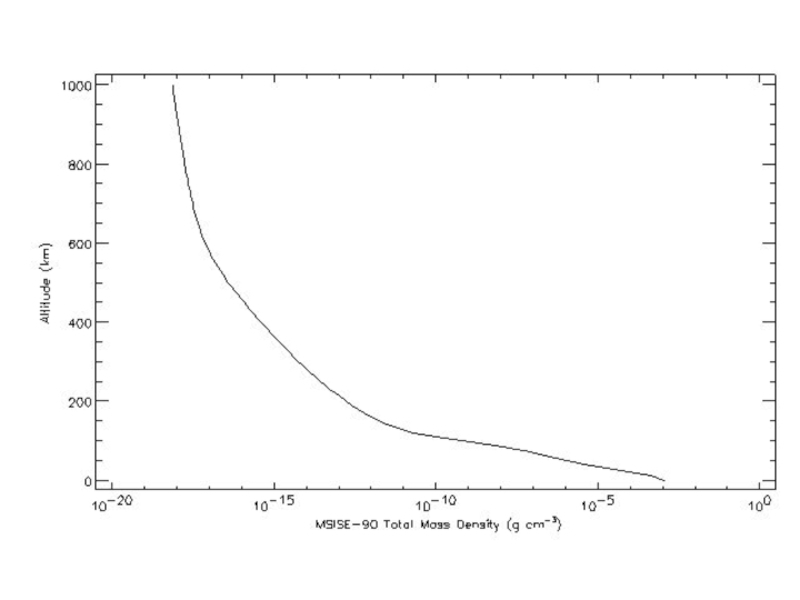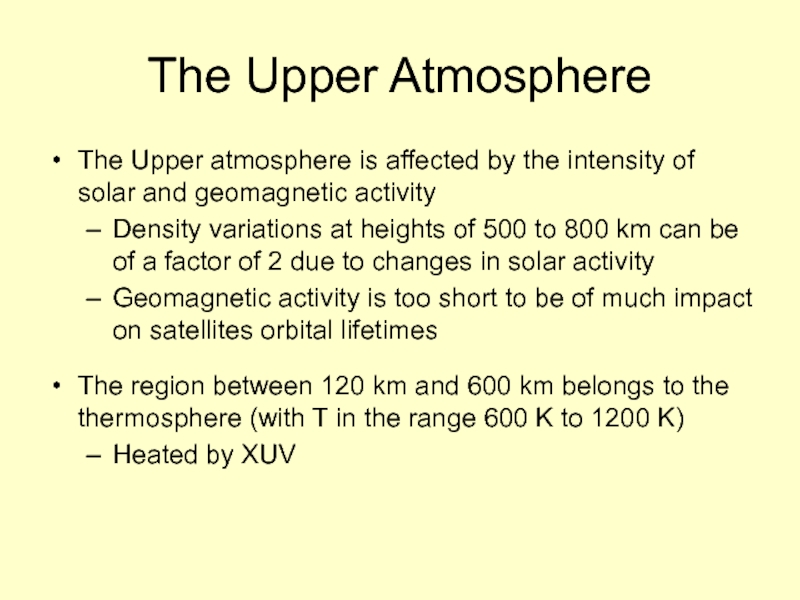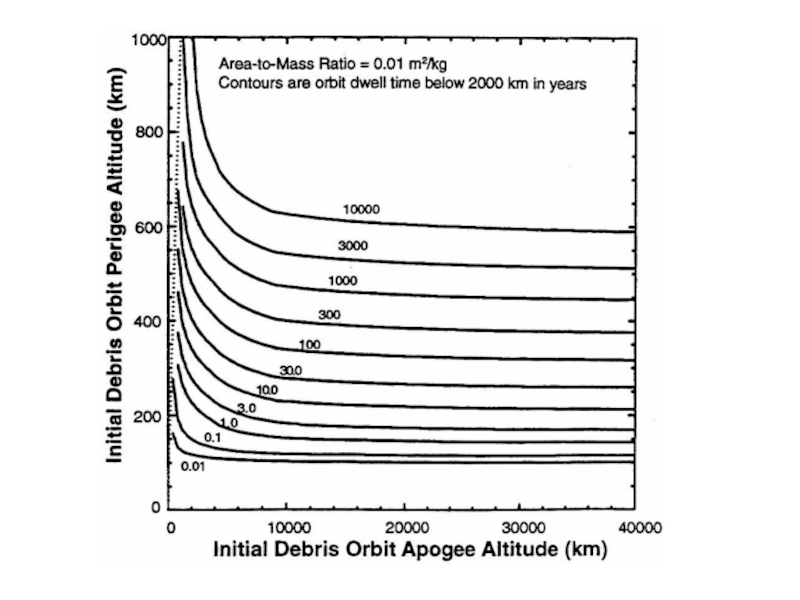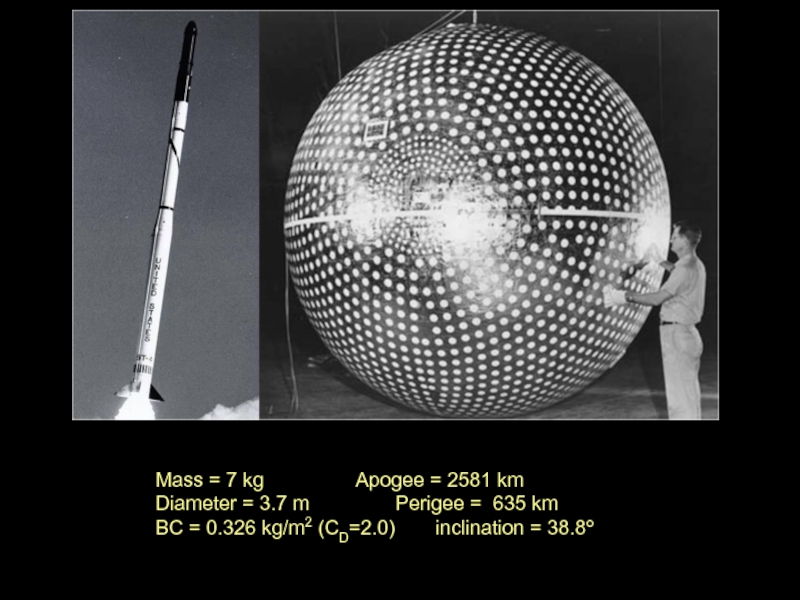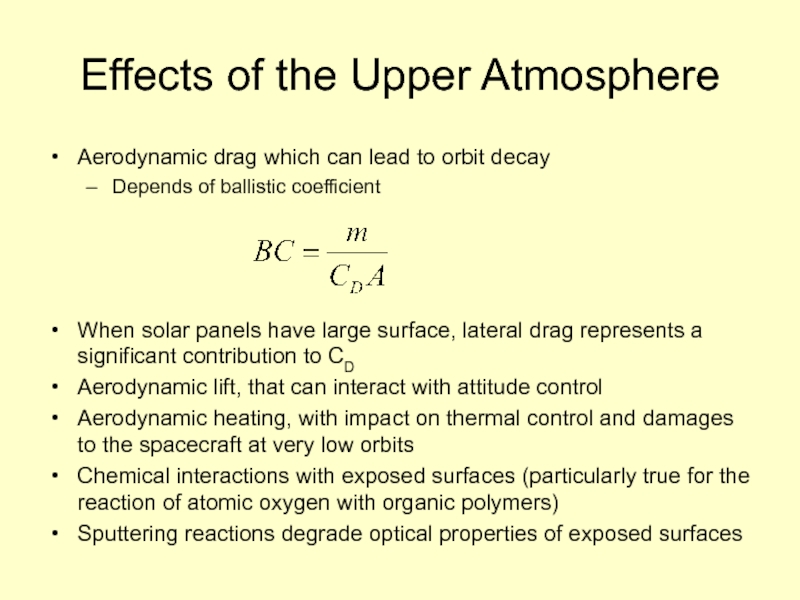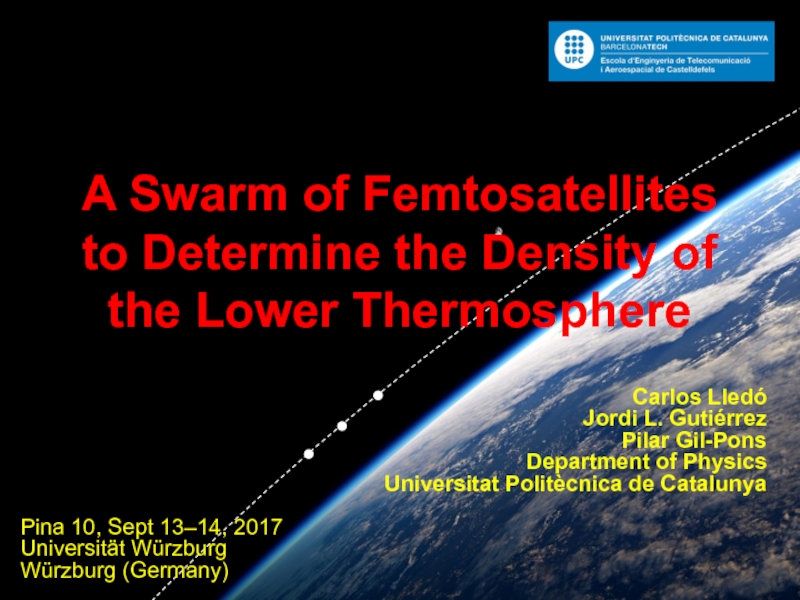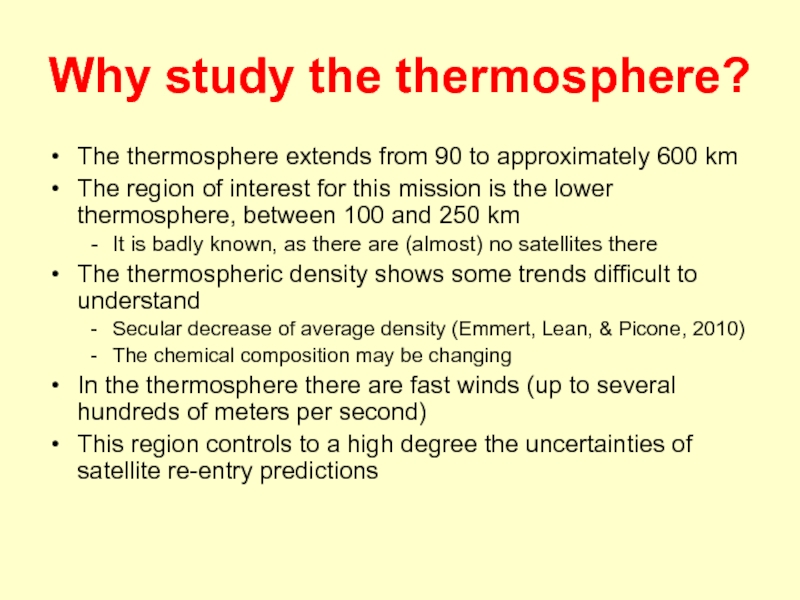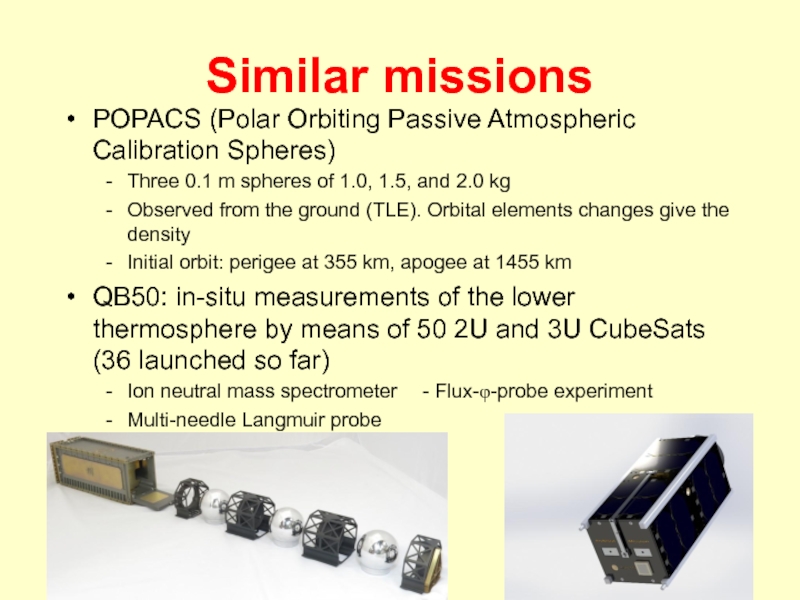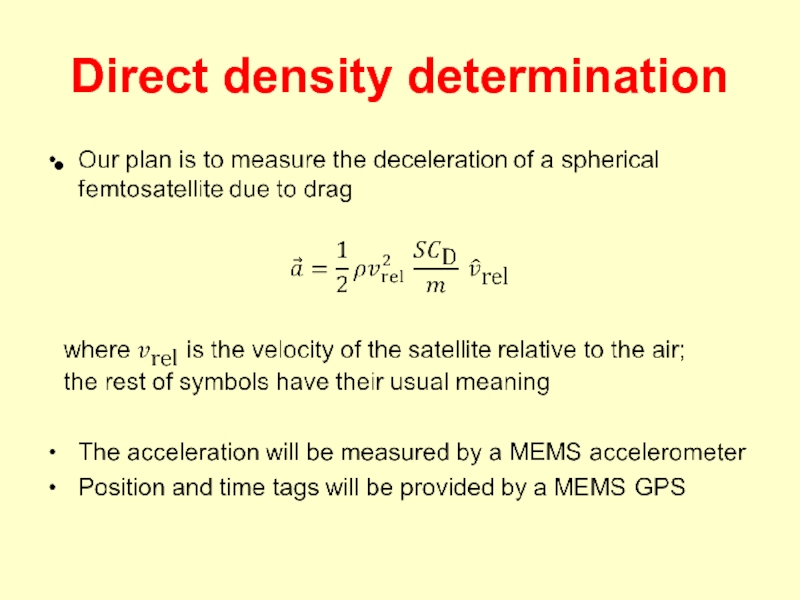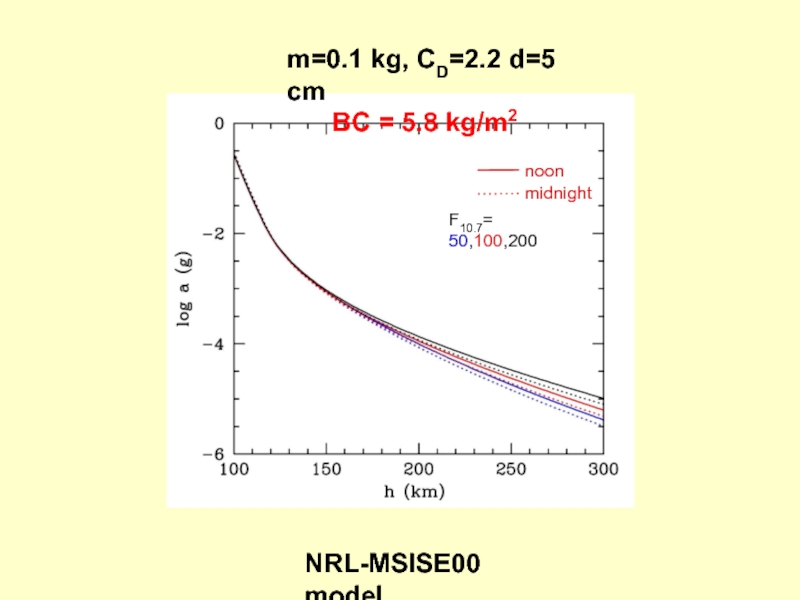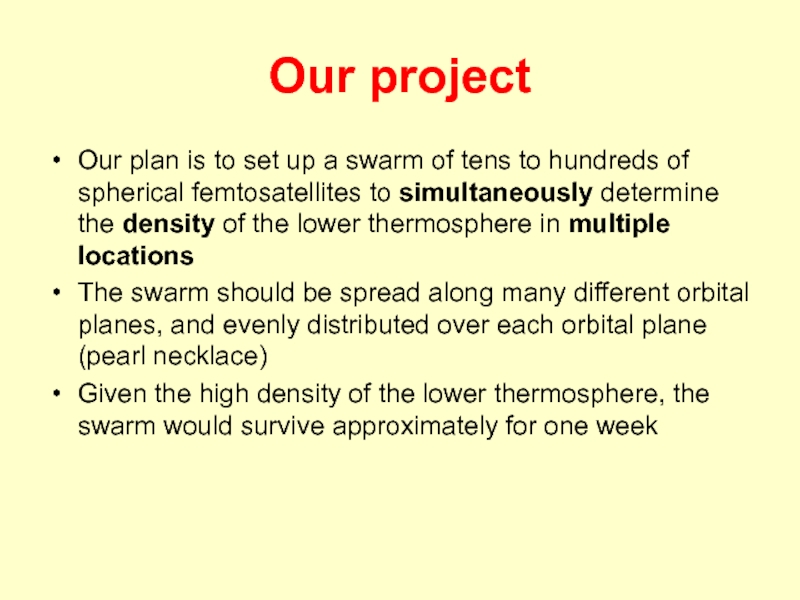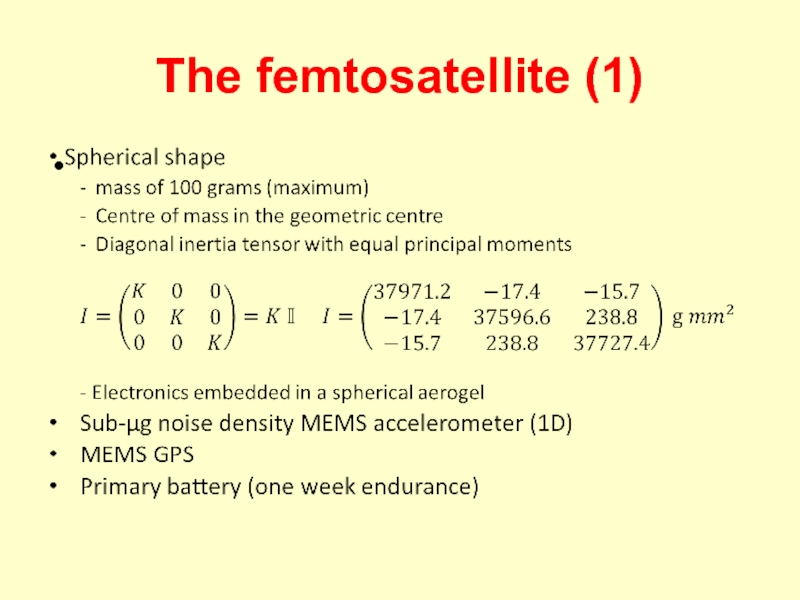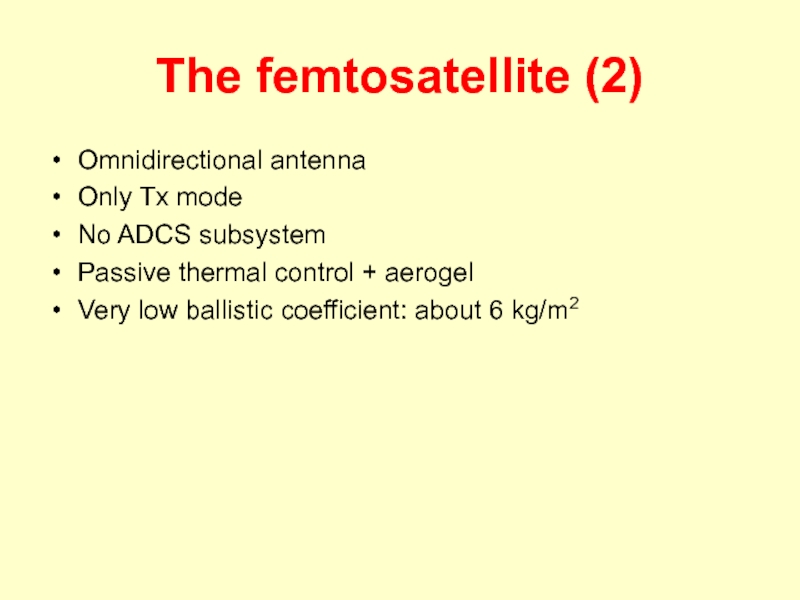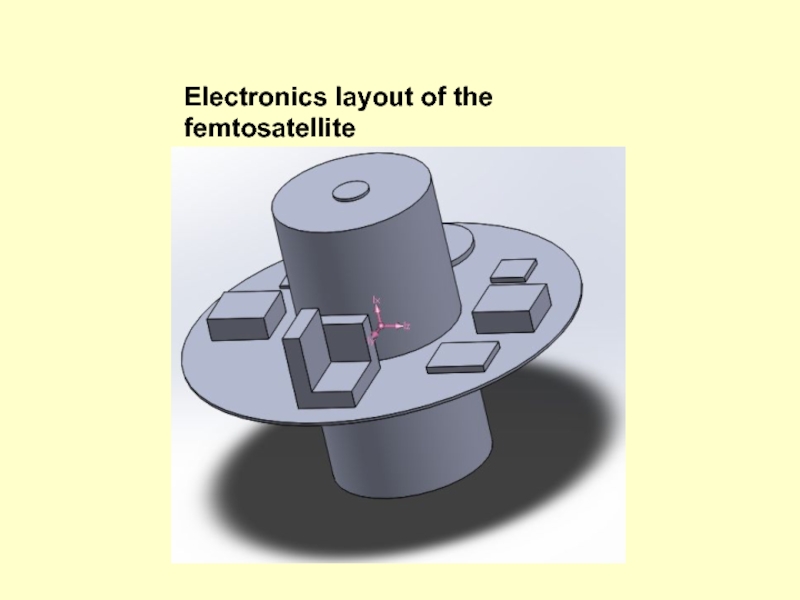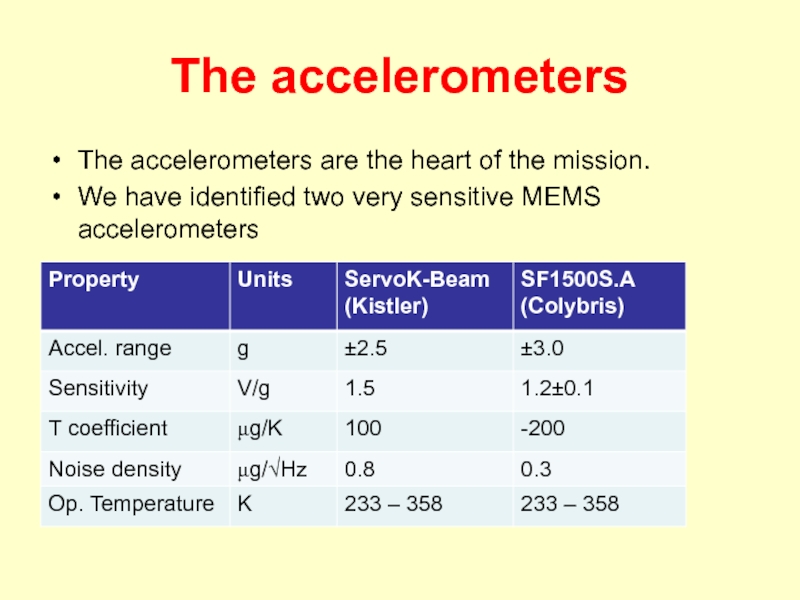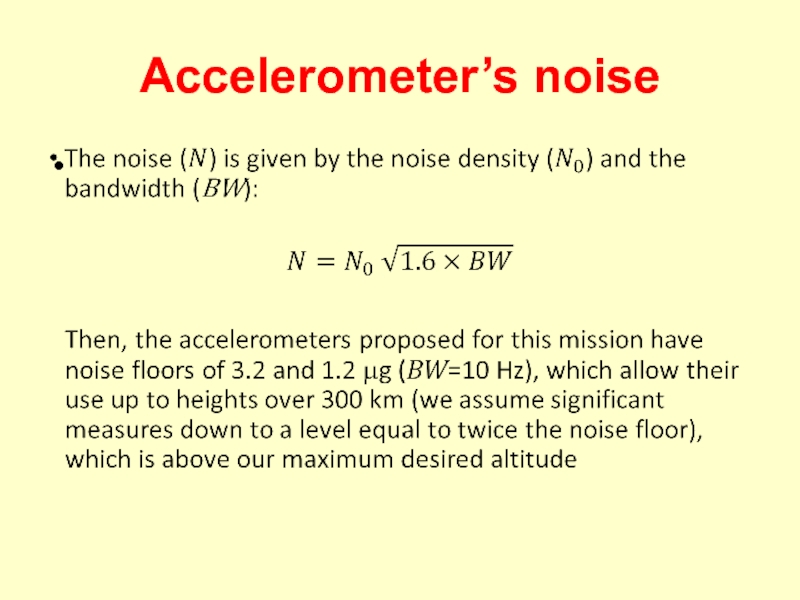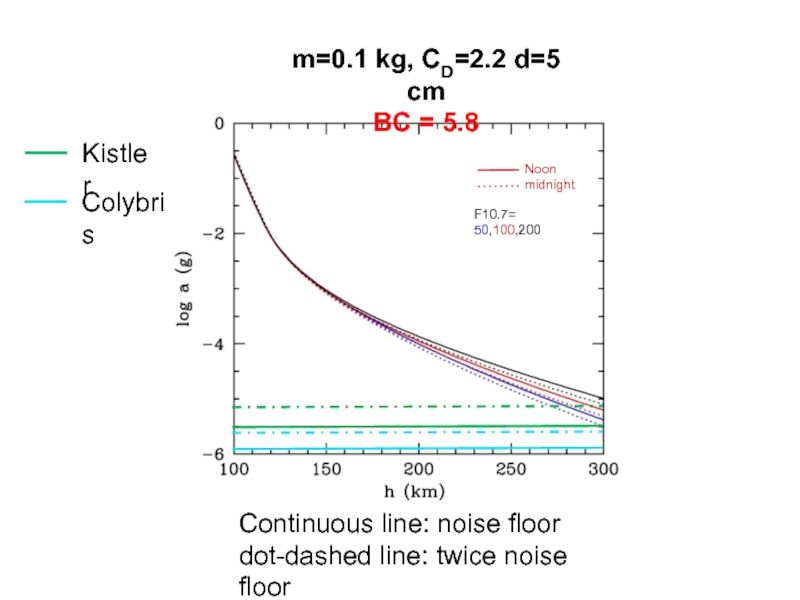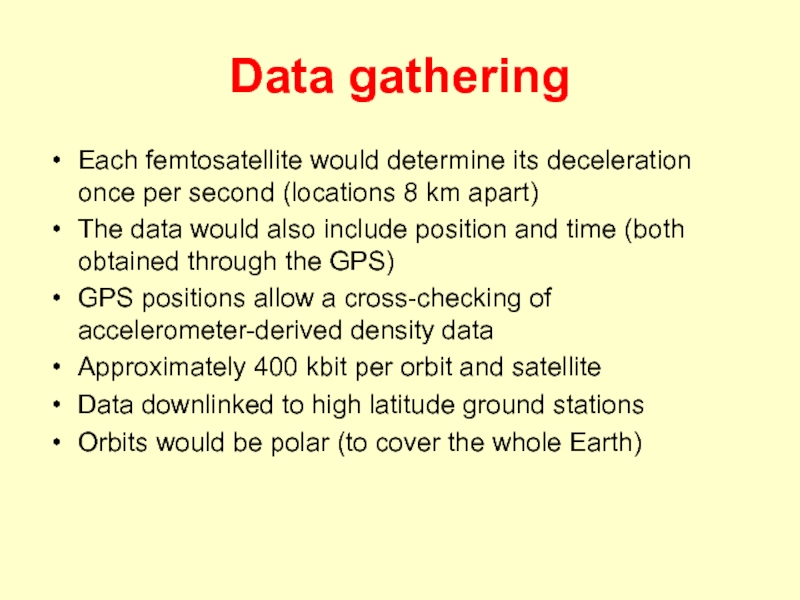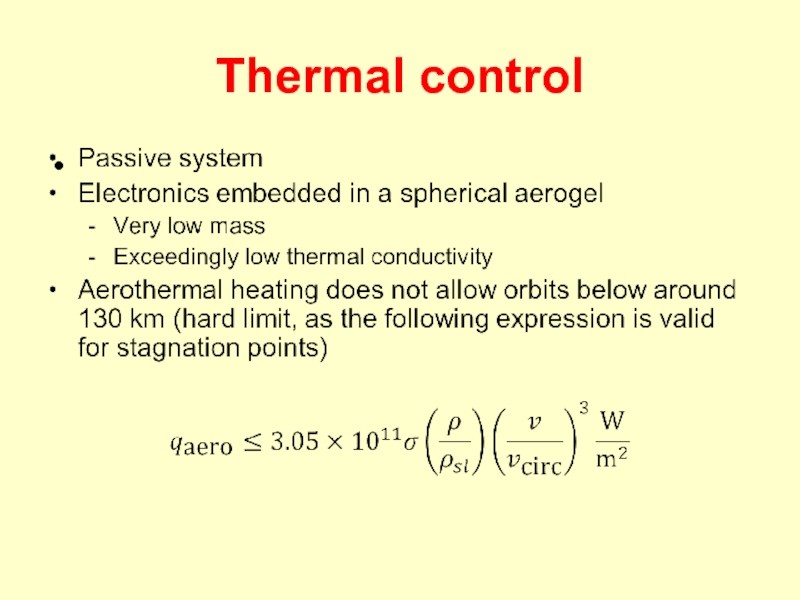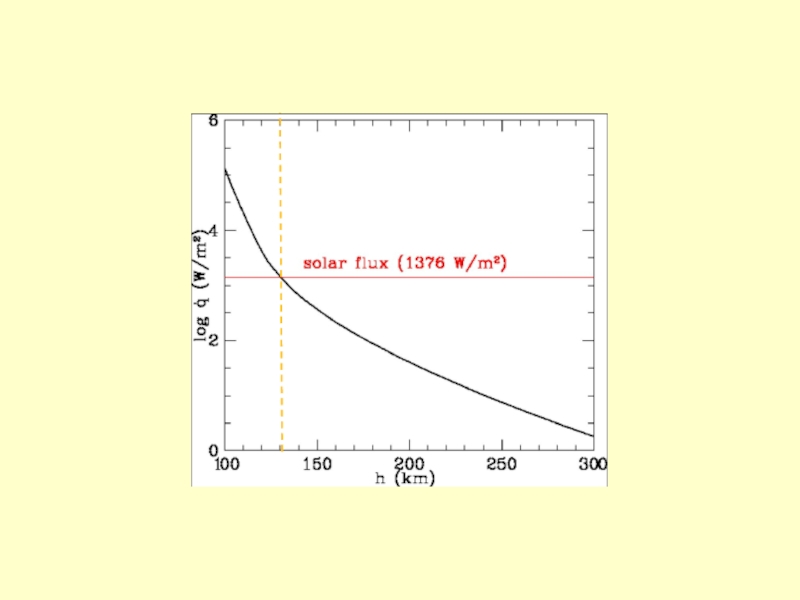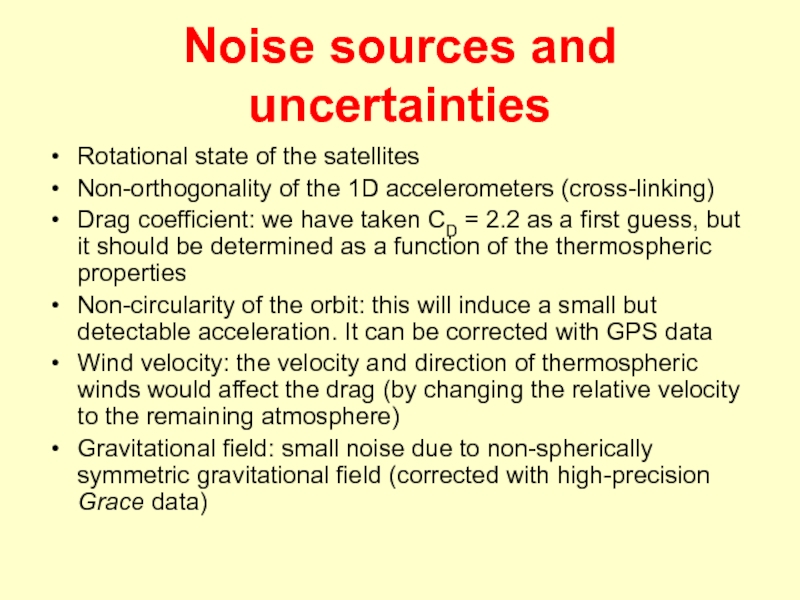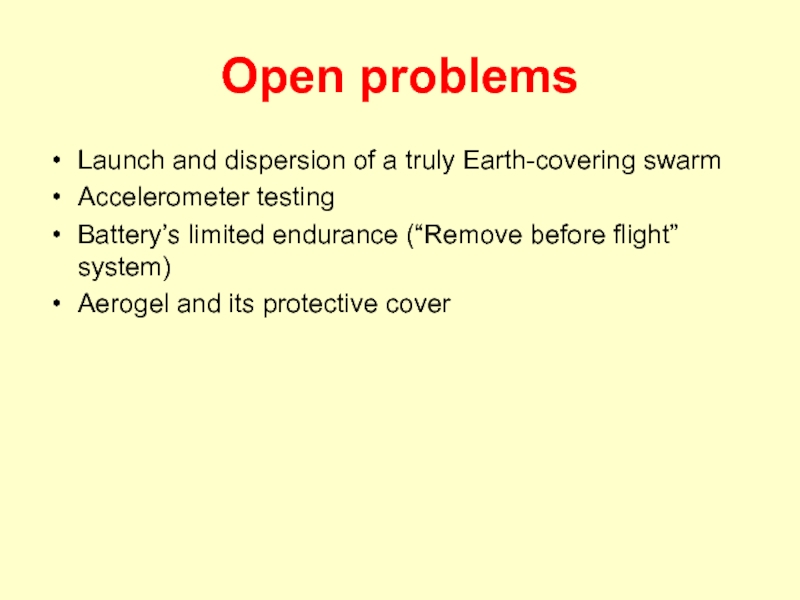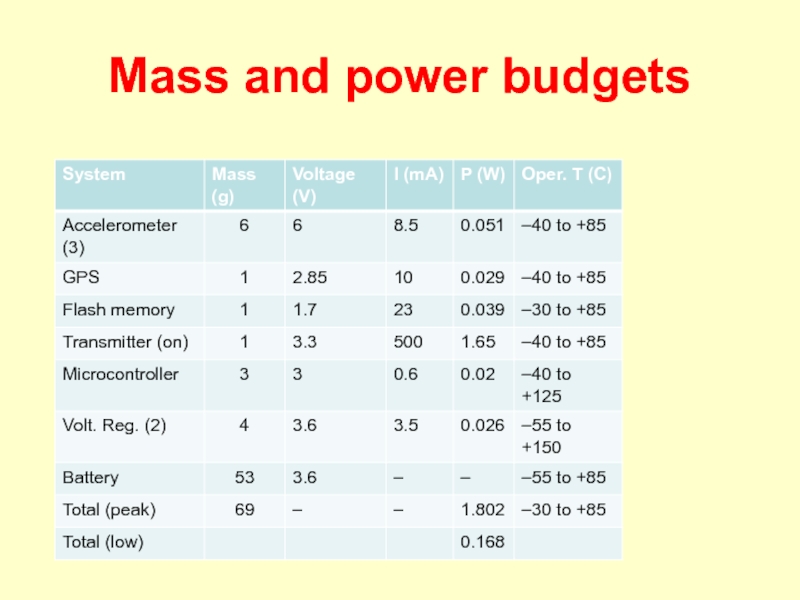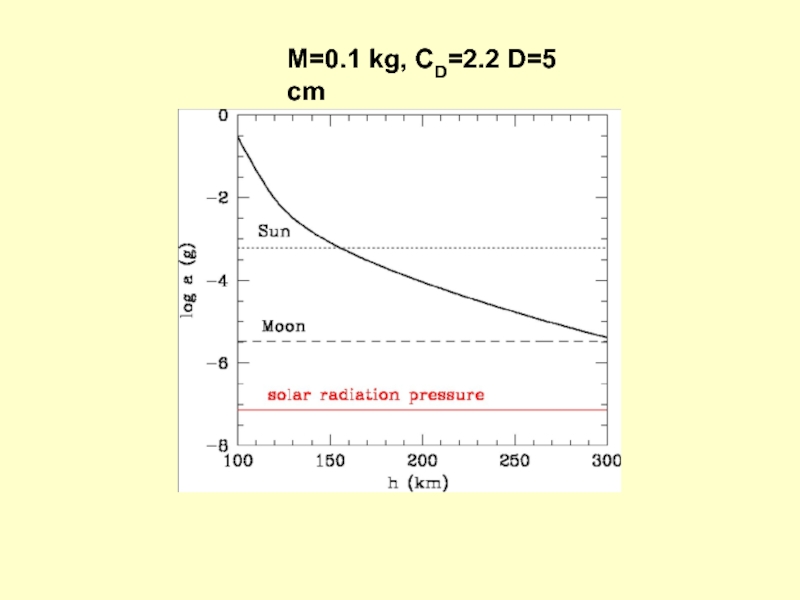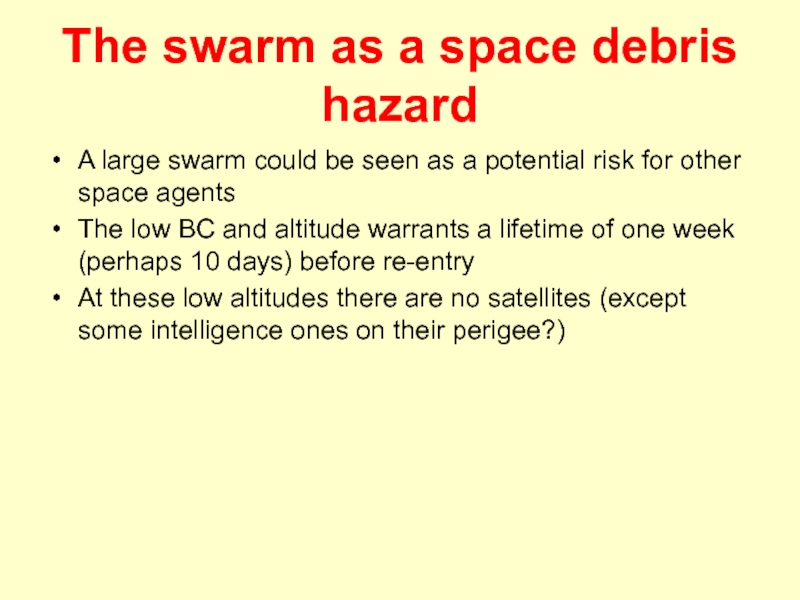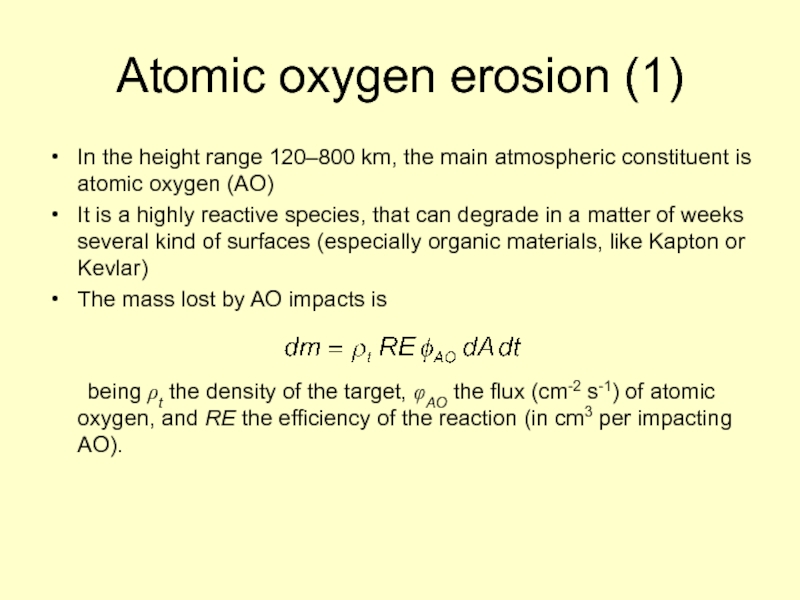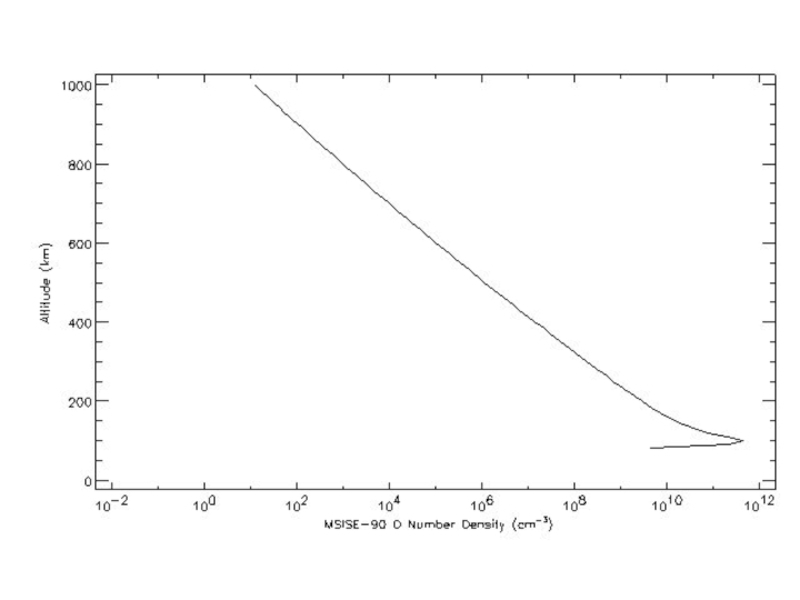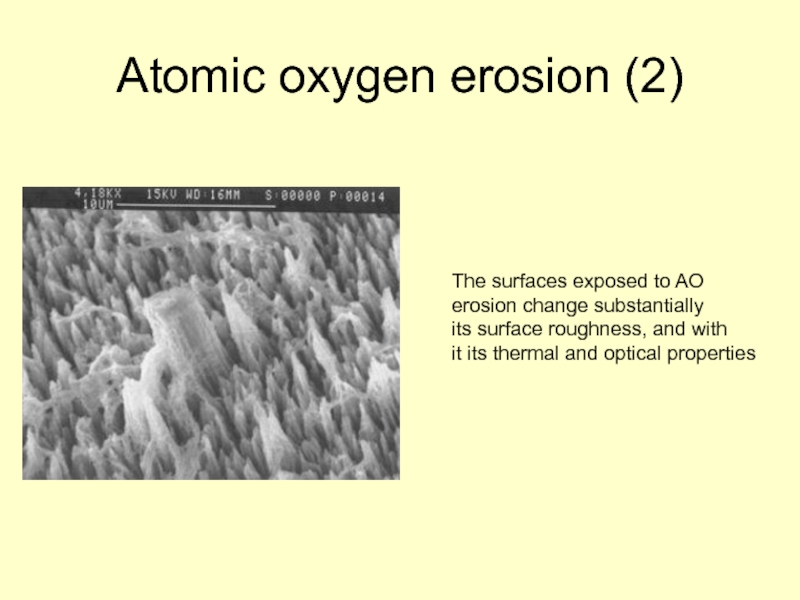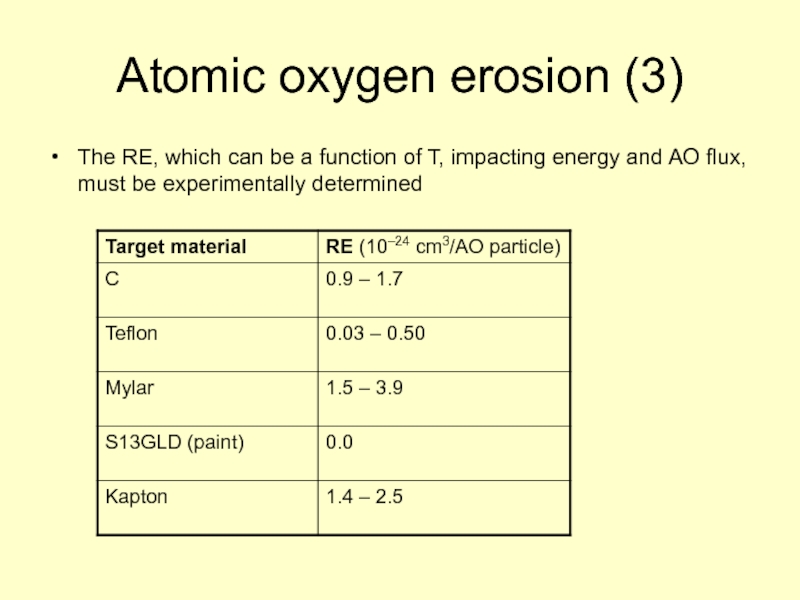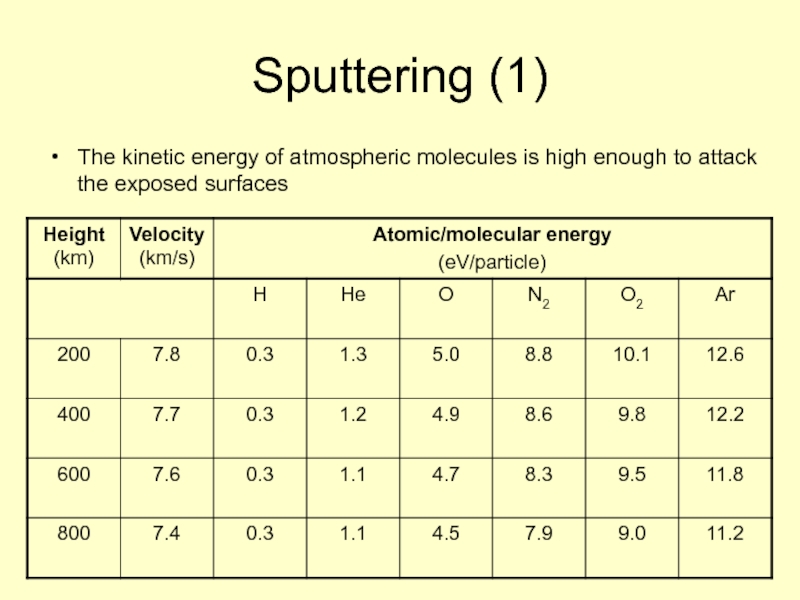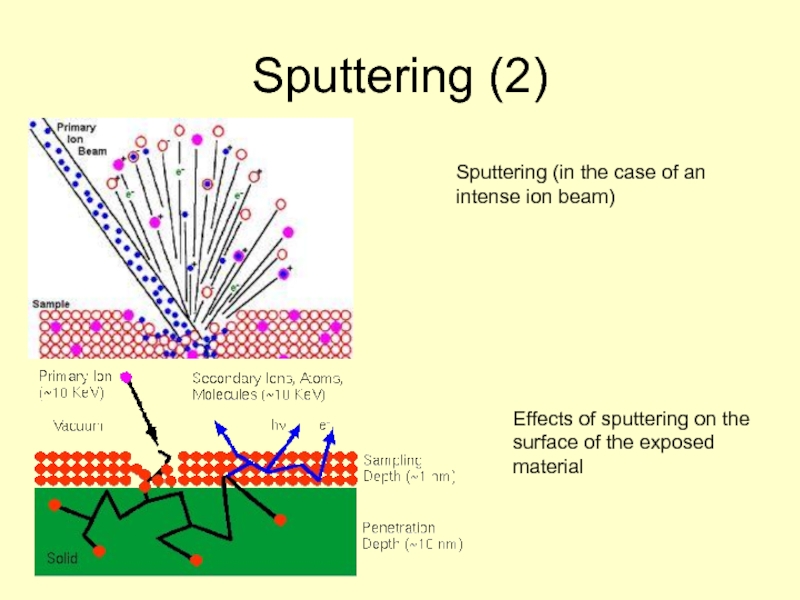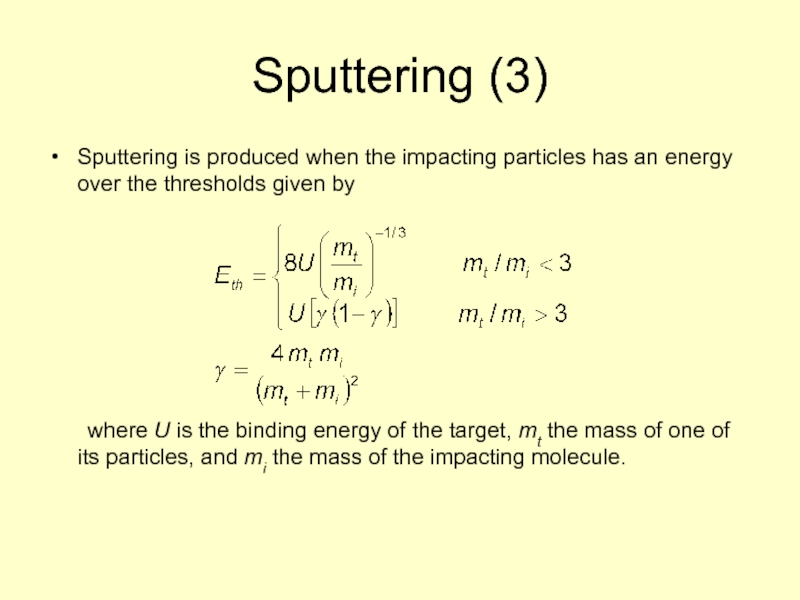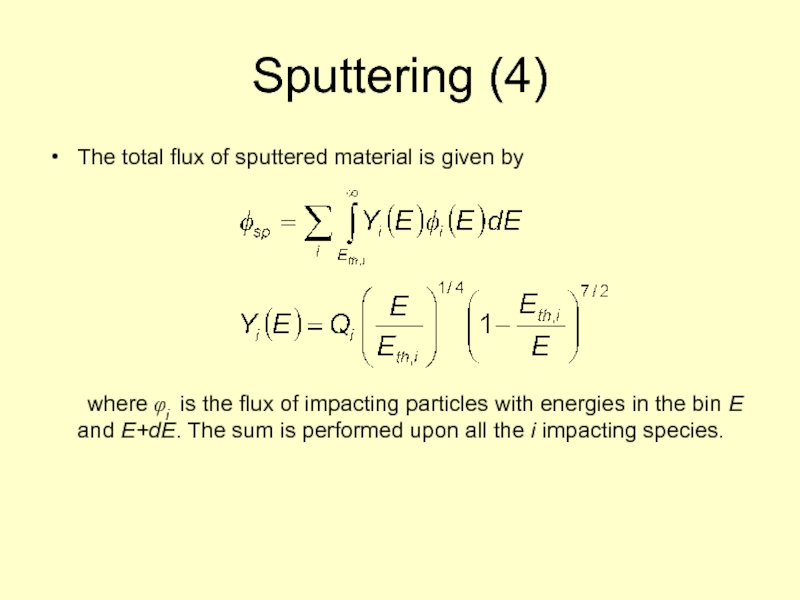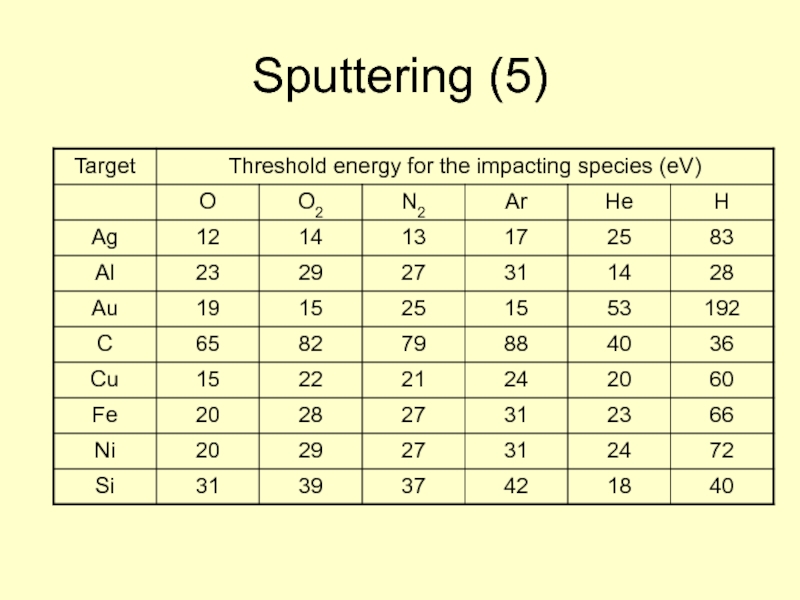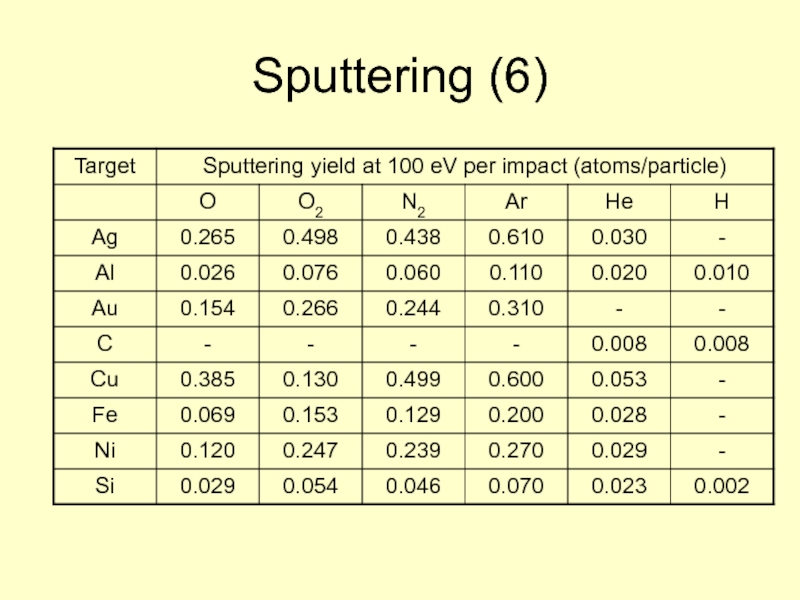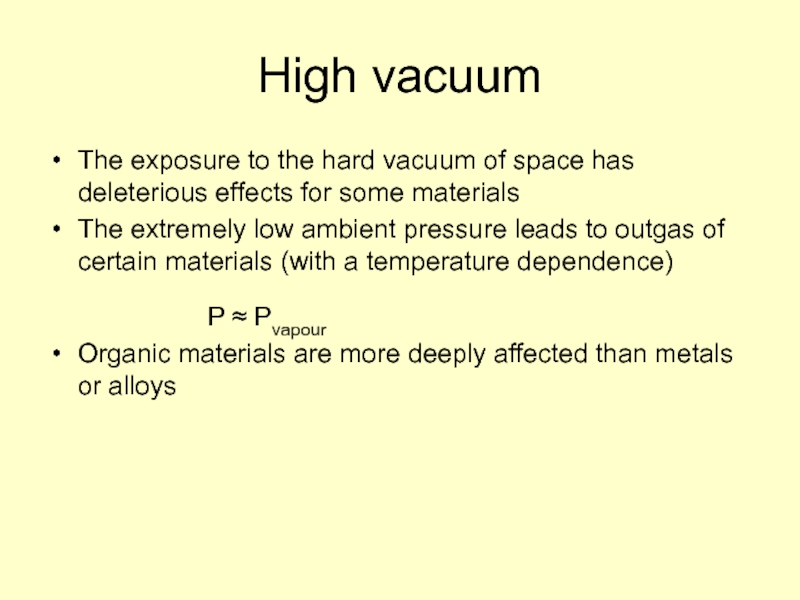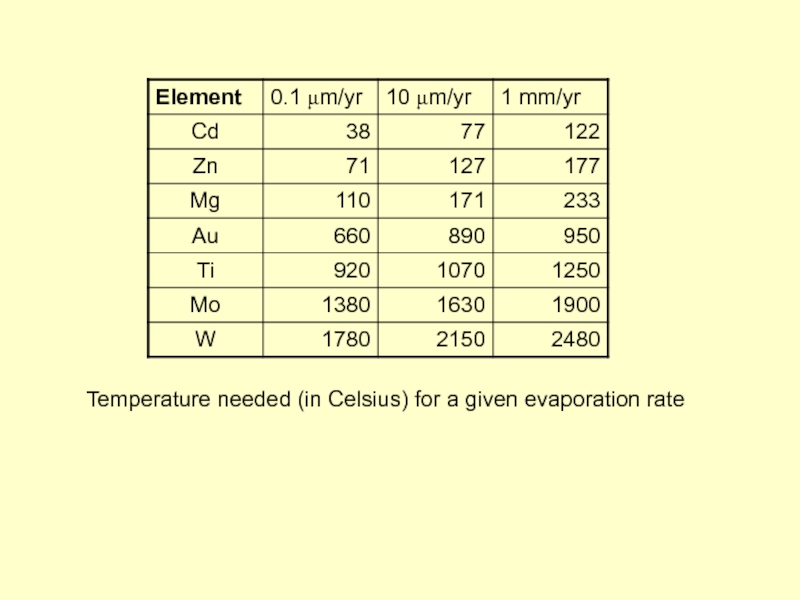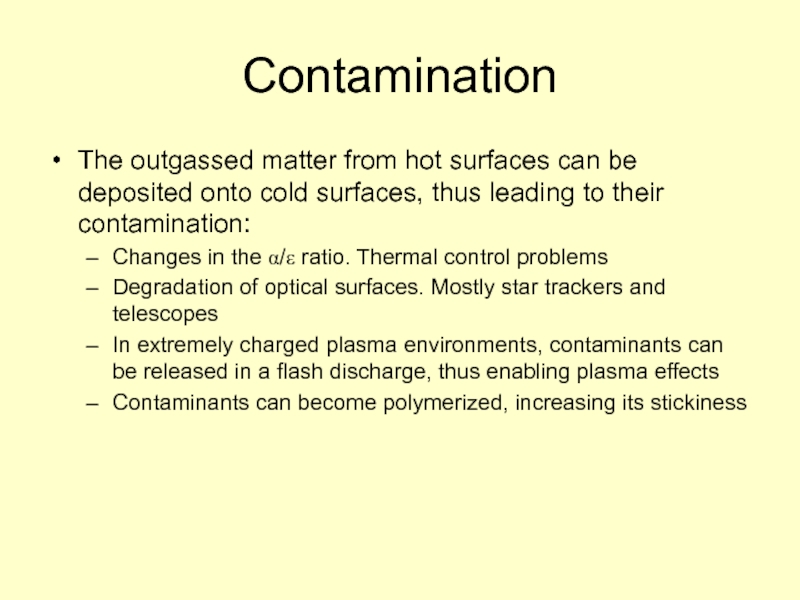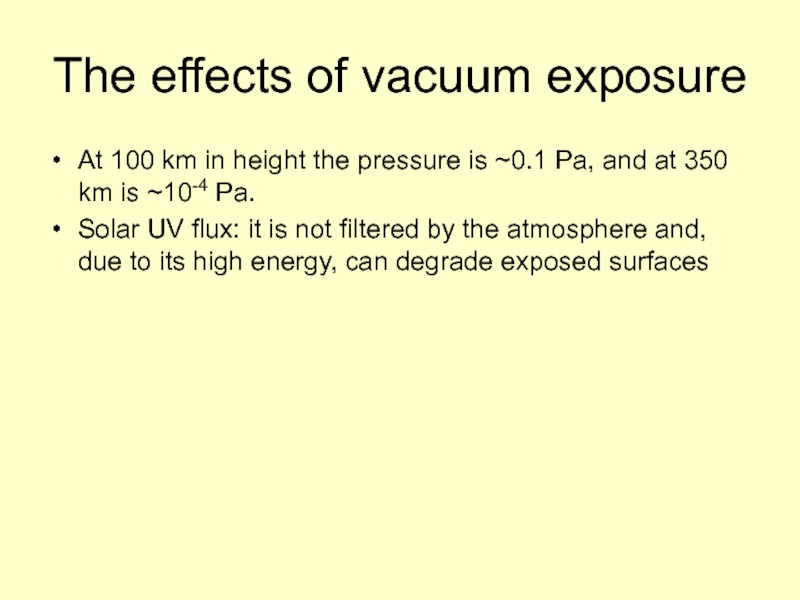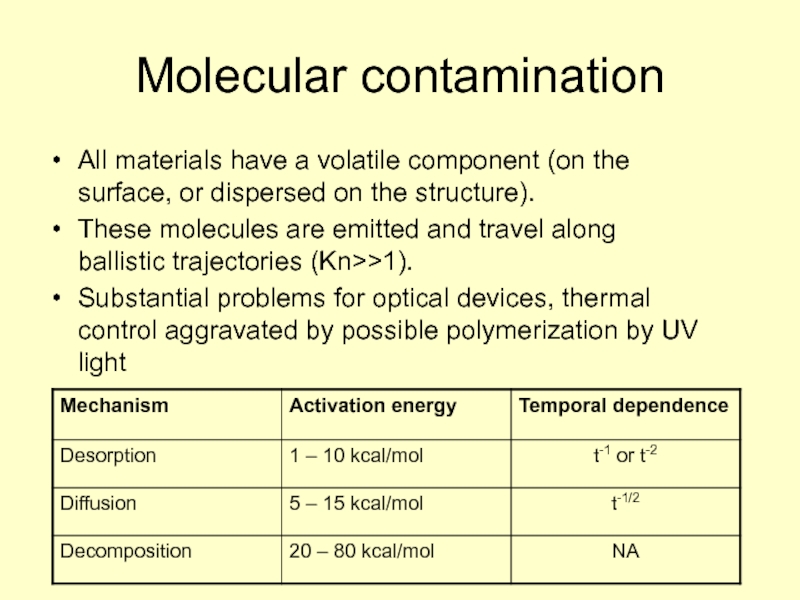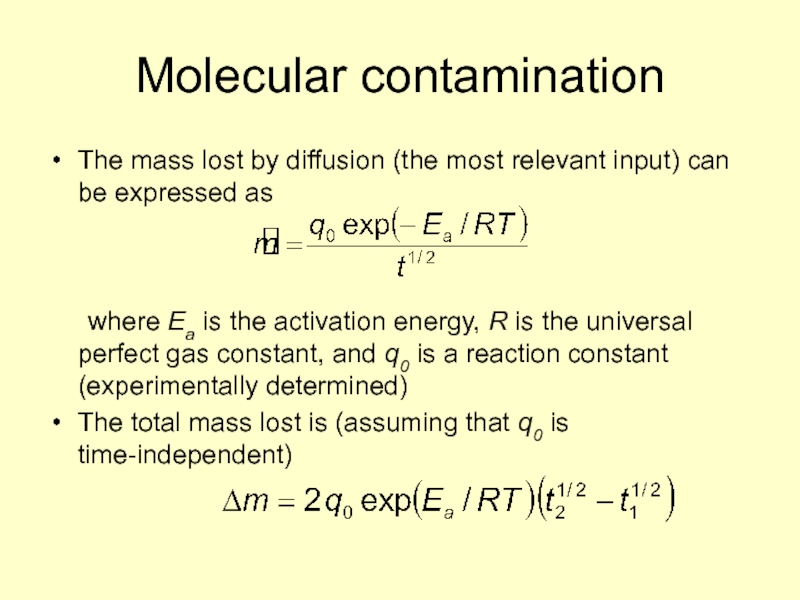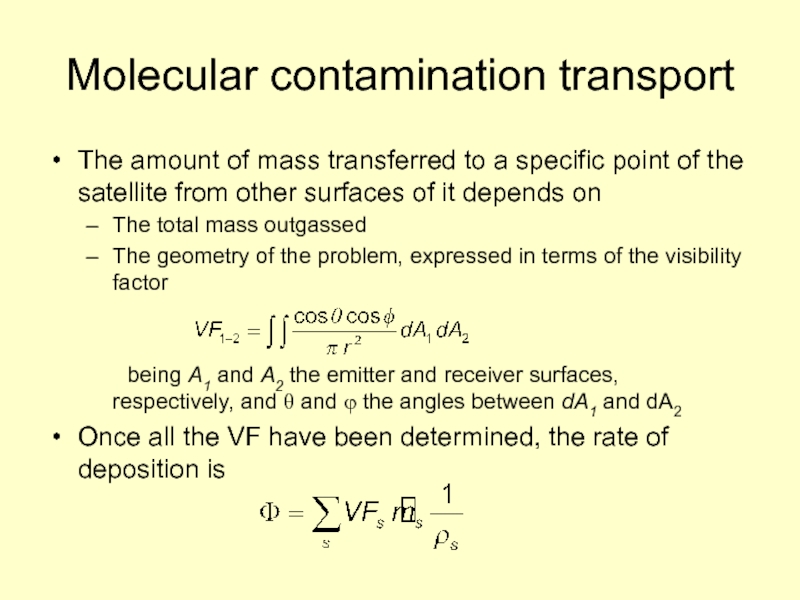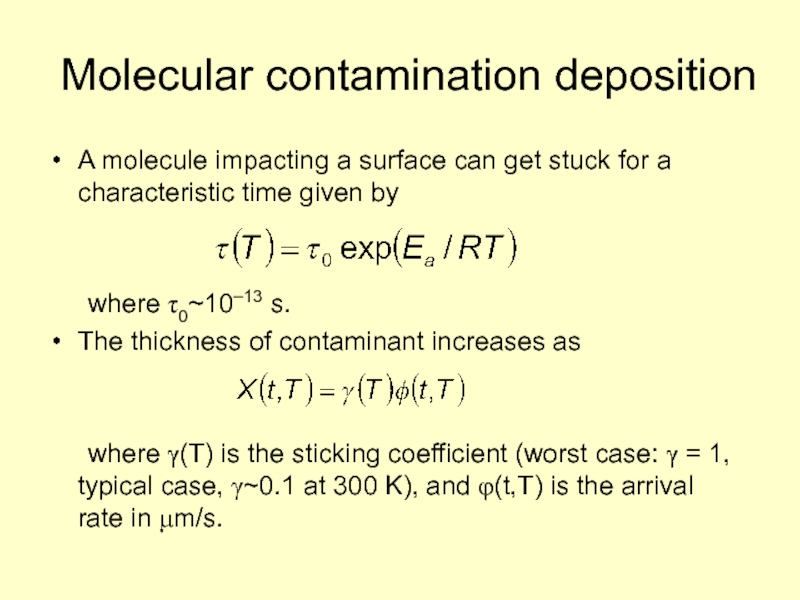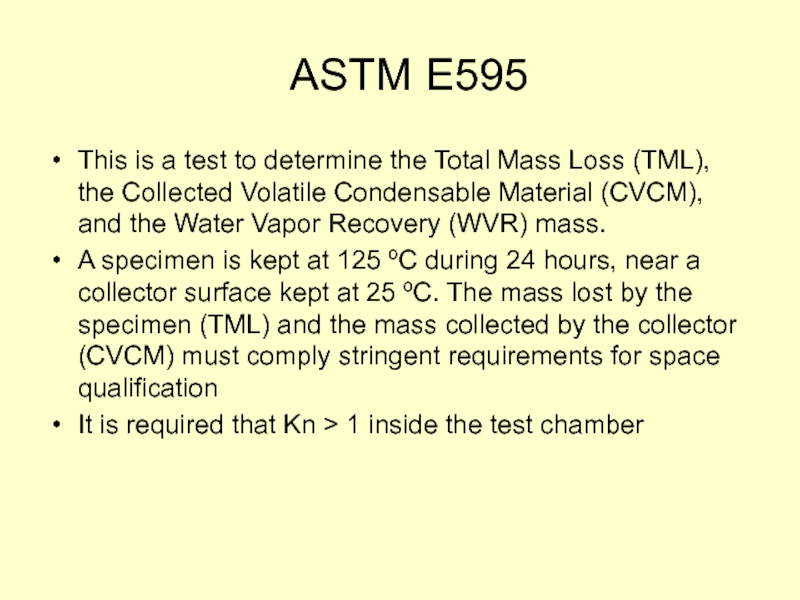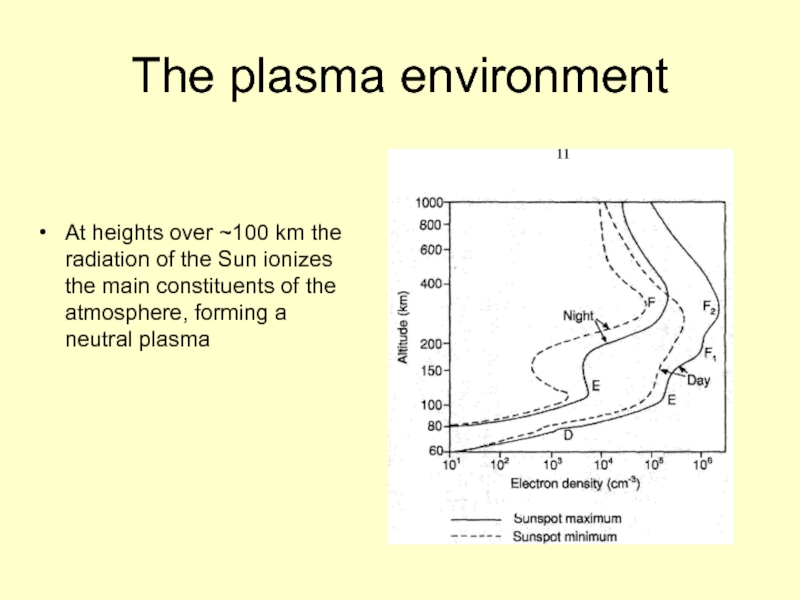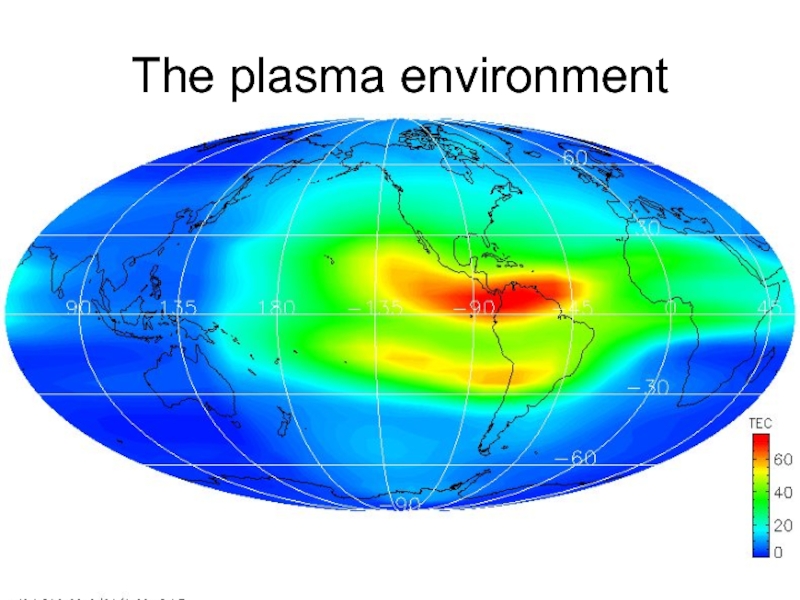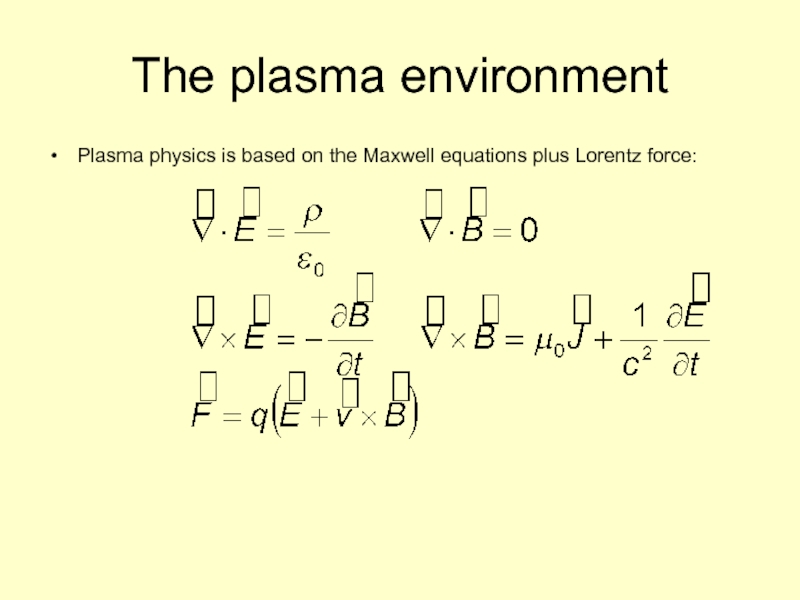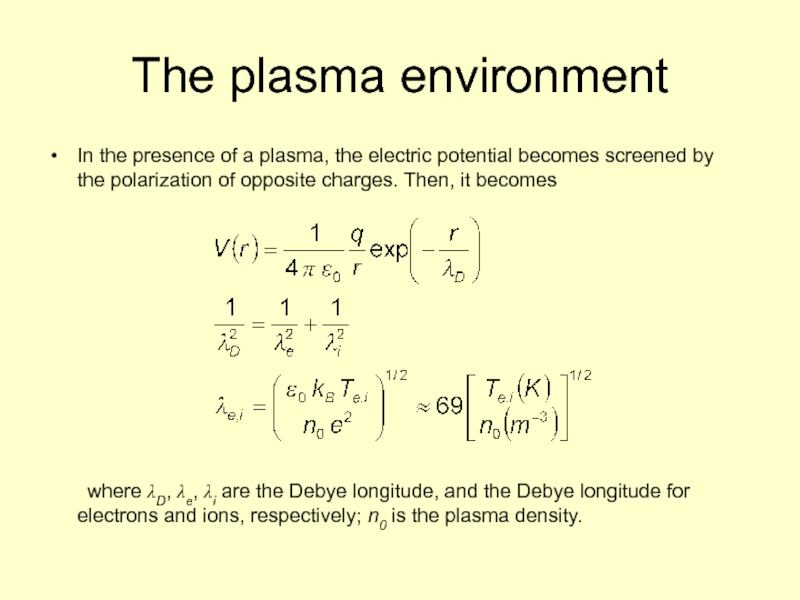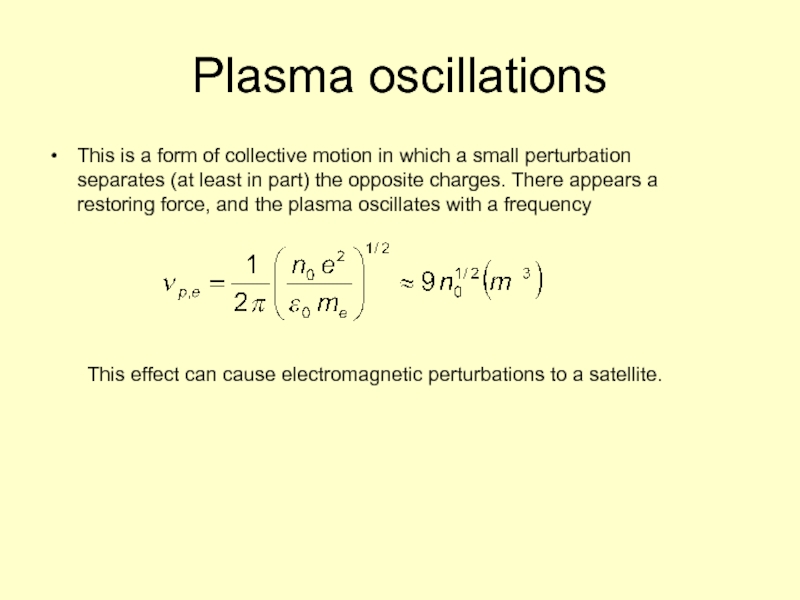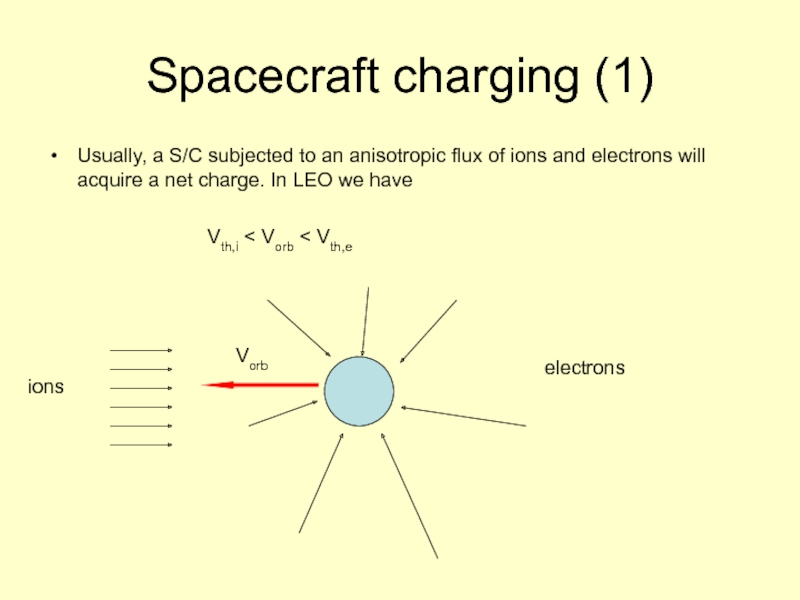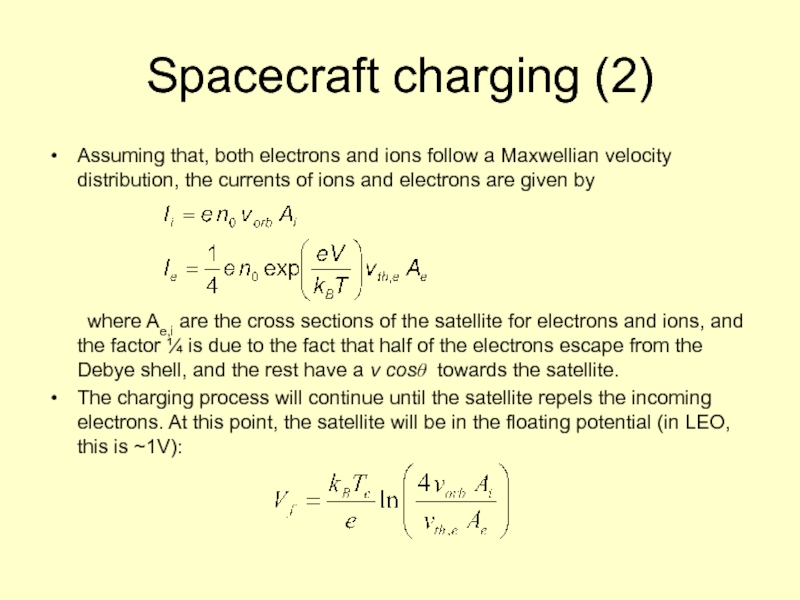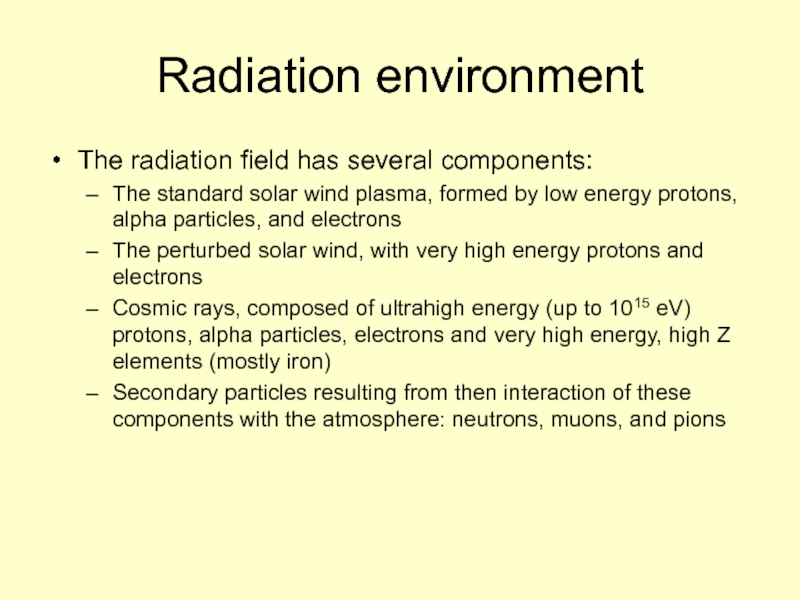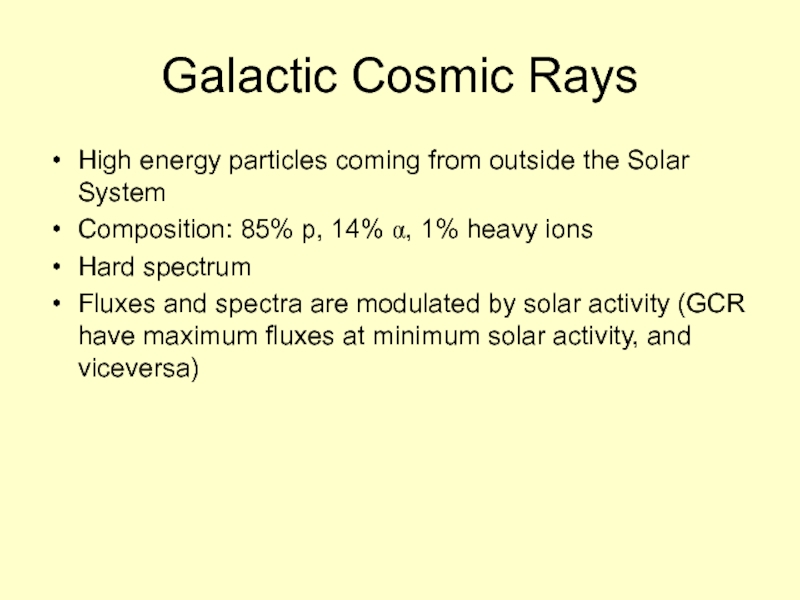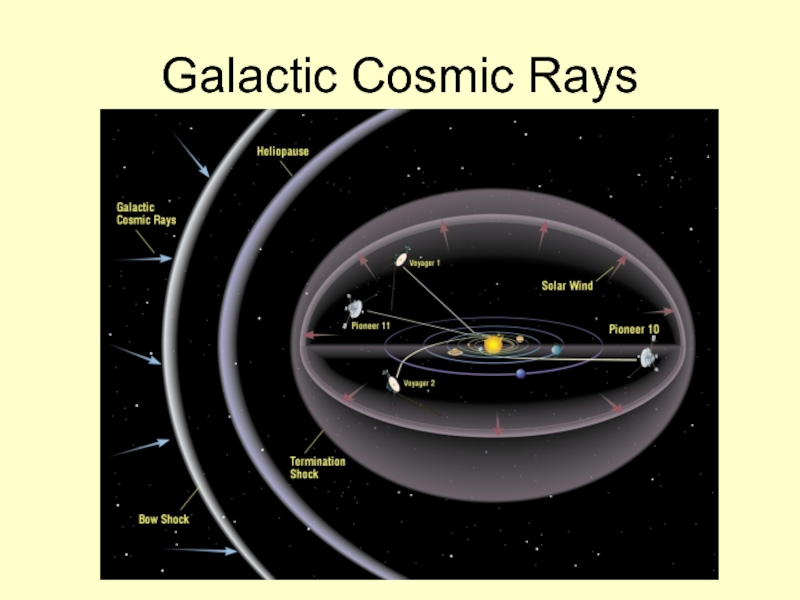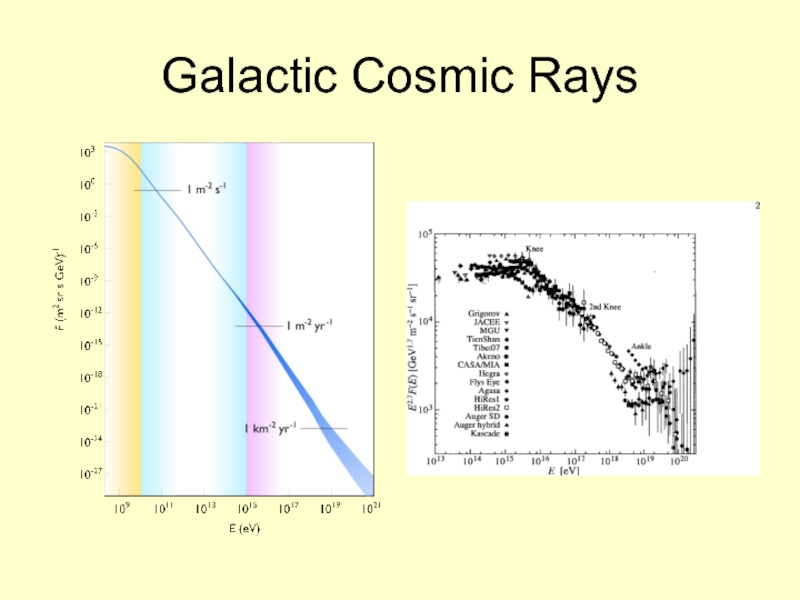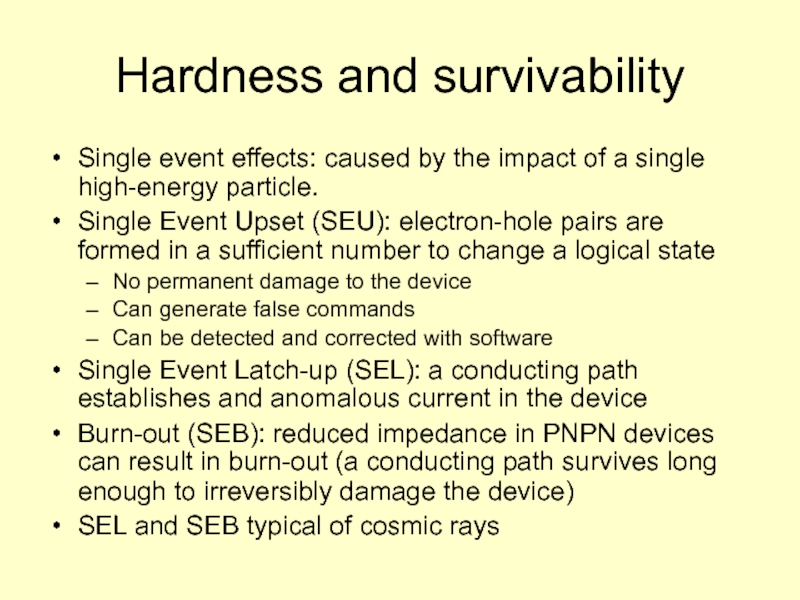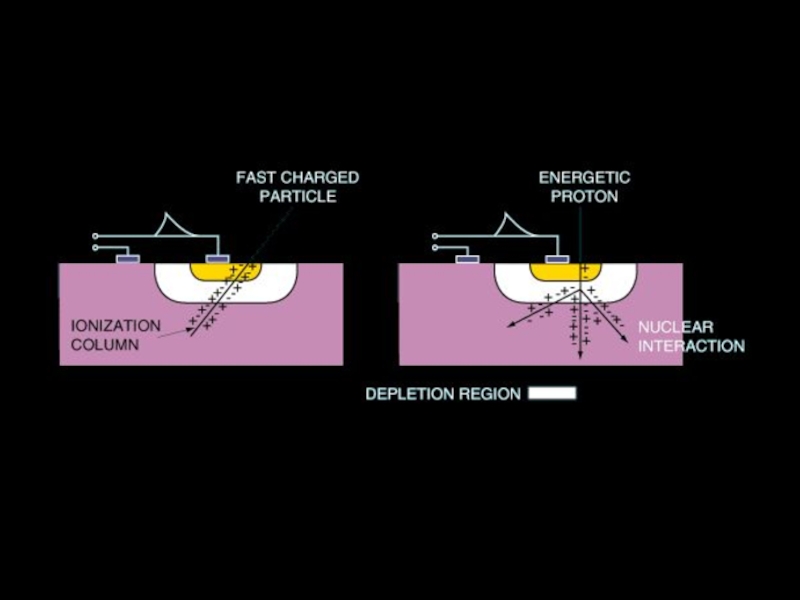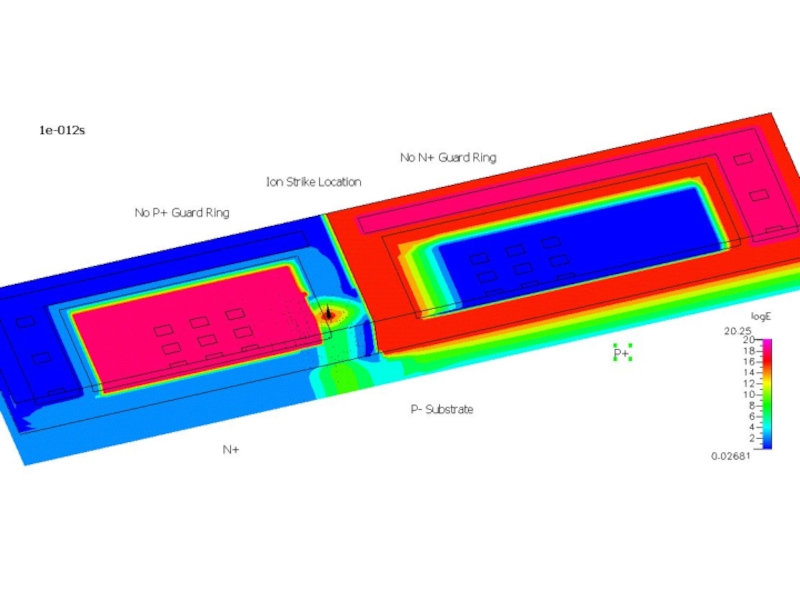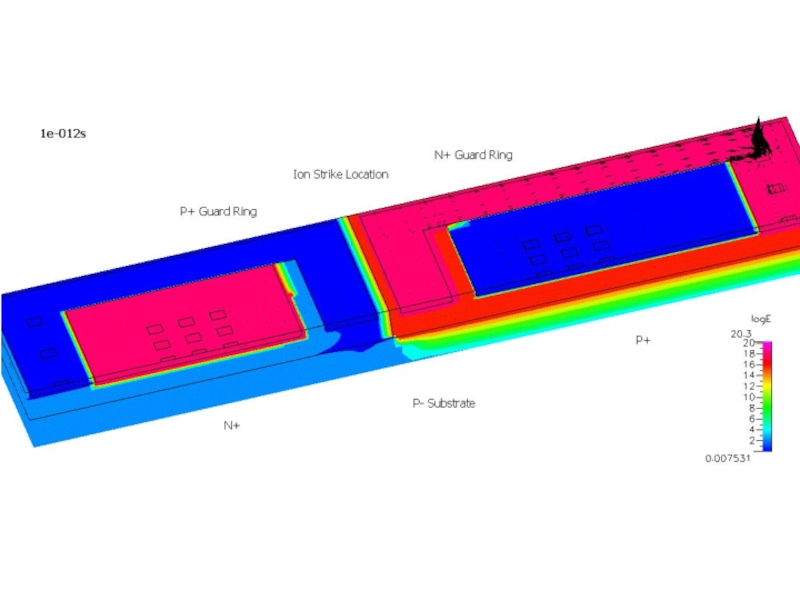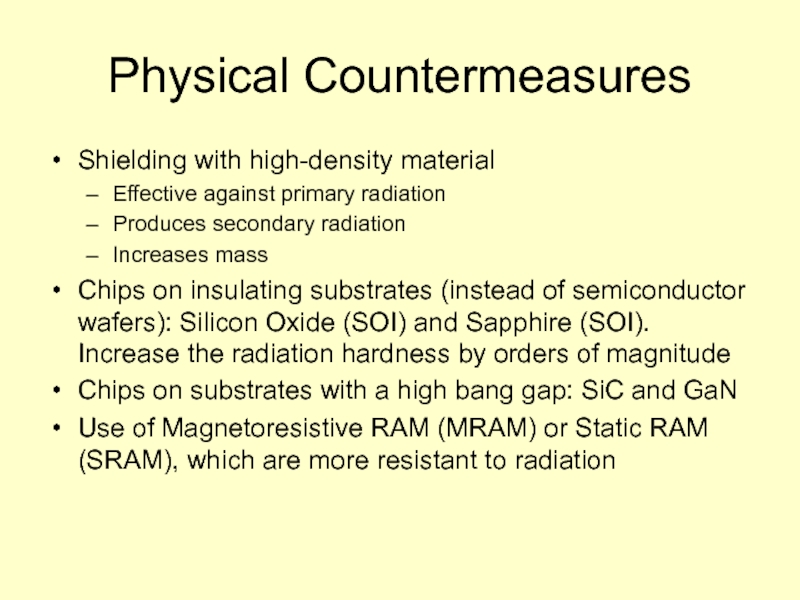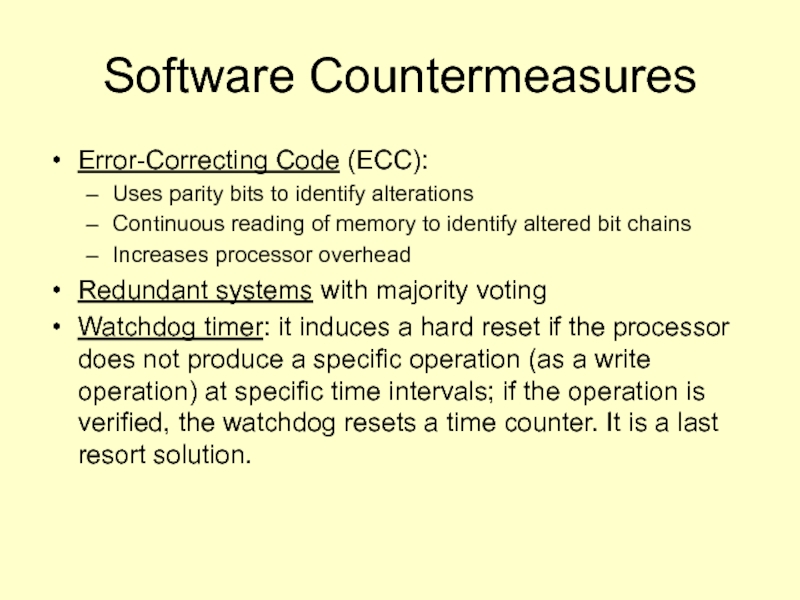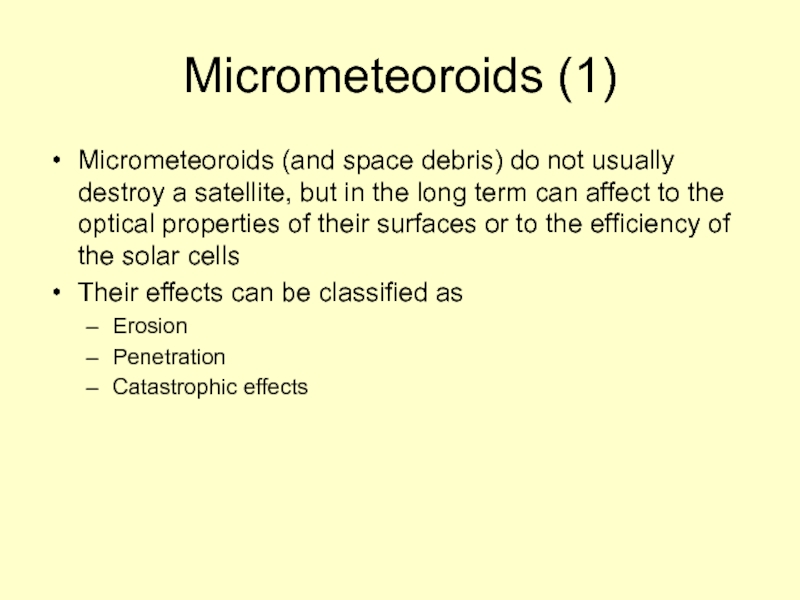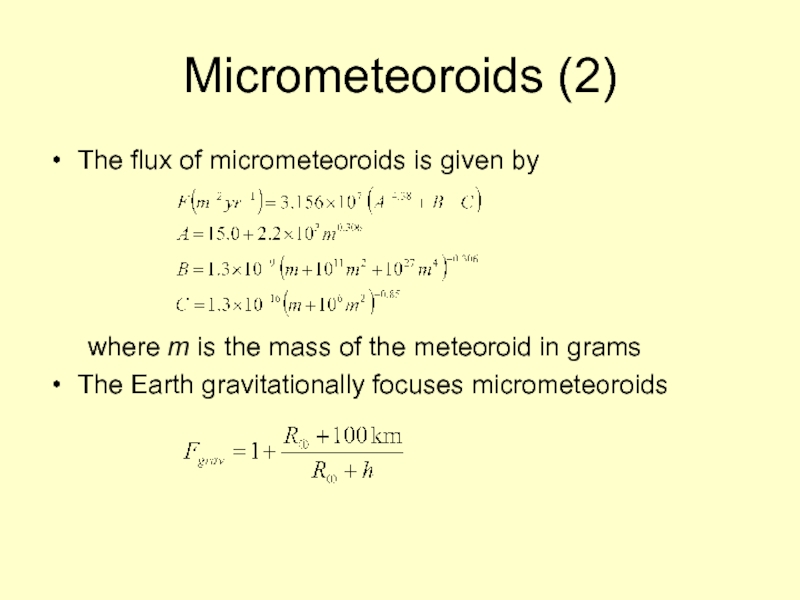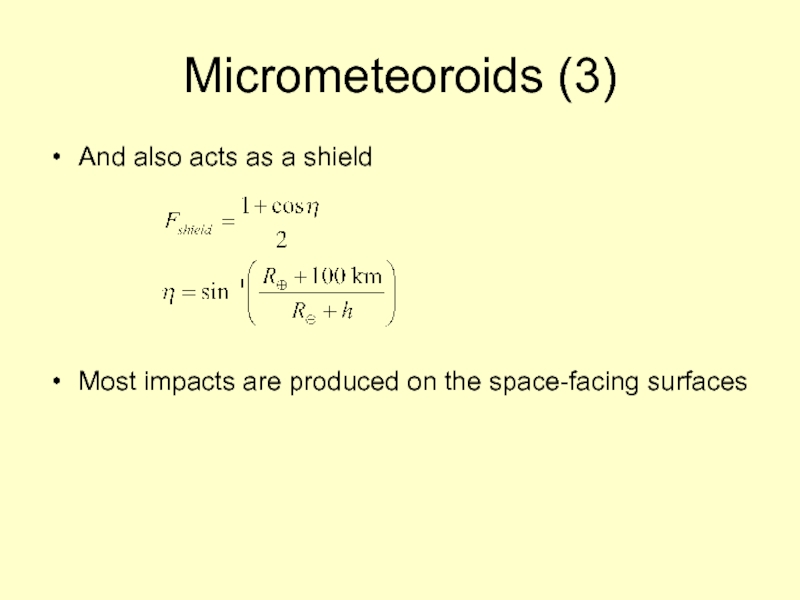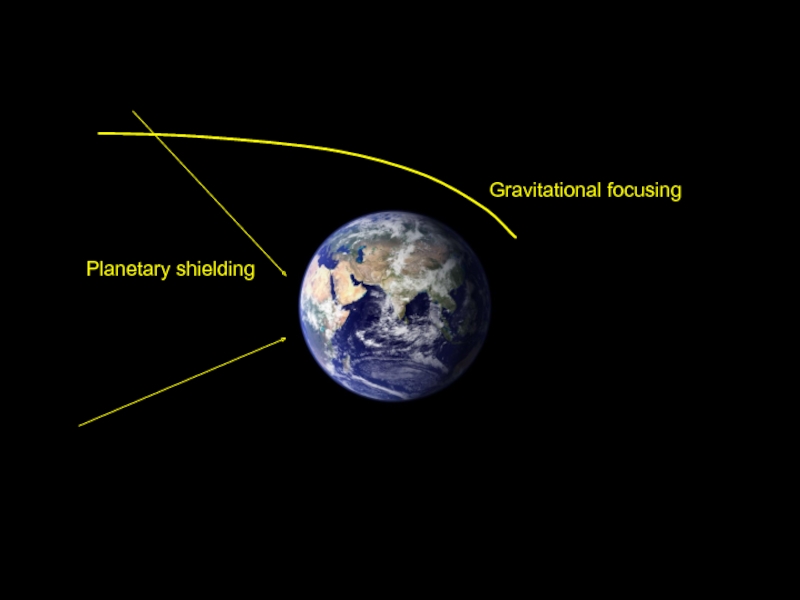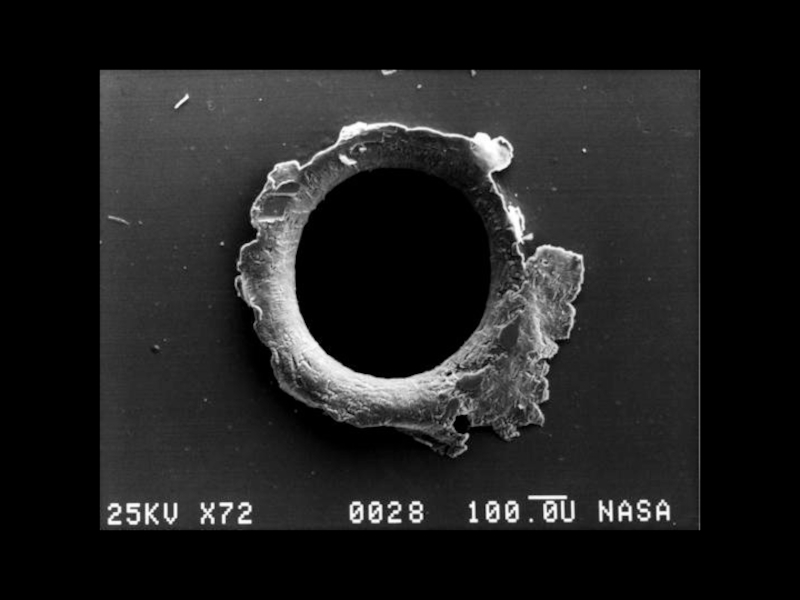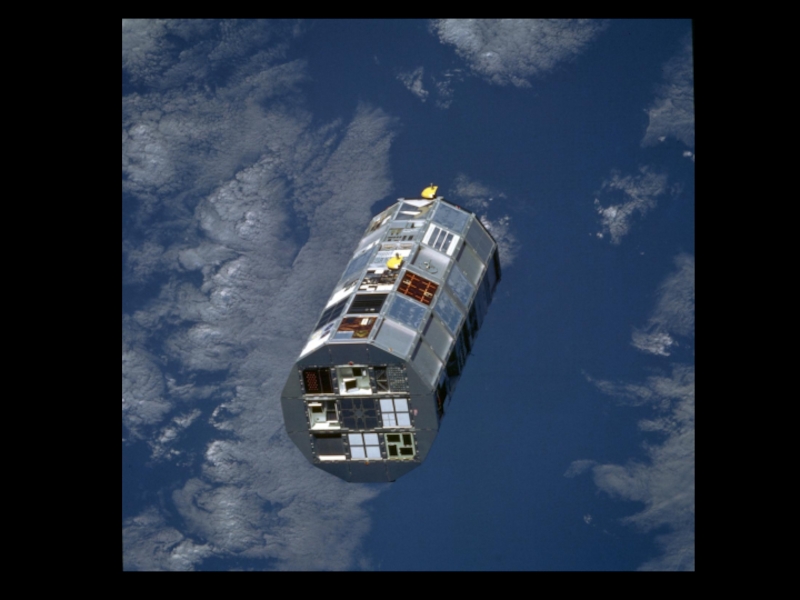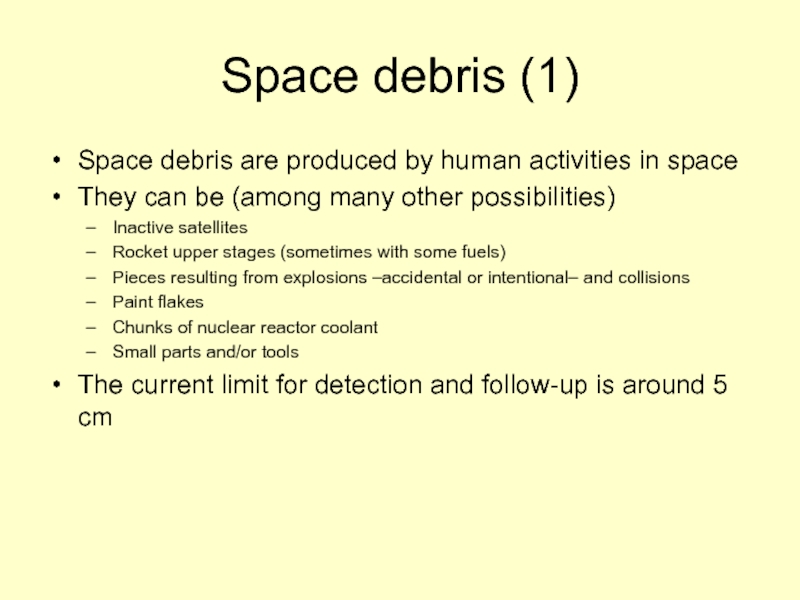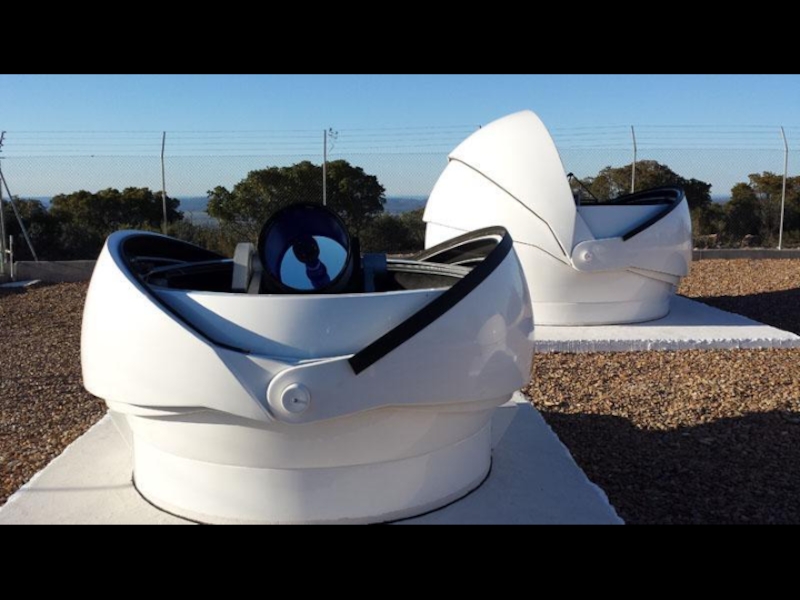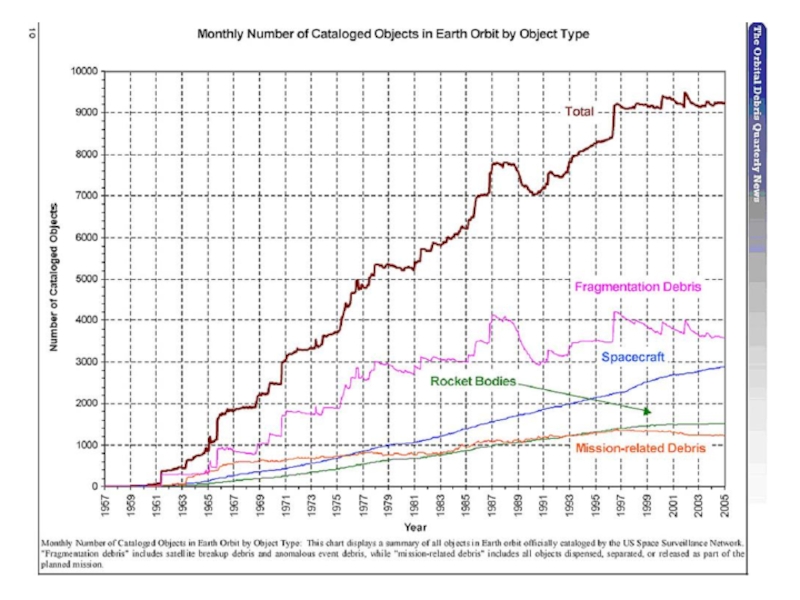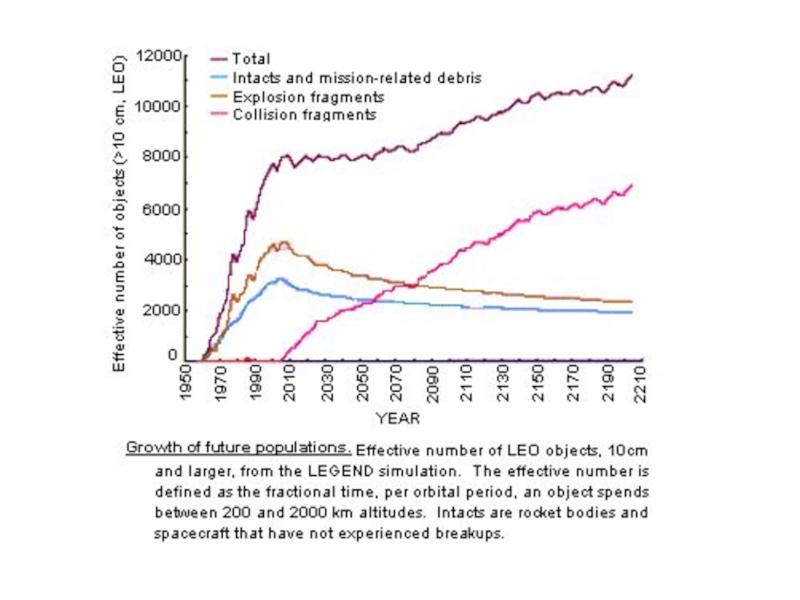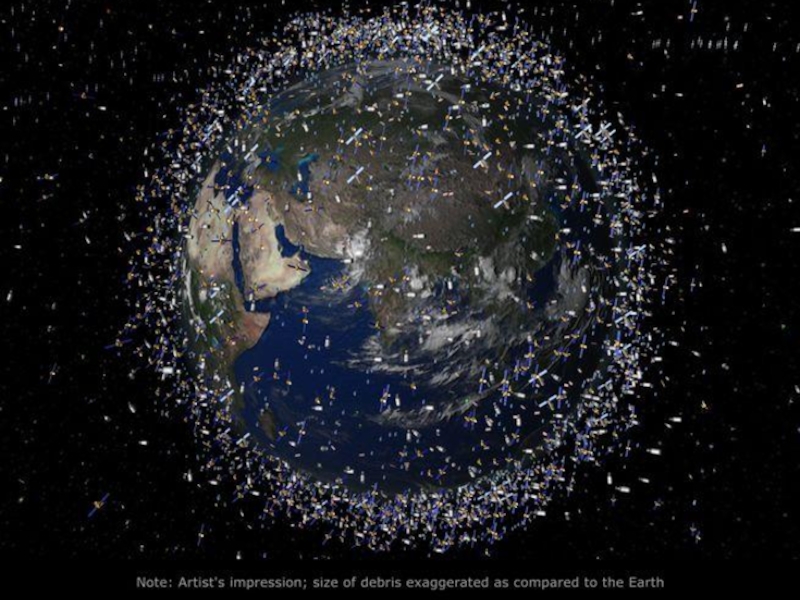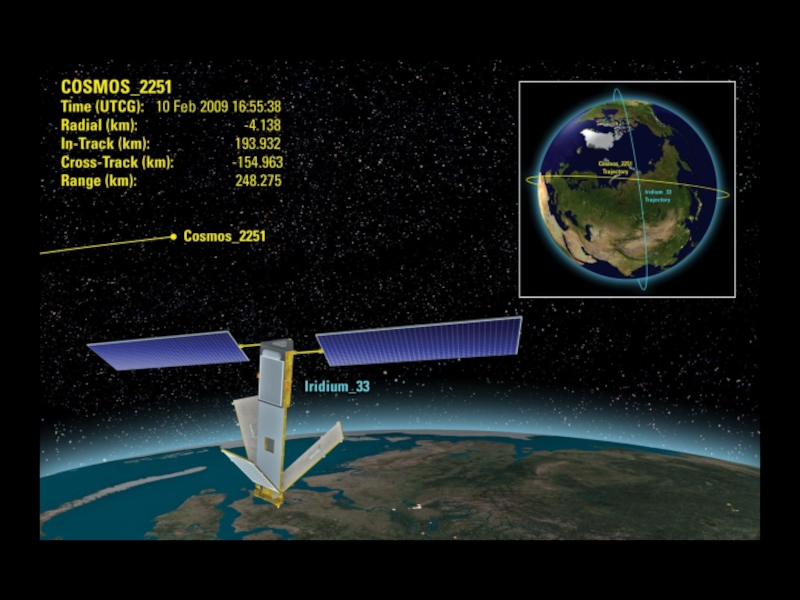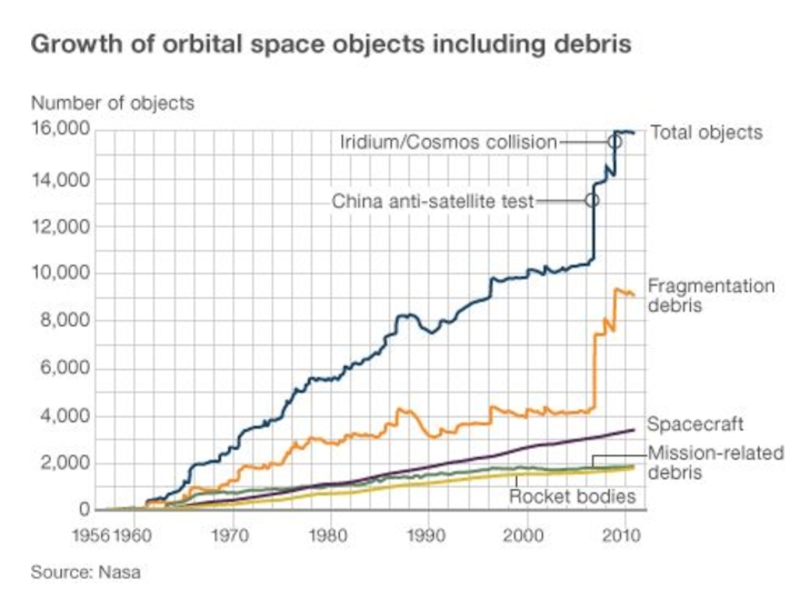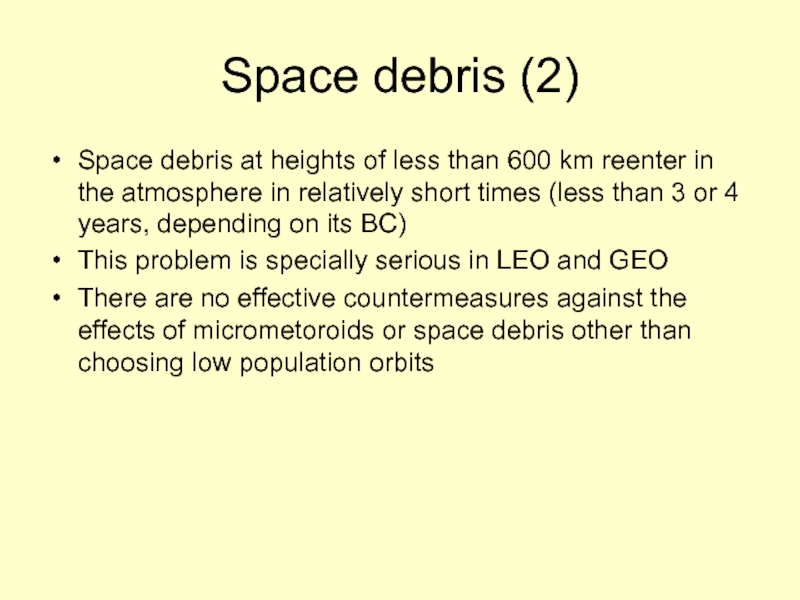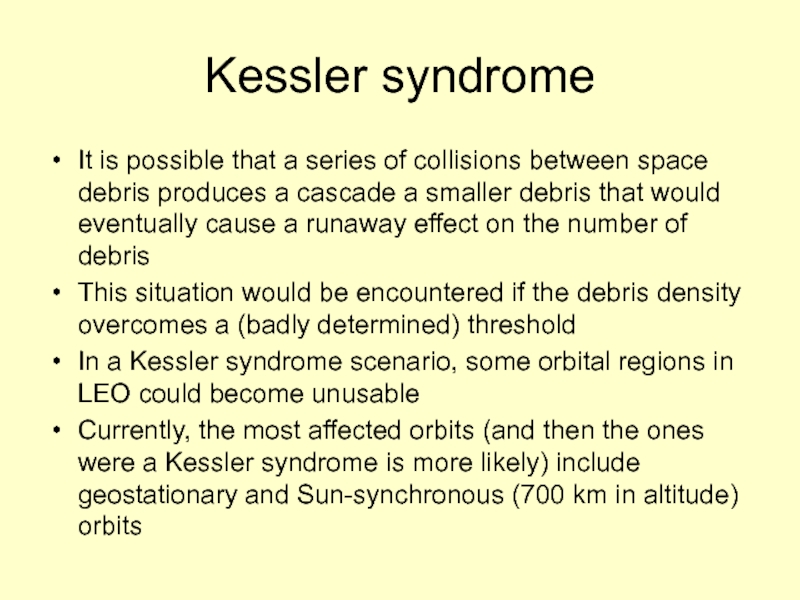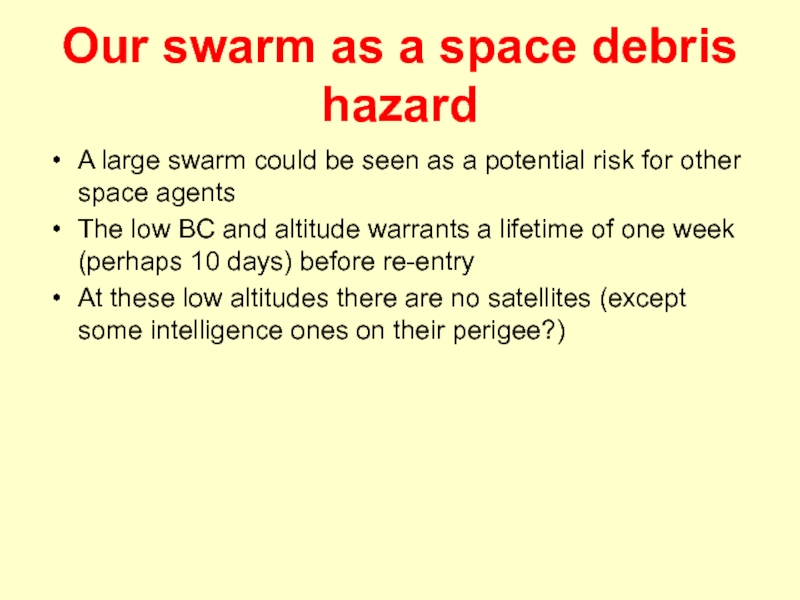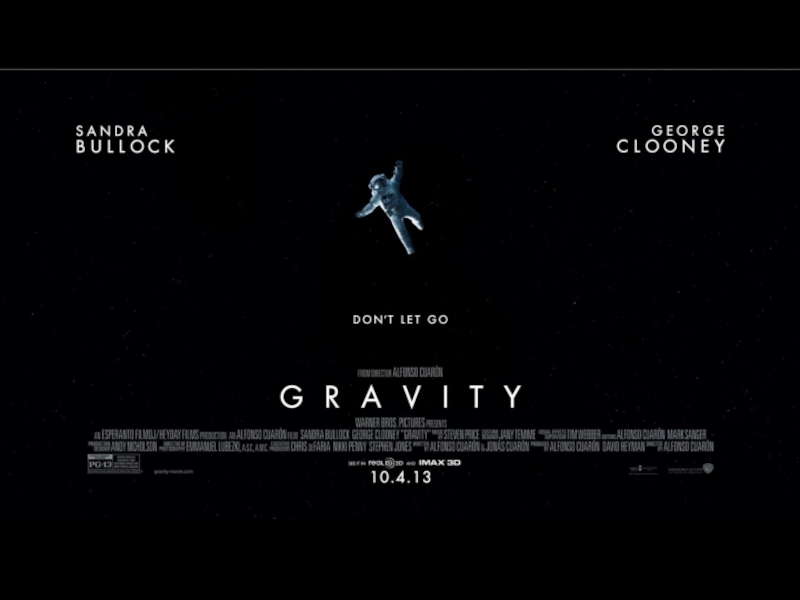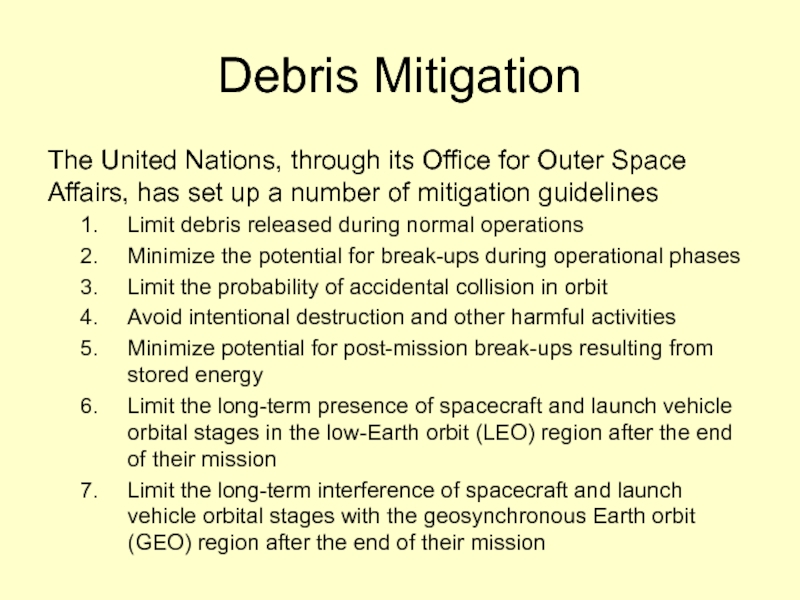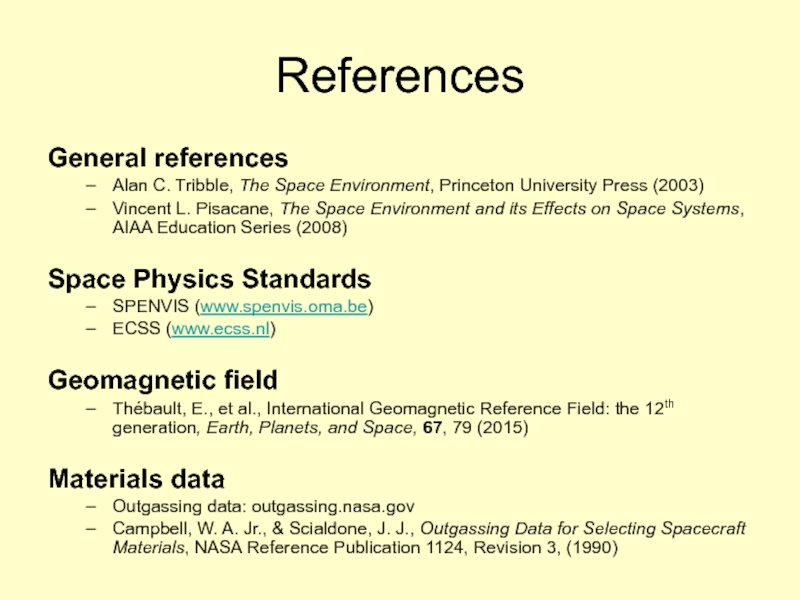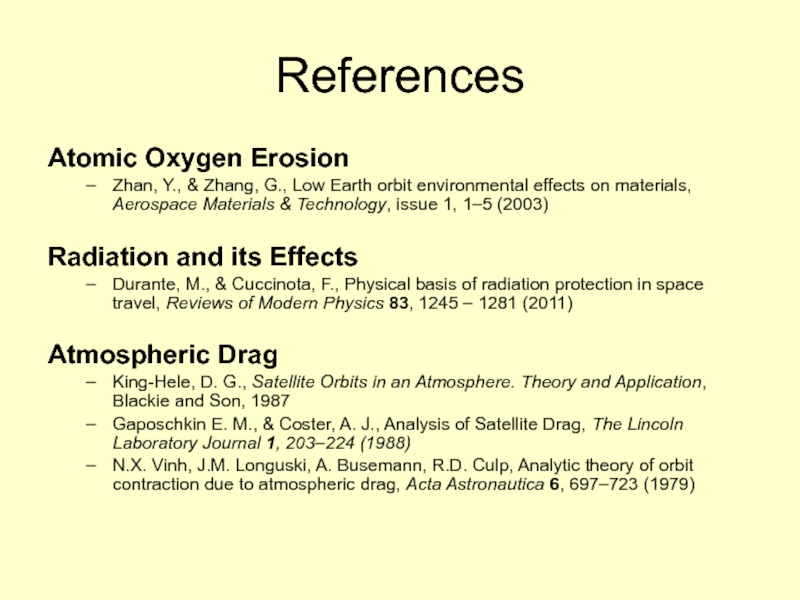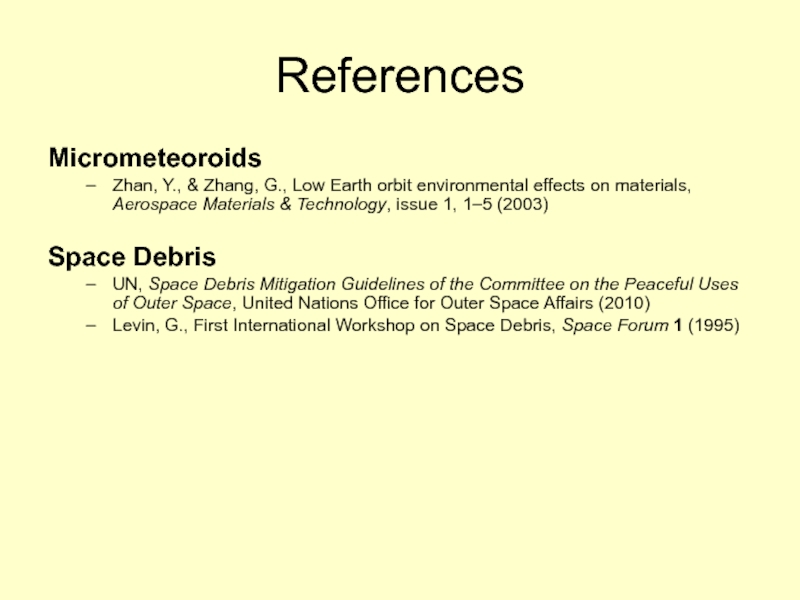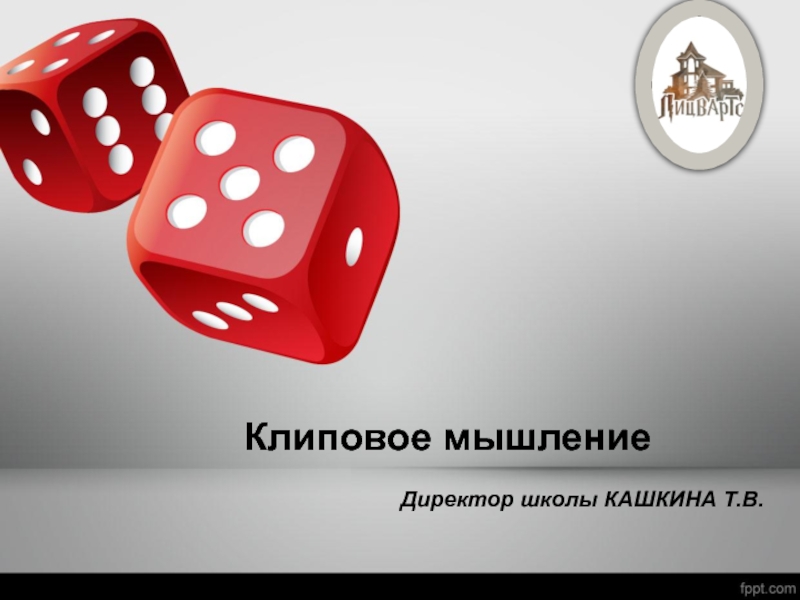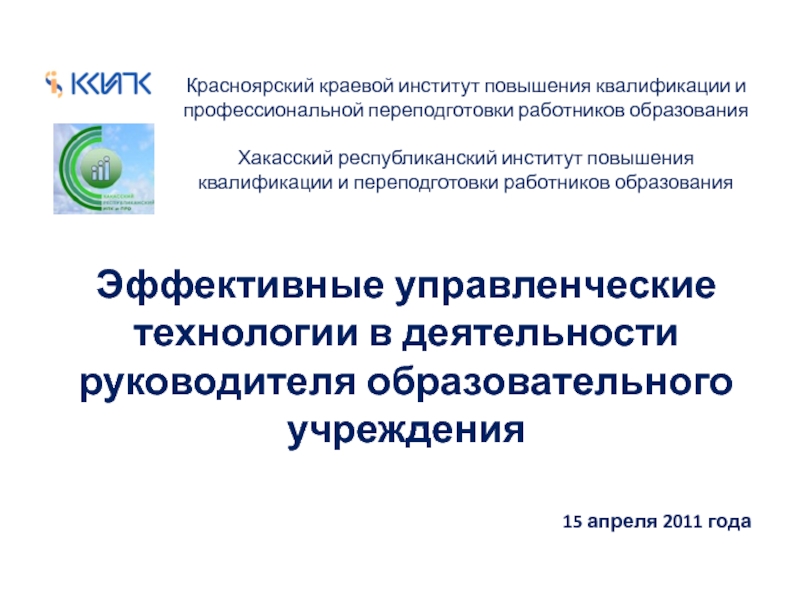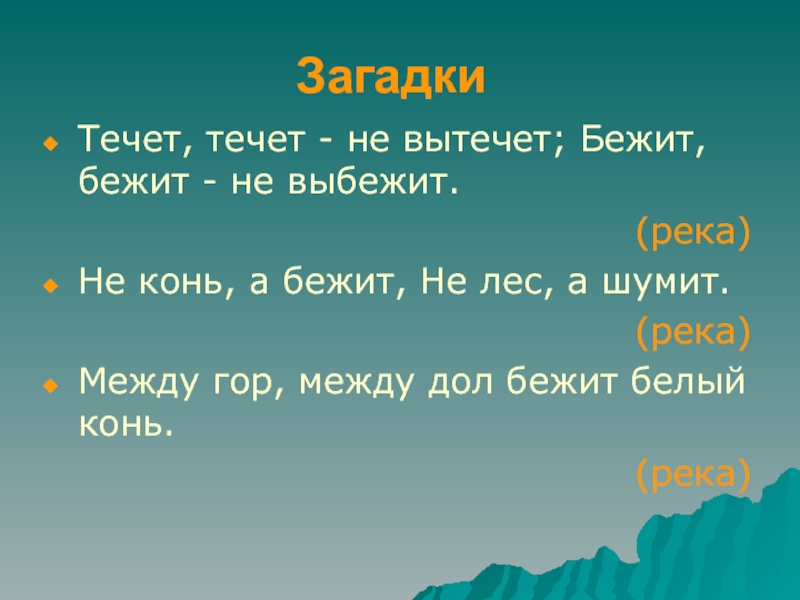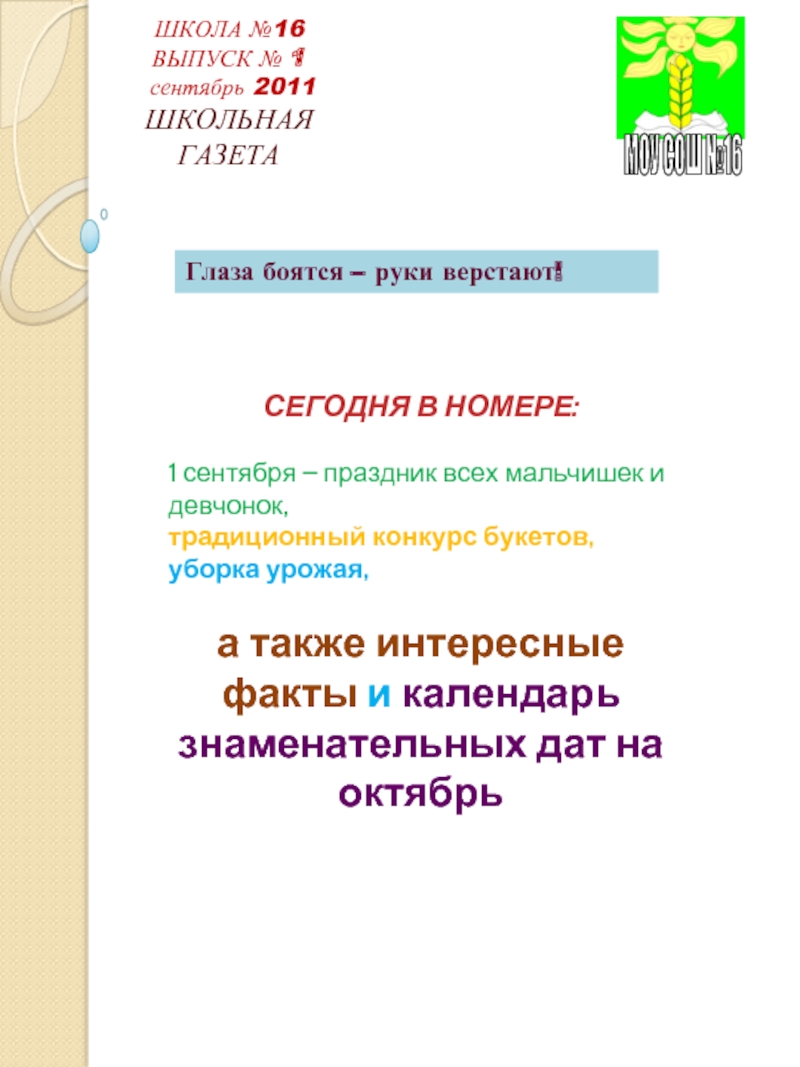- Главная
- Разное
- Дизайн
- Бизнес и предпринимательство
- Аналитика
- Образование
- Развлечения
- Красота и здоровье
- Финансы
- Государство
- Путешествия
- Спорт
- Недвижимость
- Армия
- Графика
- Культурология
- Еда и кулинария
- Лингвистика
- Английский язык
- Астрономия
- Алгебра
- Биология
- География
- Детские презентации
- Информатика
- История
- Литература
- Маркетинг
- Математика
- Медицина
- Менеджмент
- Музыка
- МХК
- Немецкий язык
- ОБЖ
- Обществознание
- Окружающий мир
- Педагогика
- Русский язык
- Технология
- Физика
- Философия
- Химия
- Шаблоны, картинки для презентаций
- Экология
- Экономика
- Юриспруденция
Space_Environment презентация
Содержание
- 1. Space_Environment
- 2. Effects of the Space Environment There are
- 4. The gravitational field Obviously, all satellites in
- 6. Simulating microgravity Then, it is possible to
- 8. Interior of the Bremen test tower
- 11. ESA’s REXUS rocket
- 13. Gravitational field
- 16. Other celestial bodies have, obviously, different gravitational fields
- 17. The magnetosphere and radiation belts The
- 20. IGRF12
- 28. Geometry and physical explanation of trapped radiation belts
- 31. Models for radiation belts Proton models: Solar
- 32. The third van Allen belt Recently, the
- 35. The South Atlantic Anomaly The South Atlantic
- 36. Radiation Effects There are several kinds of
- 37. Images of the South Atlantic Anomaly
- 38. The effects of SAA The South Atlantic
- 40. The Solar Cycle The Sun experiences substantial
- 43. Variation of the F10.7 index throughout the last 60 years
- 44. The structure of the F10.7 peaks is highly variable and difficult to predict
- 47. The Upper Atmosphere The atmosphere has no
- 48. The Upper Atmosphere For most satellites CD
- 49. Maxwell-Boltzmann Distribution
- 50. Maxwell-Boltzmann Distribution
- 52. Knudsen number Measures whether the satellite moves
- 57. The Upper Atmosphere The Upper atmosphere is
- 58. Effects of the Upper Atmosphere Aerodynamic drag
- 60. Mass = 7 kg Apogee = 2581 km
- 61. Effects of the Upper Atmosphere Aerodynamic drag
- 62. A Swarm of Femtosatellites to Determine
- 63. Why study the thermosphere? The thermosphere extends
- 64. Similar missions POPACS (Polar Orbiting Passive Atmospheric
- 65. Direct density determination
- 66. noon midnight F10.7= 50,100,200 m=0.1 kg, CD=2.2 d=5 cm BC = 5.8 kg/m2 NRL-MSISE00 model
- 67. Our project Our plan is to set
- 68. The femtosatellite (1)
- 69. The femtosatellite (2) Omnidirectional antenna Only Tx
- 70. Electronics layout of the femtosatellite
- 71. The accelerometers The accelerometers are the heart
- 72. Accelerometer’s noise
- 73. Noon midnight F10.7= 50,100,200 Continuous line: noise
- 74. Data gathering Each femtosatellite would determine its
- 75. Thermal control
- 77. Noise sources and uncertainties Rotational state of
- 78. Open problems Launch and dispersion of a
- 79. Conclusions and future work The mission seams
- 80. Mass and power budgets
- 81. M=0.1 kg, CD=2.2 D=5 cm
- 82. The swarm as a space debris hazard
- 83. Atomic oxygen erosion (1) In the height
- 85. Atomic oxygen erosion (2) The surfaces exposed
- 86. Atomic oxygen erosion (3) The RE, which
- 87. Sputtering (1) The kinetic energy of atmospheric
- 88. Sputtering (2) Sputtering (in the case of
- 89. Sputtering (3) Sputtering is produced when the
- 90. Sputtering (4) The total flux of sputtered
- 91. Sputtering (5)
- 92. Sputtering (6)
- 93. High vacuum The exposure to the hard
- 94. Temperature needed (in Celsius) for a given evaporation rate
- 95. Contamination The outgassed matter from hot surfaces
- 96. The effects of vacuum exposure At 100
- 97. Molecular contamination All materials have a volatile
- 98. Molecular contamination The mass lost by diffusion
- 99. Molecular contamination transport The amount of mass
- 100. Molecular contamination deposition A molecule impacting a
- 101. ASTM E595 This is a test to
- 102. The plasma environment At heights over ~100
- 103. The plasma environment
- 104. The plasma environment Plasma physics is based on the Maxwell equations plus Lorentz force:
- 105. The plasma environment In the presence of
- 106. Plasma oscillations This is a form of
- 107. Spacecraft charging (1) Usually, a S/C subjected
- 108. Spacecraft charging (2) Assuming that, both electrons
- 109. Radiation environment The radiation field has several
- 110. Galactic Cosmic Rays High energy particles coming
- 111. Galactic Cosmic Rays
- 112. Galactic Cosmic Rays
- 113. Hardness and survivability Single event effects: caused
- 117. Radiation protection Charged particles can be readily
- 118. Physical Countermeasures Shielding with high-density material Effective
- 119. Software Countermeasures Error-Correcting Code (ECC): Uses parity
- 120. Micrometeoroids (1) Micrometeoroids (and space debris) do
- 121. Micrometeoroids (2) The flux of micrometeoroids is
- 122. Micrometeoroids (3) And also acts as a
- 123. Gravitational focusing Planetary shielding
- 126. Space debris (1) Space debris are produced
- 133. Space debris (2) Space debris at heights
- 134. Kessler syndrome It is possible that a
- 135. Our swarm as a space debris hazard
- 137. Debris Mitigation The United Nations, through its
- 138. References General references Alan C. Tribble, The
- 139. References Atomic Oxygen Erosion Zhan, Y., &
- 140. References Micrometeoroids Zhan, Y., & Zhang, G.,
Слайд 1The Space Environment
Dr. Jordi L. Gutiérrez
Department of Physics
Universitat Politècnica de Catalunya
Samara
May 23-24, 2018
Слайд 2Effects of the Space Environment
There are several phenomena that have a
Microgravity
Van Allen belts
High altitude atmosphere
High vacuum
Solar radiation (thermal control subsystem)
Ionizing radiation
A single energetic particle can produce a single event phenomenon that seriously affects electronics
Слайд 4The gravitational field
Obviously, all satellites in orbit around the Earth (or
The reason for them being n microgravity conditions is that they are in free-fall (equivalence principle), as was noted by Newton
Слайд 6Simulating microgravity
Then, it is possible to simulate microgravity by letting fall
Drop towers
Parabolic flights
Small rockets
This is always an approximation, and the duration of these tests is rather limited (from seconds to minutes)
Слайд 17The magnetosphere and
radiation belts
The Earth is surrounded by radiation belts
The magnetic field of the Earth is roughly a magnetic dipole
Magnetic L shells defined by R ≈ L cos2λ
Inner belt populated by high energy protons and electrons
Outer belts populated only by high energy electrons
The origin of these energetic particles is the Sun
Its particle density and spectrum are highly dependent on the Solar Cycle
Also contributions by cosmic rays (rarer, but with very hard energetic spectrum)
Слайд 31Models for radiation belts
Proton models:
Solar minimum: AP8MIN
Solar Maximum: AP8MAX
Electron models
Solar minimum: AE8MIN
Solar
http://nssdcftp.gsfc.nasa.gov/models/radiation_belt/radbelt/
http://www.spenvis.oma.be (requires free registration)
Слайд 32The third van Allen belt
Recently, the van Allen probes have discovered
Слайд 35The South Atlantic Anomaly
The South Atlantic Anomaly is due to a
The magnetic field of the Earth is off-center (by about 500 km)
The magnetic axis is tilted 11 deg with respect to the rotation axis of the Earth
Слайд 36Radiation Effects
There are several kinds of SEEs
Single event upsets (SEU): a
Single event latchup (SEL): a PNPN device becomes shorted until it is power-cycled. The part may fail if the anomalous current is going on for a sufficiently long time
Single event transient (SET): the charge produced in an ionization event is collected and travels along the circuit
Single event burnout (SEB): the ionization and anomalous currents are intense enough to cause a permanent damage
Слайд 38The effects of SAA
The South Atlantic Anomaly is due to a
The magnetic field of the Earth is off-center
The magnetic axis is tilted with respect to the rotation axis of the Earth
The SAA is specially relevant for satellites in low orbit with inclination between 35º and 60º
No way to avoid the SAA
Increased number of p have important effect of radiation doses
Слайд 40The Solar Cycle
The Sun experiences substantial changes in its activity with
Increased number of sunspots
Increased number of energetic particle ejection
Increase in the mean energy of particles
The activity is measured through the radiation intensity measured at a wavelength of 10.7 cm
Слайд 47The Upper Atmosphere
The atmosphere has no clear limits in height (but
Chemical species varies with height and solar activity
Satellites decay by atmospheric drag if initial orbit is less than 1000 km at perigee
One of the most popular models is MSISE90
Слайд 48The Upper Atmosphere
For most satellites CD ≈ 1.90 – 2.60
The presence
Vorb
Слайд 52Knudsen number
Measures whether the satellite moves in a continuum medium (Kn
It is defined as
where λ is the mean free path (given above for a Maxwell-Boltzmann distribution) and L is the typical dimension of the satellite.
In LEO Kn >> 1 always
Слайд 57The Upper Atmosphere
The Upper atmosphere is affected by the intensity of
Density variations at heights of 500 to 800 km can be of a factor of 2 due to changes in solar activity
Geomagnetic activity is too short to be of much impact on satellites orbital lifetimes
The region between 120 km and 600 km belongs to the thermosphere (with T in the range 600 K to 1200 K)
Heated by XUV
Слайд 58Effects of the Upper Atmosphere
Aerodynamic drag which can lead to orbit
Depends of ballistic coefficient
Aerodynamic lift, that can interact with attitude control
Aerodynamic heating, with impact on thermal control and damages to the spacecraft at very low orbits
Chemical interactions with exposed surfaces (particularly true for the reaction of atomic oxygen with organic polymers)
Слайд 60Mass = 7 kg Apogee = 2581 km
Diameter = 3.7 m Perigee =
BC = 0.326 kg/m2 (CD=2.0) inclination = 38.8º
Слайд 61Effects of the Upper Atmosphere
Aerodynamic drag which can lead to orbit
Depends of ballistic coefficient
When solar panels have large surface, lateral drag represents a significant contribution to CD
Aerodynamic lift, that can interact with attitude control
Aerodynamic heating, with impact on thermal control and damages to the spacecraft at very low orbits
Chemical interactions with exposed surfaces (particularly true for the reaction of atomic oxygen with organic polymers)
Sputtering reactions degrade optical properties of exposed surfaces
Слайд 62
A Swarm of Femtosatellites to Determine the Density of the Lower
Carlos Lledó
Jordi L. Gutiérrez
Pilar Gil-Pons
Department of Physics
Universitat Politècnica de Catalunya
Pina 10, Sept 13–14, 2017
Universität Würzburg
Würzburg (Germany)
Слайд 63Why study the thermosphere?
The thermosphere extends from 90 to approximately 600
The region of interest for this mission is the lower thermosphere, between 100 and 250 km
It is badly known, as there are (almost) no satellites there
The thermospheric density shows some trends difficult to understand
Secular decrease of average density (Emmert, Lean, & Picone, 2010)
The chemical composition may be changing
In the thermosphere there are fast winds (up to several hundreds of meters per second)
This region controls to a high degree the uncertainties of satellite re-entry predictions
Слайд 64Similar missions
POPACS (Polar Orbiting Passive Atmospheric Calibration Spheres)
Three 0.1 m spheres
Observed from the ground (TLE). Orbital elements changes give the density
Initial orbit: perigee at 355 km, apogee at 1455 km
QB50: in-situ measurements of the lower thermosphere by means of 50 2U and 3U CubeSats (36 launched so far)
Ion neutral mass spectrometer - Flux-φ-probe experiment
Multi-needle Langmuir probe
Слайд 67Our project
Our plan is to set up a swarm of tens
The swarm should be spread along many different orbital planes, and evenly distributed over each orbital plane (pearl necklace)
Given the high density of the lower thermosphere, the swarm would survive approximately for one week
Слайд 69The femtosatellite (2)
Omnidirectional antenna
Only Tx mode
No ADCS subsystem
Passive thermal control +
Very low ballistic coefficient: about 6 kg/m2
Слайд 71The accelerometers
The accelerometers are the heart of the mission.
We have identified
Слайд 73Noon
midnight
F10.7= 50,100,200
Continuous line: noise floor
dot-dashed line: twice noise floor
m=0.1 kg, CD=2.2
BC = 5.8
Слайд 74Data gathering
Each femtosatellite would determine its deceleration once per second (locations
The data would also include position and time (both obtained through the GPS)
GPS positions allow a cross-checking of accelerometer-derived density data
Approximately 400 kbit per orbit and satellite
Data downlinked to high latitude ground stations
Orbits would be polar (to cover the whole Earth)
Слайд 77Noise sources and uncertainties
Rotational state of the satellites
Non-orthogonality of the 1D
Drag coefficient: we have taken CD = 2.2 as a first guess, but it should be determined as a function of the thermospheric properties
Non-circularity of the orbit: this will induce a small but detectable acceleration. It can be corrected with GPS data
Wind velocity: the velocity and direction of thermospheric winds would affect the drag (by changing the relative velocity to the remaining atmosphere)
Gravitational field: small noise due to non-spherically symmetric gravitational field (corrected with high-precision Grace data)
Слайд 78Open problems
Launch and dispersion of a truly Earth-covering swarm
Accelerometer testing
Battery’s limited
Aerogel and its protective cover
Слайд 79Conclusions and future work
The mission seams feasible
Launch and dispersion still an
Accelerometer testing
Flatsat testing
Deployer design
Слайд 82The swarm as a space debris hazard
A large swarm could be
The low BC and altitude warrants a lifetime of one week (perhaps 10 days) before re-entry
At these low altitudes there are no satellites (except some intelligence ones on their perigee?)
Слайд 83Atomic oxygen erosion (1)
In the height range 120–800 km, the main
It is a highly reactive species, that can degrade in a matter of weeks several kind of surfaces (especially organic materials, like Kapton or Kevlar)
The mass lost by AO impacts is
being ρt the density of the target, φAO the flux (cm-2 s-1) of atomic oxygen, and RE the efficiency of the reaction (in cm3 per impacting AO).
Слайд 85Atomic oxygen erosion (2)
The surfaces exposed to AO
erosion change substantially
its
it its thermal and optical properties
Слайд 86Atomic oxygen erosion (3)
The RE, which can be a function of
Слайд 87Sputtering (1)
The kinetic energy of atmospheric molecules is high enough to
Слайд 88Sputtering (2)
Sputtering (in the case of an
intense ion beam)
Effects of sputtering
surface of the exposed
material
Слайд 89Sputtering (3)
Sputtering is produced when the impacting particles has an energy
where U is the binding energy of the target, mt the mass of one of its particles, and mi the mass of the impacting molecule.
Слайд 90Sputtering (4)
The total flux of sputtered material is given by
where φi
Слайд 93High vacuum
The exposure to the hard vacuum of space has deleterious
The extremely low ambient pressure leads to outgas of certain materials (with a temperature dependence)
P ≈ Pvapour
Organic materials are more deeply affected than metals or alloys
Слайд 95Contamination
The outgassed matter from hot surfaces can be deposited onto cold
Changes in the α/ε ratio. Thermal control problems
Degradation of optical surfaces. Mostly star trackers and telescopes
In extremely charged plasma environments, contaminants can be released in a flash discharge, thus enabling plasma effects
Contaminants can become polymerized, increasing its stickiness
Слайд 96The effects of vacuum exposure
At 100 km in height the pressure
Solar UV flux: it is not filtered by the atmosphere and, due to its high energy, can degrade exposed surfaces
Слайд 97Molecular contamination
All materials have a volatile component (on the surface, or
These molecules are emitted and travel along ballistic trajectories (Kn>>1).
Substantial problems for optical devices, thermal control aggravated by possible polymerization by UV light
Слайд 98Molecular contamination
The mass lost by diffusion (the most relevant input) can
where Ea is the activation energy, R is the universal perfect gas constant, and q0 is a reaction constant (experimentally determined)
The total mass lost is (assuming that q0 is time-independent)
Слайд 99Molecular contamination transport
The amount of mass transferred to a specific point
The total mass outgassed
The geometry of the problem, expressed in terms of the visibility factor
being A1 and A2 the emitter and receiver surfaces, respectively, and θ and φ the angles between dA1 and dA2
Once all the VF have been determined, the rate of deposition is
Слайд 100Molecular contamination deposition
A molecule impacting a surface can get stuck for
where τ0~10–13 s.
The thickness of contaminant increases as
where γ(T) is the sticking coefficient (worst case: γ = 1, typical case, γ~0.1 at 300 K), and φ(t,T) is the arrival rate in μm/s.
Слайд 101ASTM E595
This is a test to determine the Total Mass Loss
A specimen is kept at 125 ºC during 24 hours, near a collector surface kept at 25 ºC. The mass lost by the specimen (TML) and the mass collected by the collector (CVCM) must comply stringent requirements for space qualification
It is required that Kn > 1 inside the test chamber
Слайд 102The plasma environment
At heights over ~100 km the radiation of the
Слайд 105The plasma environment
In the presence of a plasma, the electric potential
where λD, λe, λi are the Debye longitude, and the Debye longitude for electrons and ions, respectively; n0 is the plasma density.
Слайд 106Plasma oscillations
This is a form of collective motion in which a
This effect can cause electromagnetic perturbations to a satellite.
Слайд 107Spacecraft charging (1)
Usually, a S/C subjected to an anisotropic flux of
Vth,i < Vorb < Vth,e
ions
electrons
Vorb
Слайд 108Spacecraft charging (2)
Assuming that, both electrons and ions follow a Maxwellian
where Ae,i are the cross sections of the satellite for electrons and ions, and the factor ¼ is due to the fact that half of the electrons escape from the Debye shell, and the rest have a v cosθ towards the satellite.
The charging process will continue until the satellite repels the incoming electrons. At this point, the satellite will be in the floating potential (in LEO, this is ~1V):
Слайд 109Radiation environment
The radiation field has several components:
The standard solar wind plasma,
The perturbed solar wind, with very high energy protons and electrons
Cosmic rays, composed of ultrahigh energy (up to 1015 eV) protons, alpha particles, electrons and very high energy, high Z elements (mostly iron)
Secondary particles resulting from then interaction of these components with the atmosphere: neutrons, muons, and pions
Слайд 110Galactic Cosmic Rays
High energy particles coming from outside the Solar System
Composition:
Hard spectrum
Fluxes and spectra are modulated by solar activity (GCR have maximum fluxes at minimum solar activity, and viceversa)
Слайд 113Hardness and survivability
Single event effects: caused by the impact of a
Single Event Upset (SEU): electron-hole pairs are formed in a sufficient number to change a logical state
No permanent damage to the device
Can generate false commands
Can be detected and corrected with software
Single Event Latch-up (SEL): a conducting path establishes and anomalous current in the device
Burn-out (SEB): reduced impedance in PNPN devices can result in burn-out (a conducting path survives long enough to irreversibly damage the device)
SEL and SEB typical of cosmic rays
Слайд 117Radiation protection
Charged particles can be readily stopped by almost any material,
Neutrons and gamma rays, being neutral, are difficult to stop. They need low Z elements (Be and H are excellent choices)
In order to avoid the high mass of the sandwiches Al/Be/Al (for example) NASA is experimenting with plastic substrates including a high amount of H. But the resistance of these organic materials to the space environment must be fully tested. This is the only possibility for small satellites
Слайд 118Physical Countermeasures
Shielding with high-density material
Effective against primary radiation
Produces secondary radiation
Increases mass
Chips
Chips on substrates with a high bang gap: SiC and GaN
Use of Magnetoresistive RAM (MRAM) or Static RAM (SRAM), which are more resistant to radiation
Слайд 119Software Countermeasures
Error-Correcting Code (ECC):
Uses parity bits to identify alterations
Continuous reading of
Increases processor overhead
Redundant systems with majority voting
Watchdog timer: it induces a hard reset if the processor does not produce a specific operation (as a write operation) at specific time intervals; if the operation is verified, the watchdog resets a time counter. It is a last resort solution.
Слайд 120Micrometeoroids (1)
Micrometeoroids (and space debris) do not usually destroy a satellite,
Their effects can be classified as
Erosion
Penetration
Catastrophic effects
Слайд 121Micrometeoroids (2)
The flux of micrometeoroids is given by
where m is the
The Earth gravitationally focuses micrometeoroids
Слайд 122Micrometeoroids (3)
And also acts as a shield
Most impacts are produced on
Слайд 126Space debris (1)
Space debris are produced by human activities in space
They
Inactive satellites
Rocket upper stages (sometimes with some fuels)
Pieces resulting from explosions –accidental or intentional– and collisions
Paint flakes
Chunks of nuclear reactor coolant
Small parts and/or tools
The current limit for detection and follow-up is around 5 cm
Слайд 133Space debris (2)
Space debris at heights of less than 600 km
This problem is specially serious in LEO and GEO
There are no effective countermeasures against the effects of micrometoroids or space debris other than choosing low population orbits
Слайд 134Kessler syndrome
It is possible that a series of collisions between space
This situation would be encountered if the debris density overcomes a (badly determined) threshold
In a Kessler syndrome scenario, some orbital regions in LEO could become unusable
Currently, the most affected orbits (and then the ones were a Kessler syndrome is more likely) include geostationary and Sun-synchronous (700 km in altitude) orbits
Слайд 135Our swarm as a space debris hazard
A large swarm could be
The low BC and altitude warrants a lifetime of one week (perhaps 10 days) before re-entry
At these low altitudes there are no satellites (except some intelligence ones on their perigee?)
Слайд 137Debris Mitigation
The United Nations, through its Office for Outer Space Affairs,
Limit debris released during normal operations
Minimize the potential for break-ups during operational phases
Limit the probability of accidental collision in orbit
Avoid intentional destruction and other harmful activities
Minimize potential for post-mission break-ups resulting from stored energy
Limit the long-term presence of spacecraft and launch vehicle orbital stages in the low-Earth orbit (LEO) region after the end of their mission
Limit the long-term interference of spacecraft and launch vehicle orbital stages with the geosynchronous Earth orbit (GEO) region after the end of their mission
Слайд 138References
General references
Alan C. Tribble, The Space Environment, Princeton University Press (2003)
Vincent
Space Physics Standards
SPENVIS (www.spenvis.oma.be)
ECSS (www.ecss.nl)
Geomagnetic field
Thébault, E., et al., International Geomagnetic Reference Field: the 12th generation, Earth, Planets, and Space, 67, 79 (2015)
Materials data
Outgassing data: outgassing.nasa.gov
Campbell, W. A. Jr., & Scialdone, J. J., Outgassing Data for Selecting Spacecraft Materials, NASA Reference Publication 1124, Revision 3, (1990)
Слайд 139References
Atomic Oxygen Erosion
Zhan, Y., & Zhang, G., Low Earth orbit environmental
Radiation and its Effects
Durante, M., & Cuccinota, F., Physical basis of radiation protection in space travel, Reviews of Modern Physics 83, 1245 – 1281 (2011)
Atmospheric Drag
King-Hele, D. G., Satellite Orbits in an Atmosphere. Theory and Application, Blackie and Son, 1987
Gaposchkin E. M., & Coster, A. J., Analysis of Satellite Drag, The Lincoln Laboratory Journal 1, 203–224 (1988)
N.X. Vinh, J.M. Longuski, A. Busemann, R.D. Culp, Analytic theory of orbit contraction due to atmospheric drag, Acta Astronautica 6, 697–723 (1979)
Слайд 140References
Micrometeoroids
Zhan, Y., & Zhang, G., Low Earth orbit environmental effects on
Space Debris
UN, Space Debris Mitigation Guidelines of the Committee on the Peaceful Uses of Outer Space, United Nations Office for Outer Space Affairs (2010)
Levin, G., First International Workshop on Space Debris, Space Forum 1 (1995)
